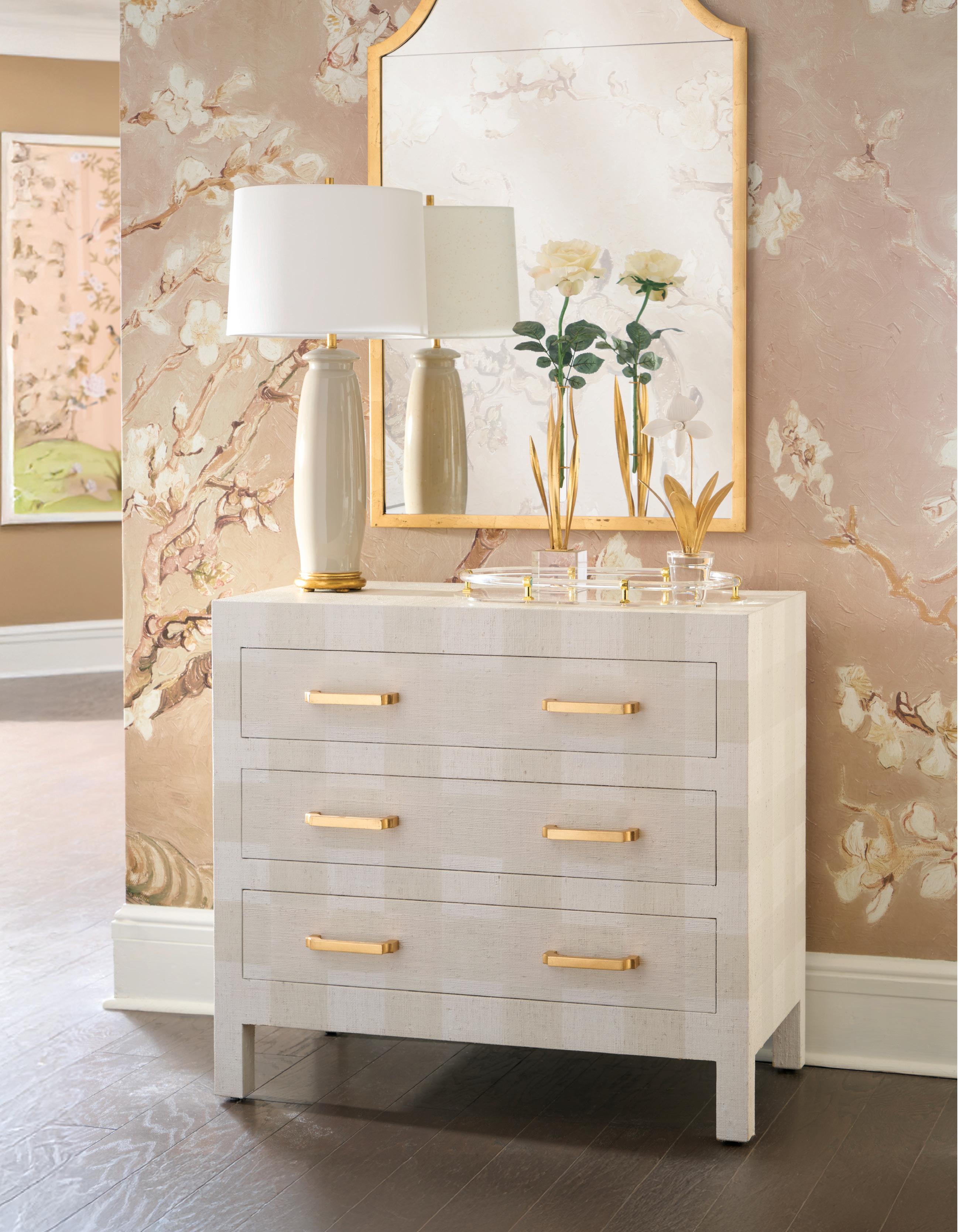

FLOWER HOUSE l GARDEN l LIFESTYLE


Century believes that style and service are personal and best provided by passionate local businesses. We are proud to be family owned and operated in Hickory, North Carolina since 1947.
centuryfurniture.com/tarashaw

Works beautifully in every room.



Ray Booth® Tectonic Collection Atlanta Bangkok Buckhead Chicago Cincinnati





www.easternaccents.com



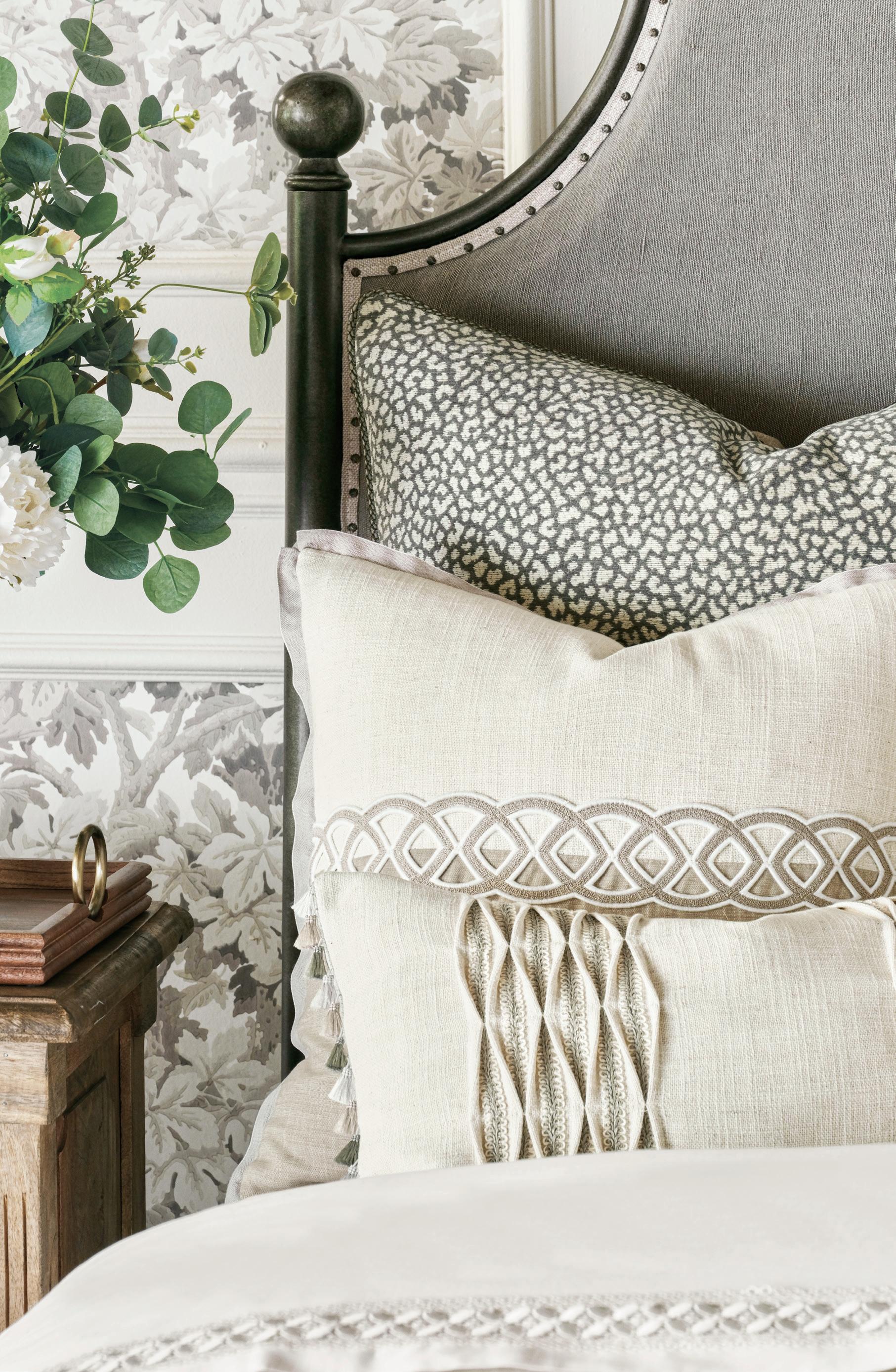
The finest in home textiles. Chicago-crafted since 1989.

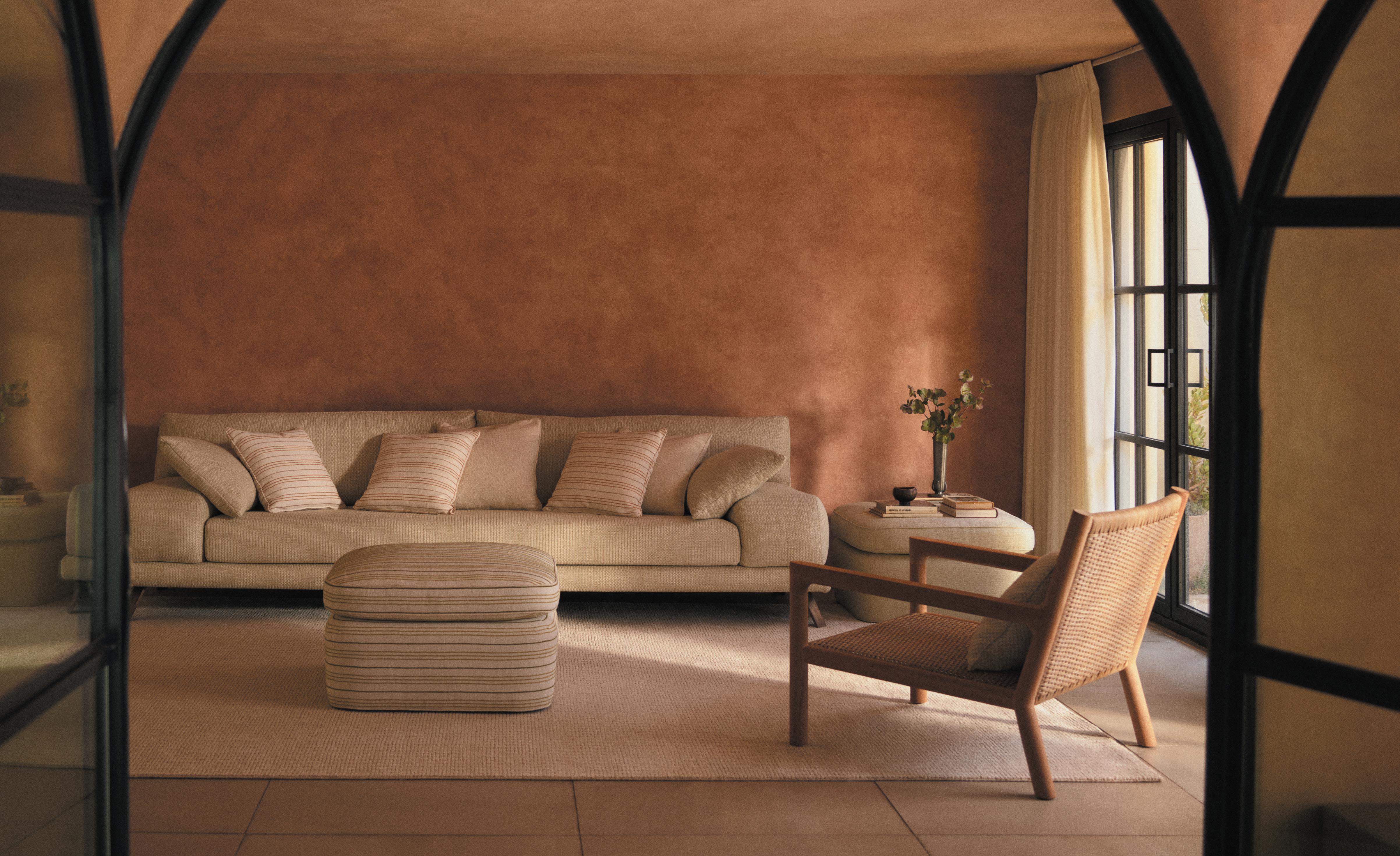

September • October 2025

92
Finding Home
A search for their ideal house took New York designers Michael Devine and Thomas Burak farther afield than originally planned, but in Virginia, they found an idyllic place to land.
104
A Saffron Soirée
Entertaining guru Jane Scott Hodges of Leontine Linens combines elements of India with Big Easy style for a festive, alfresco dinner.
110
Old-world Soul
A Houston remodel brings Mediterranean character and ageless artifacts together in a contemporary, livable home with heart.
120
Tending Nature
Anthony Bellomo thrives on cultivating community, whether home at Clove Brook Farm or in his shop, Orangerie Garden + Home, in Millbrook, New York.
ON THE COVERS
Subscriber Cover:
A corner of Thomas Burak and Michael Devine’s living room is a study in floral references with a 19th-century still-life painting, antique French chair upholstered in citron damask, and a towering arrangement of dried hydrangeas from their garden.
Newsstand Cover:
In Thomas Burak and Michael Devine’s living room, cosmos cut from the garden lighten the formality of blue-and-white porcelain, altar candlesticks, and an 18th-century embroidered textile.
Both photographed by Erik Kvalsvik
“Just living isn’t enough,” said the butterfly. “One must also have sunshine, freedom, and a little flower.” —HANS CHRISTIAN ANDERSEN
BY
PHOTO
ANNIE SCHLECHTER
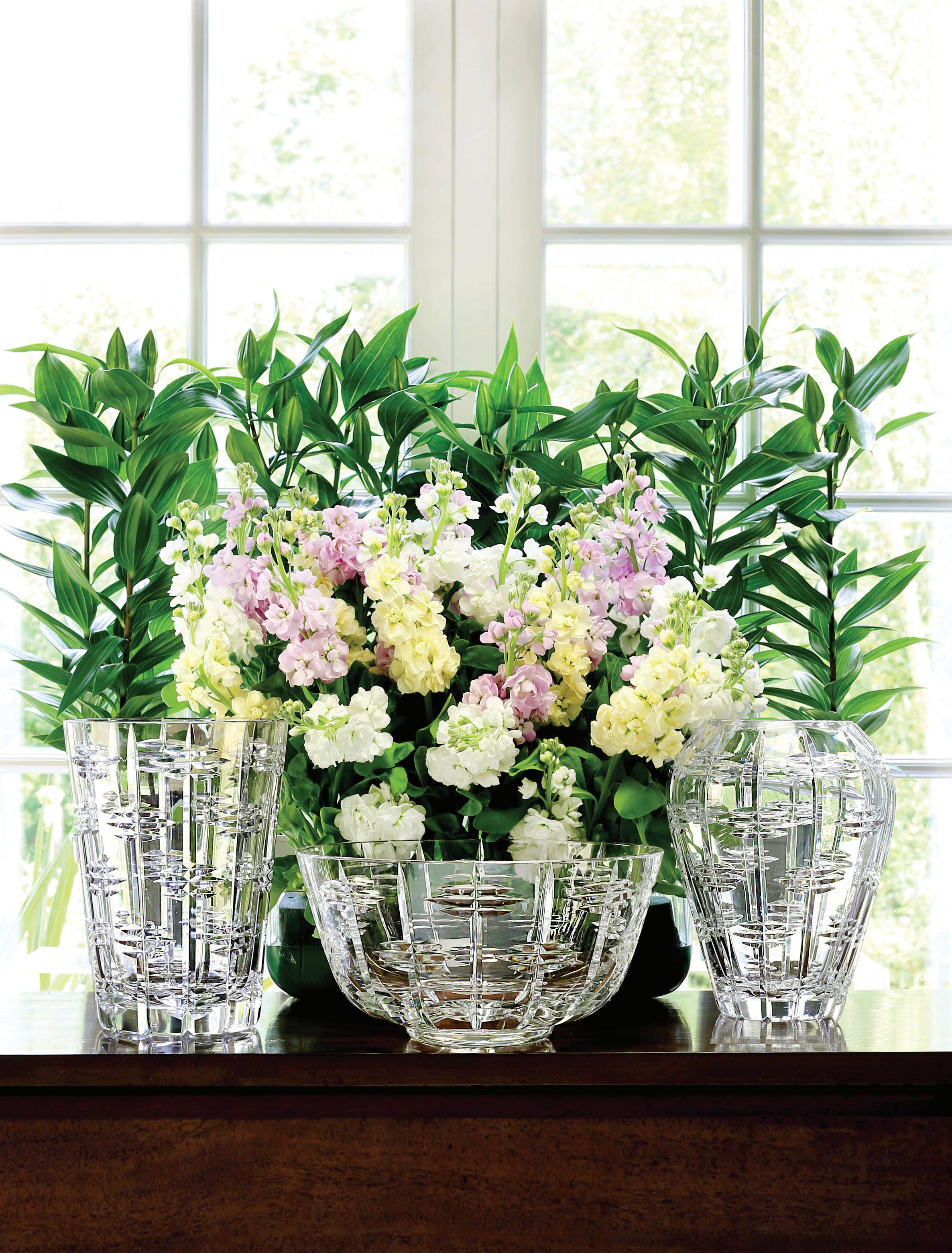


23
From the Field
Discover furniture and accessories in earthy greens, explore new pieces hitting the market, and peruse the latest design books on the shelves.
38
John’s Almanac
John Coykendall, master gardener for Blackberry Farm, shares gardening wisdom he’s gathered through years of hands-in-the-dirt experience.
44
Decorating
Regardless of their age or origin, dried and pressed flowers, also known as herbaria, are lasting reflections of our natural world.
Entertaining
54
To celebrate the launch of A Screaming Blast, her new book from Rizzoli, event planner and interior designer Rebecca Gardner dishes on her theatrical party style.
62
At their home in Birmingham, Alabama, FLOWER Editor-in-Chief Margot Shaw and husband Gates welcome designers near and far to a picture-perfect garden party.
74
Design
Lifestyle editor Alice Doyle entrusts interior designer Danielle Balanis to help her check off the long wish list she’d accumulated after years of living in her historic Mediterranean Revival house in Birmingham.
IN EVERY ISSUE
Watering Can 18
What’s Online? 90 Sources 138 Floral Moment 140

WATERING CAN A Note from the Editor

I HAVE A CONFESSION TO MAKE. One of my guilty pleasures is looking into windows of houses while riding or walking somewhere at dusk, just when inhabitants have returned home for the evening and lights have been lit—that in-between time, the gentle transition from day to night, work to rest.
No, I’m not a voyeur, and I’m not casing the joints. I just love to imagine—maybe write a scene in my head (based on what little visual information the passing glimpse affords). I like to think of what music might be playing, what those folks are having for dinner, what flowers might be gracing the front hall console, what life is like in that home. Though I wouldn’t wish for any house and garden other than my own, I suppose my fascination with other places and people explains in part my desire to capture and share stories of beautiful houses and gardens and the talented individuals involved in making the magic.
Here in these pages, you’ll have the chance to not only glimpse but gaze into the gorgeous personal places and lives of some very talented tastemakers, artisans, gardeners, and designers. You’ll tour the Virginia home of Michael Devine and Thomas Burak,
“I’ll light the fire You place the flowers in the vase
That you bought today Staring at the fire…
Such a cozy room
The windows are illuminated
By the evening sunshine through them
Fiery gems for you, only for you”
FROM “OUR HOUSE” BY GRAHAM NASH
a textile designer and interior designer respectively, who were both drawn to the 70-year-old, timeworn structure they filled with European antiques and collections; visit the Orangerie Garden + Home emporium in Millbrook, New York, conceived and kept by landscape architect Anthony Bellomo; soak for a spell in the glamorous gloaming of a dinner party at Jane Scott Hodges’s New Orleans home; ramble through the chic and inviting interior of a Dallas house deftly designed by Kara Childress; and lean into learning about the time-honored world of herbaria.
Much as I wish for you to relish these moments in the magazine, I also kind of hope you’ll find yourself drawn to look in windows from the road at twilight…
Love and SDG,

Margot Shaw EDITOR-IN-CHIEF
Please send your comments, triumphs, challenges & questions to: wateringcan@flowermag.com OR Letters to the Editor I FLOWER Magazine I P.O. Box 530645 I Birmingham, AL 35253 Get the FLOWER email newsletter! Sign up at flowermag.com/news
BY
PHOTO
DAVID HILLEGAS




VOLUME 19, ISSUE 5
MARGOT SHAW FOUNDER/EDITOR-IN-CHIEF
Karen Carroll EDITORIAL DIRECTOR
Julie Gillis MANAGING EDITOR
Ellen Shanks Padgett ART DIRECTOR
Amanda Smith Fowler STYLE DIRECTOR
Julie Doll EXECUTIVE ASSISTANT
DIGITAL
Jason Burnett DIGITAL GENERAL MANAGER
Carrie Clay ASSOCIATE EDITOR
Katharine Grace Whatley INTERN
CONTRIBUTING EDITORS
John Coykendall, Alice Welsh Doyle, James Farmer, Marion Laffey Fox, Elaine Griffin, Tara Guérard, Frances MacDougall, Tovah Martin, Cathy Still McGowin, Charlotte Moss, Matthew Robbins, Margaret Zainey Roux, Frances Schultz, Sybil Sylvester
For editorial inquiries: editorial@flowermag.com
Jennel O’Brien PUBLISHER
Suzanne Cooper NATIONAL DIRECTOR, HOME FURNISHINGS
Julie Durkee NATIONAL DIRECTOR, LUXURY
Kate Chapman NORTHEAST ACCOUNT DIRECTOR
Steven M. Fisher MIDWEST/SOUTHWEST ACCOUNT DIRECTOR
Wendy Ellis REGIONAL ACCOUNT MANAGER
Sara D. Taylor REGIONAL ACCOUNT MANAGER
Marlee Ledbetter Mims INTEGRATED MARKETING MANAGER
For sales inquiries: sales@flowermag.com
BUSINESS OFFICE
Mercy Lloyd CHIEF OPERATING OFFICER
Nicole Bowman CIRCULATION MANAGER
Patrick Toomey ACCOUNTANT
CUSTOMER SERVICE
For change of address and subscription inquiries: 877.400.3074 or CustomerService@FlowerMag.info
ADVISORY BOARD
Paula Crockard, Winn Crockard, Gavin Duke, Gay Estes, Katie Baker Lasker, Mary Evelyn McKee, Michael Mundy, Ben Page, Angèle Parlange, Renny Reynolds, Scott Shepherd, Mish Tworkowski, Remco van Vliet, Evie Vare, Louise Wrinkle



The Susan Ferrier Collection
Discover furniture and accessories in earthy greens, explore new pieces hitting the market, and peruse the latest design books on the shelves.
PRODUCED
AND
STYLED BY AMANDA SMITH FOWLER PHOTOGRAPHY BY DAVID HILLEGAS

“Autumn has always been my favorite time of year. I love the crispness in the air and how the oranges, golds, and muted greens take center stage just as the garden is starting to slow down at our home in Virginia. It’s a palette I naturally gravitate toward in my design work.”
—BARRY DIXON

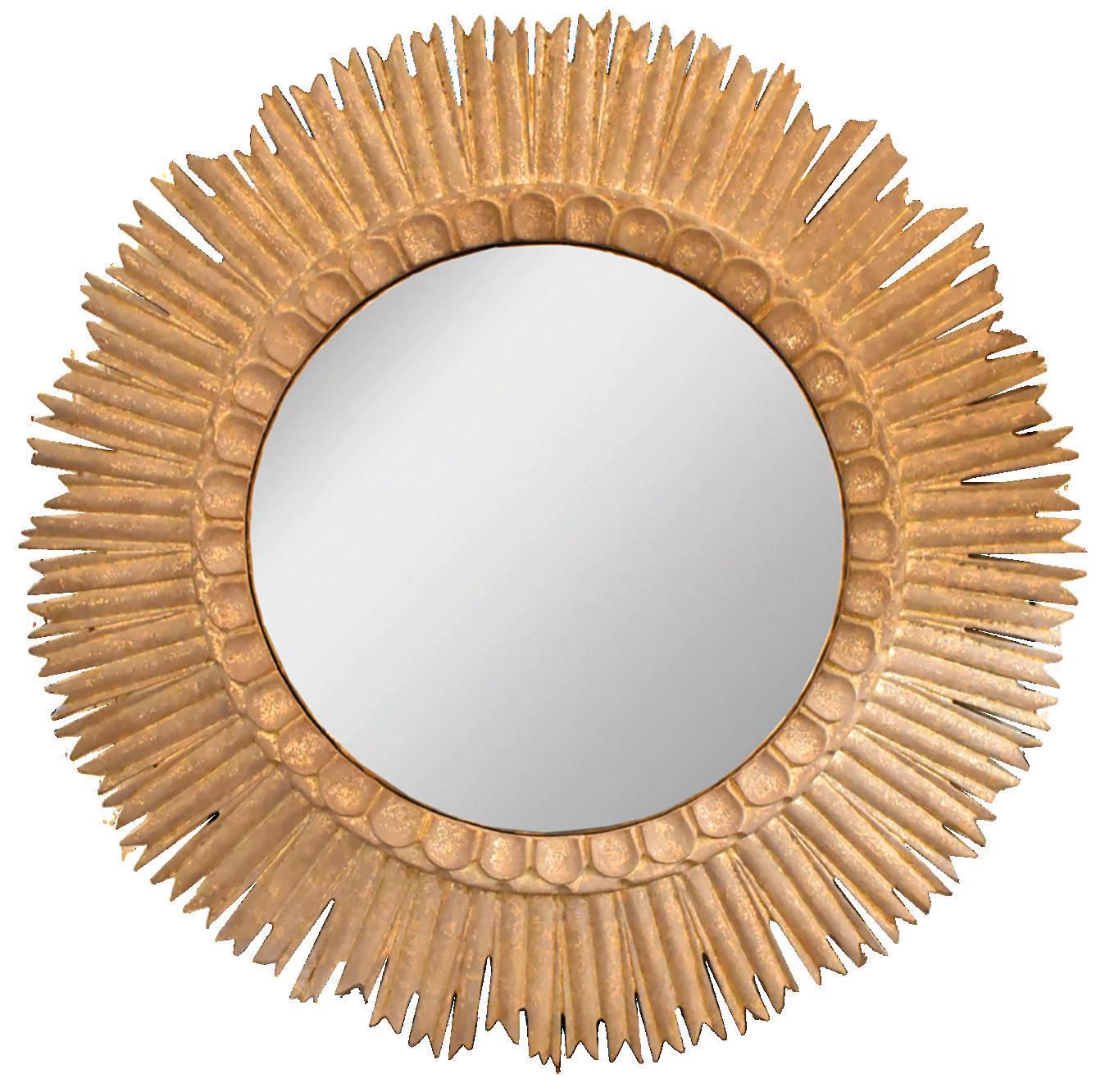

“Green is a universally loved color; it’s vibrant and fresh, neither feminine or masculine, nor young or old.”

—MARK D. SIKES


PREVIOUS PAGE, CLOCKWISE FROM TOP: Hayes Leather Tray ($280) and Seville Horn Bowl ($80) from Regina Andrew, reginaandrew.com • Pan Atlas fabric in Moss Ombre (to the trade) by Barry Dixon for Vervain, fabricut.com • Francis 3-inch Flower Knobs ($90 each) from Art & Forge, artandforge.com • Alhambra Curly Pine Canapé Plate ($60 each) from Mottahedeh, mottahedeh.com • THIS PAGE, CLOCKWISE FROM TOP
RIGHT: Privet Bench ($5,753) by Mark D. Sikes for Chaddock Furniture Workroom, chaddock.com • Thedford Swivel Chair (to the trade) from Wesley Hall, wesleyhall.com • Starburst Chest ($4,770) from Modern History, modernhistoryhome.com • Abalone on Cork wallcovering in Jadetone (to the trade) by Barry Dixon for Vervain, fabricut.com • Little Greene sample pots in Absolute Flat Emulsion finish available in all colors (sample pot $8.50 each), littlegreene.us Soleil Metal Plate ($310) from Regina Andrew, reginaandrew.com; • Chicchi Lamp in Amber (to the trade) from Wildwood, wildwoodhome.com • Rustic Gold 36-inch Starburst Mirror ($750) from the Bevolo Collection, bevolo.com
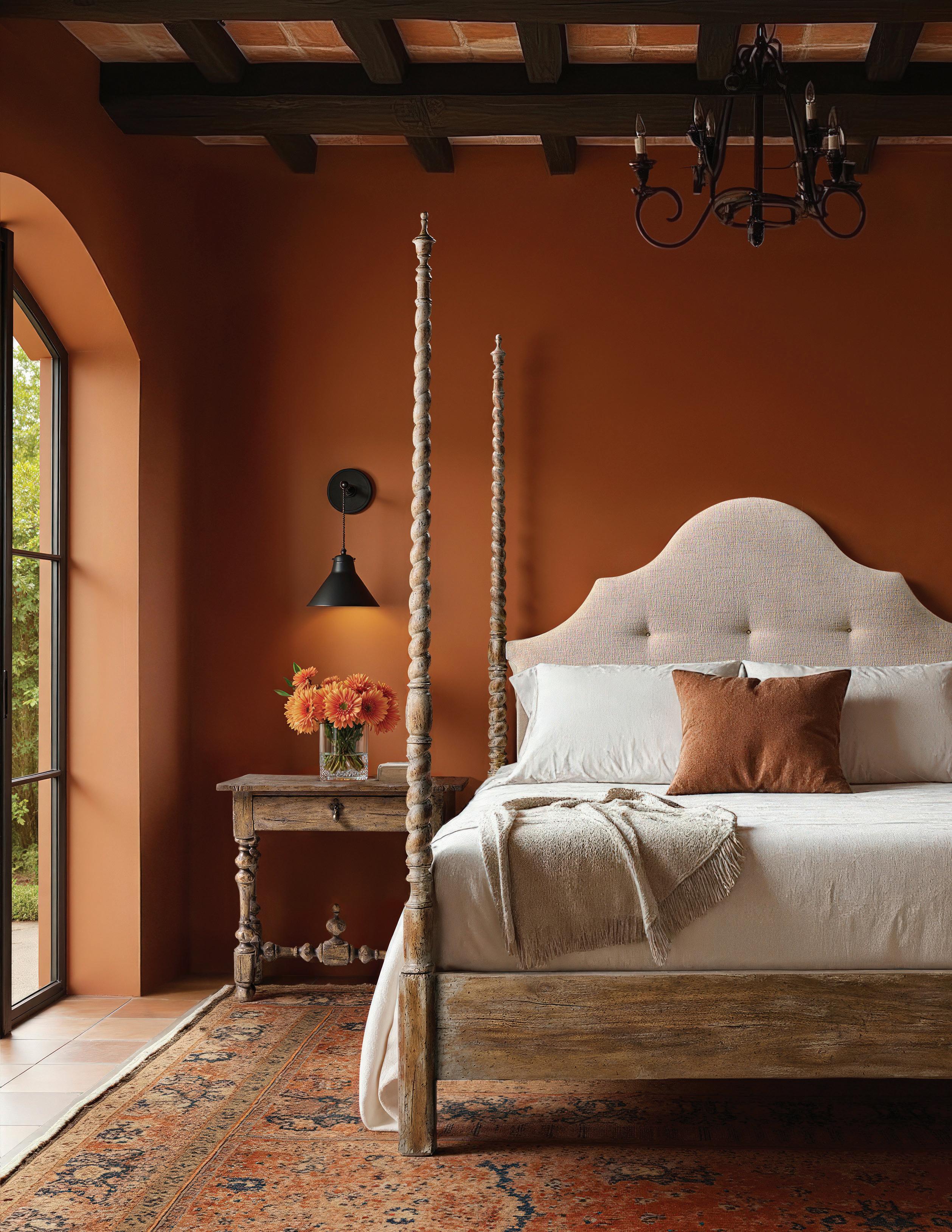




“I



believe every room should have a touch of green. It quiets the noise in a space with many layers and patterns and also makes a neutral palette come alive. It’s the chameleon of the color wheel.”
—AMANDA SMITH FOWLER


CLOCKWISE FROM TOP LEFT: Flower Pot in Agate ($1,500) from Seaman Schepps, seamanschepps.com • 9158-00 Stool (to the trade) from LEE Industries, leeindustries.com • Acorn Velvet 7895 fabric in Chive (to the trade) from Stout Textiles, estout.com • Tara Magnolia fabric in Gold (to the trade) from Lee Jofa, kravet.com • Diamond Mine fabric in Savanna (to the trade) from Donghia, kravet.com • Blanche Daybed with Trundle ($7,725) from Highland House, highlandhousefurniture.com • Ainsley Side Chair ($2,615) from CR Laine, crlaine.com • Montclair Accent Chest ($3,824) from Jonathan Charles, jonathancharles.com • Augusta Lamp in Olive ($895) from Chelsea House, chelseahouseinc.com



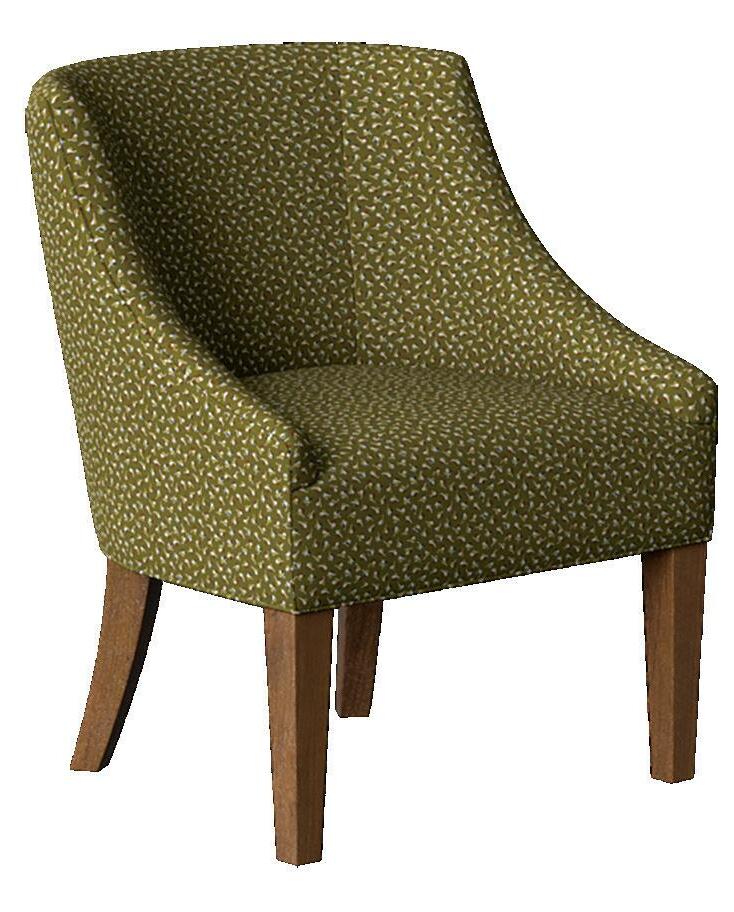



“Green invites us to breathe deeply and feel at ease—it’s nature’s quiet confidence translated into color.” COREY DAMEN JENKINS


Evans Dining Chair in Tilly ($1,335) from Coley Home, coleyhome.com • Jennings Side Table in Oak ($5757) from the Thomas O’Brien Collection for Century Furniture, centuryfurniture.com • Celerie Kemble Barrel Swivel Chair ($2,999) from Taylor King, taylorking.com • Lagoon Lamp ($1,000) from Bunny Williams Home, bunnywilliamshome.com • Maurant Stool ($3,015) by Corey Damen Jenkins for Hancock & Moore, hancockandmoore.com • Quintessence Tibetan Forest Clutch ($7,480) from Silvia Furmanovich, silviafurmanovich.com • 4019 Sofa (to the trade) from Sherrill Furniture, sherrillfurniture.com

SHERRILL
PHOTO BY JESSE WILLIAMS






—ALEXA HAMPTON




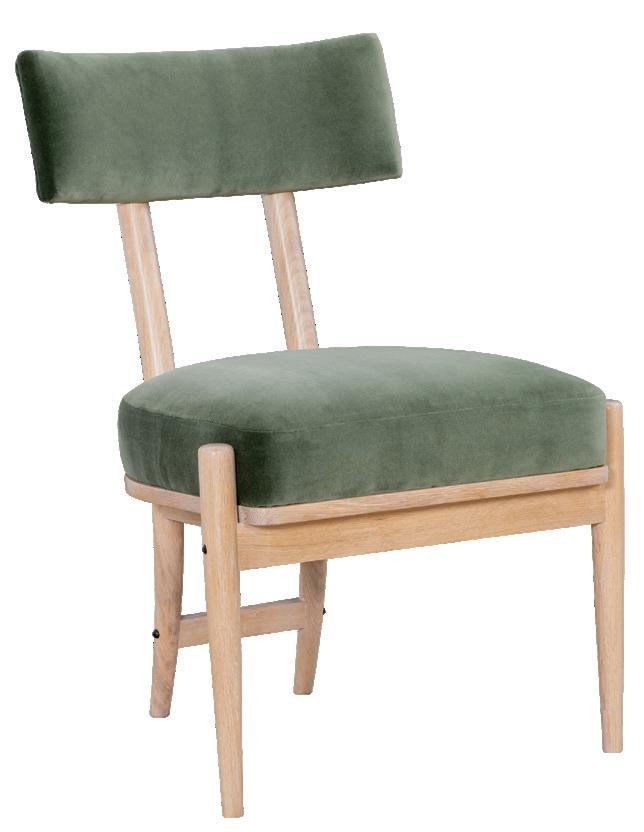

“The klismos chair is timeless—its form both ancient and modern.”
—SUSAN FERRIER

LEFT, TOP TO BOTTOM: Delos Chair ($4,955) from Alfonso Marina, alfonsomarina.com • Klio Dining Chair (to the trade) from the Ray Booth Collection for Hickory Chair, hickorychair.com • Montclair Cocoa Dining Chair ($560) from Universal Furniture, universalfurniture.com RIGHT, ABOVE AND BELOW: Pollara Lounge Chair (to the trade) from the Susan Ferrier Collection for Baker, bakerfurniture.com • Lars Accent Chair ($3,585) from the Tara Shaw Collection for Century Furniture, centuryfurniture.com

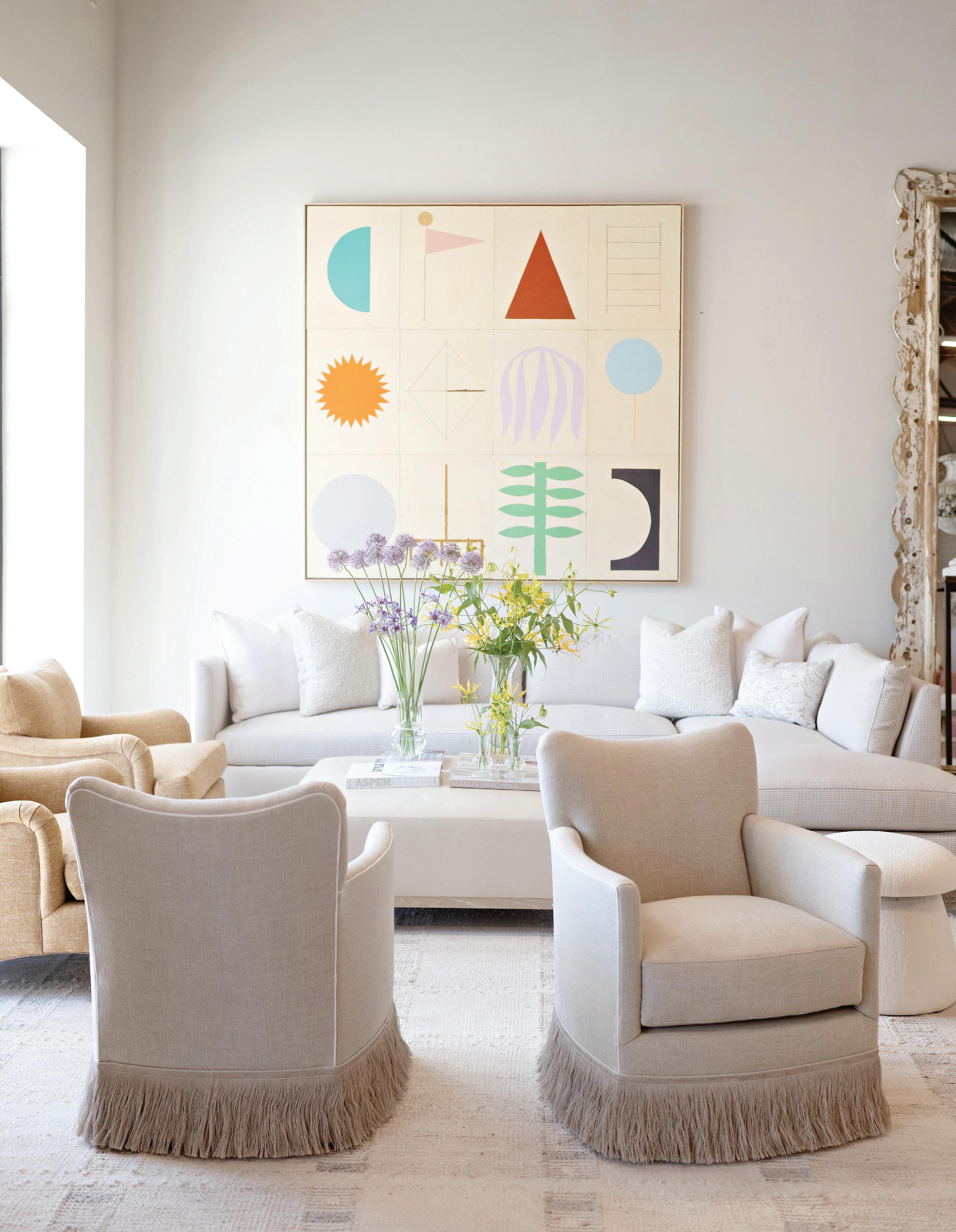
“The colors we choose to decorate our homes with or surround ourselves with convey feelings and narratives that words may not fully capture. Color is the language of dreams.”

and the next page, see Sources on page 138.






collection



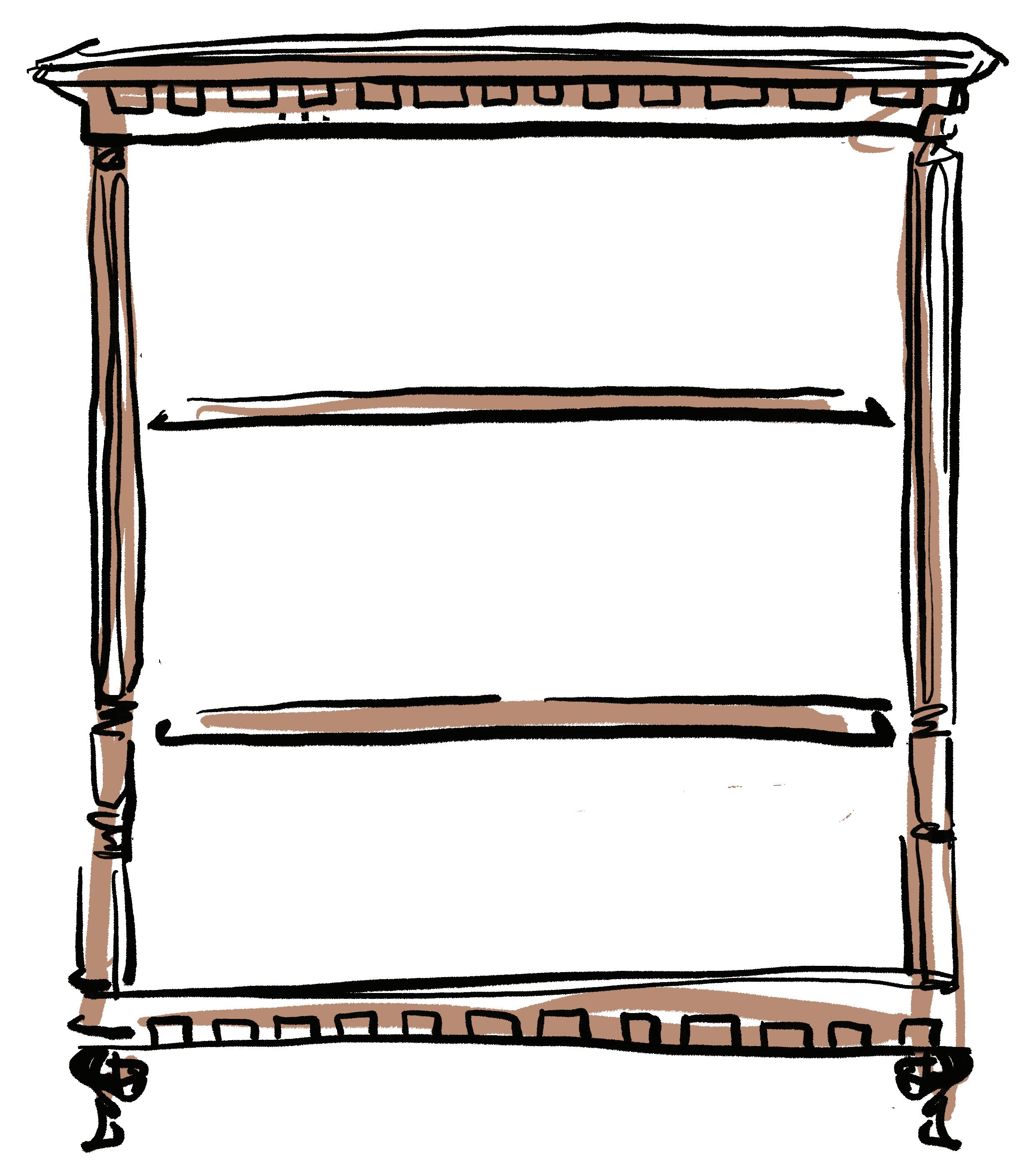



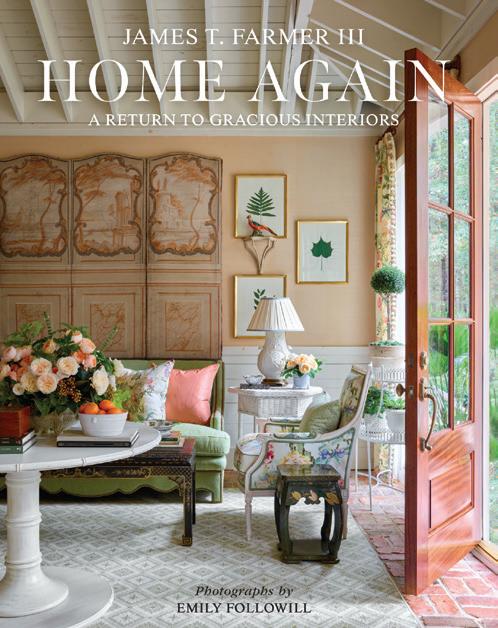
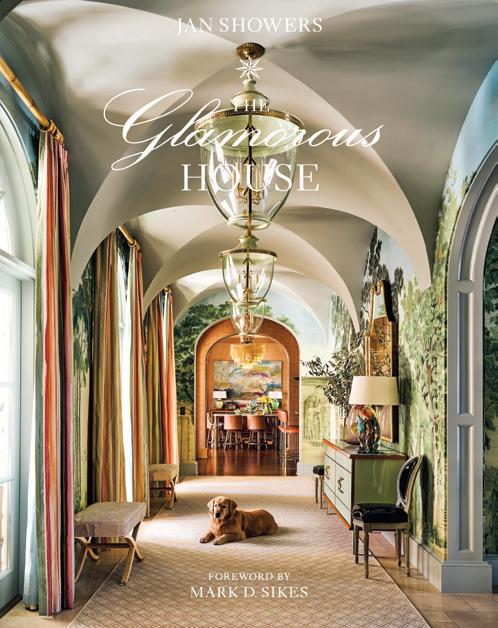



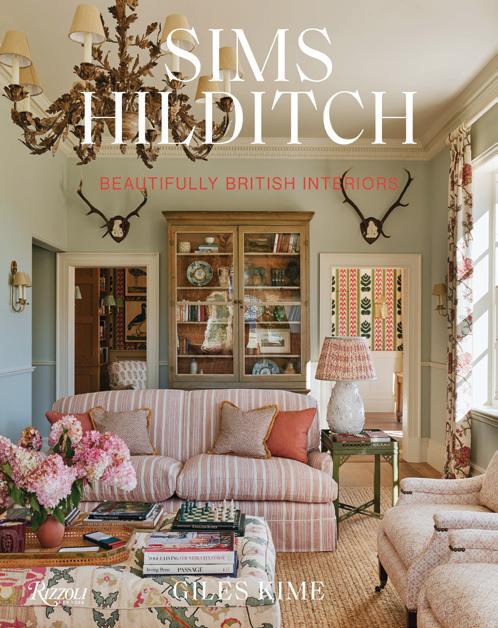
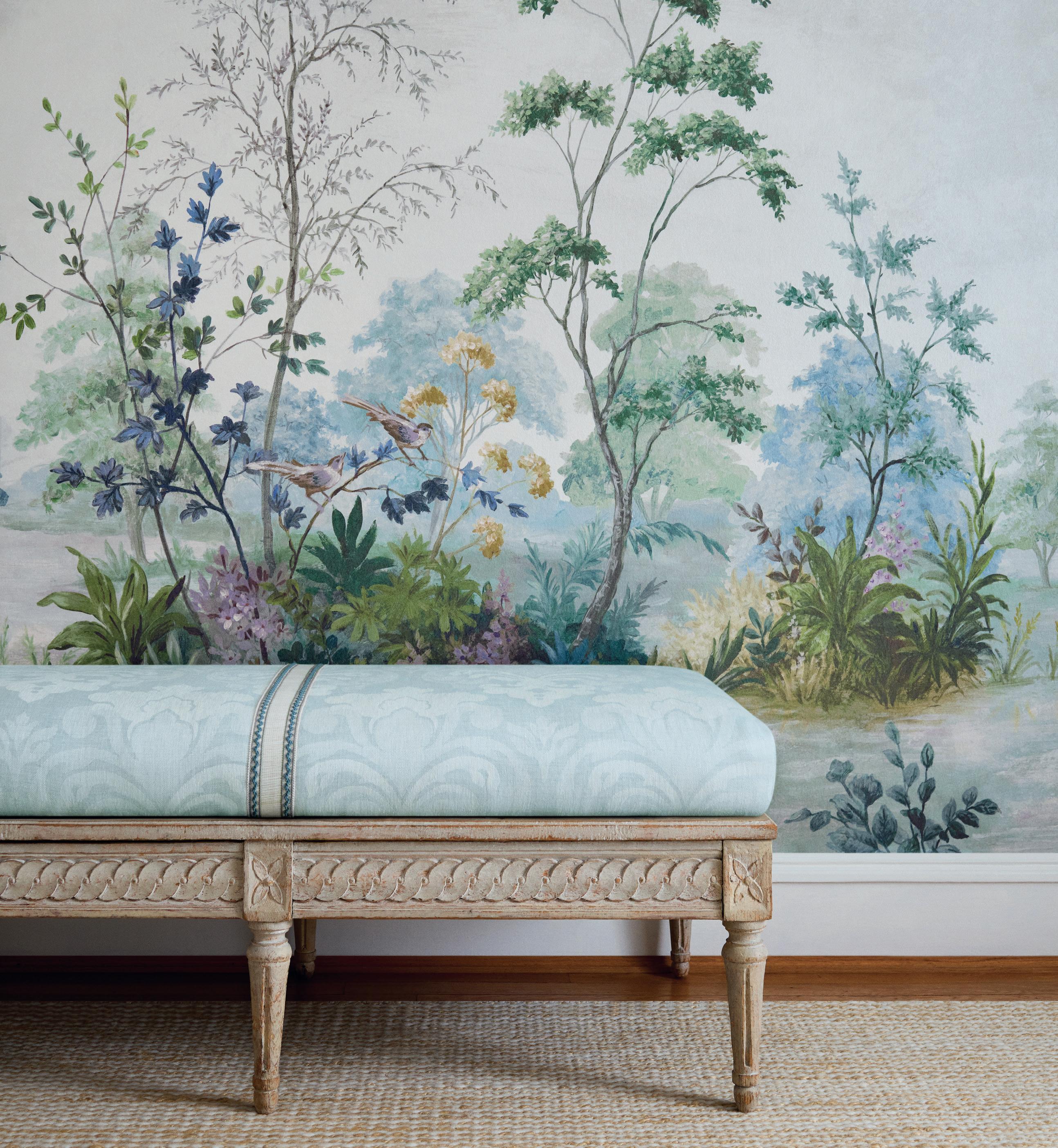
Timelessly elegant wallcovering, textiles and trims.
thibautdesign.com/AF

Cumbria Mural. Bench in Darcey Damask with Gabrielle Tape. Montecito rug.
John’s Almanac
John Coykendall, master gardener for Blackberry Farm, shares gardening wisdom he’s gathered through years of hands-in-the-dirt experience.

With cooler days approaching, I begin thinking about my favorite crops for fall—the season when the spring garden can be repeated with the addition of kale, collards, mustard greens, Swiss chard, turnips, and rutabagas. I can still recall a late October afternoon in 1954 when my grandfather took me
to his turnip patch on the farm and I pulled up a number of purple top turnips. I was fascinated by their beautiful color. That evening, my mother prepared them for supper with a simple recipe that remains my favorite way to eat them— steamed and seasoned with butter, salt, and pepper. It’s one of my fondest fall memories.
TURNIPS

Autumn Garden

COLLARDS
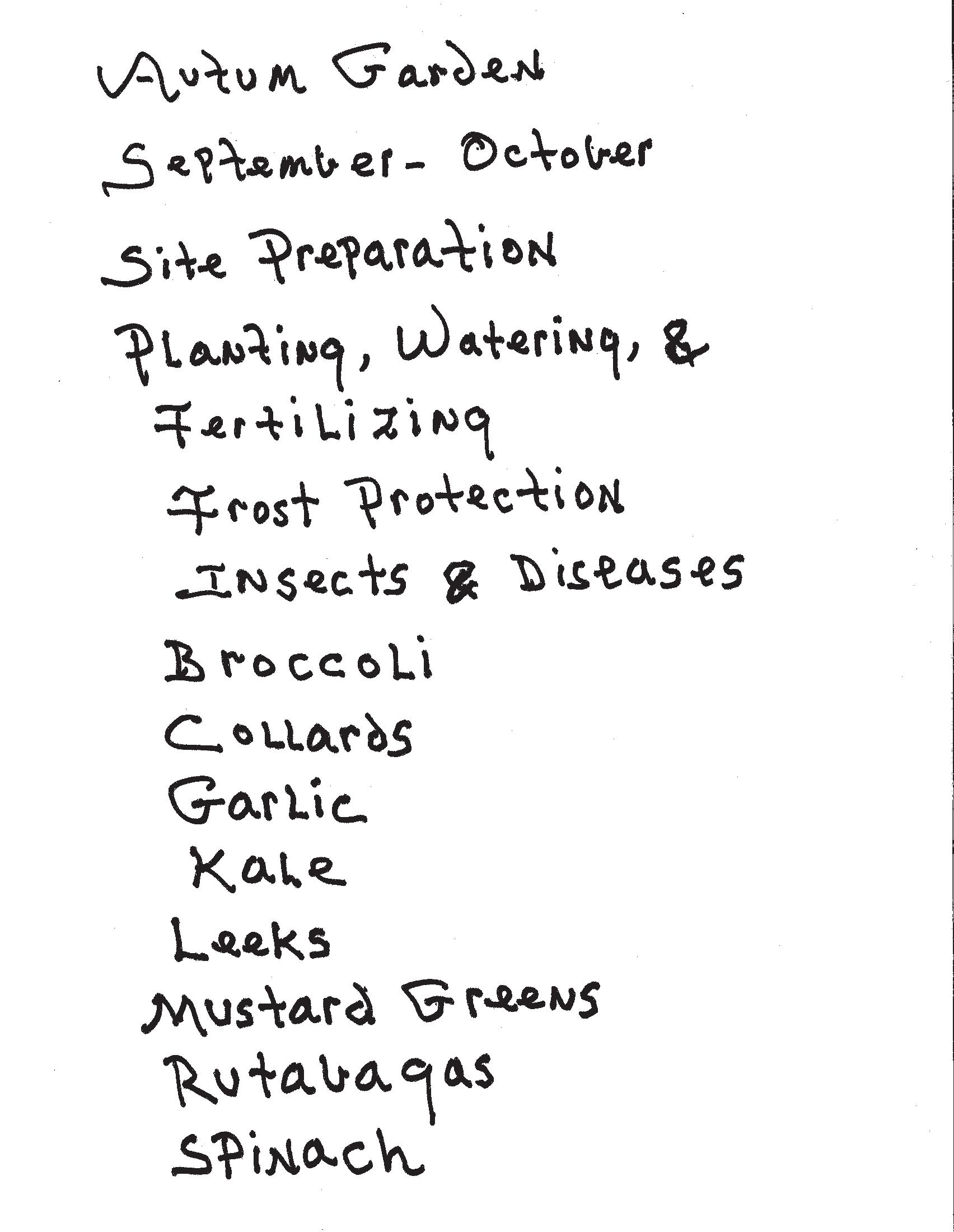
Garlic is set out by dividing the bulb and setting out the individual cloves on the last full moon in October.

PLANTING 101:
jump start in fall, it will be one of the first things to come up in the garden next spring. It needs well-turned soil that drains easily. Add compost to the soil prior to planting. To keep the cloves from drying out, plant within 48 hours of separating. Cloves may be planted with peels intact and pointed end upwards 1 to 2 inches deep and 4 to 6 inches apart. The largest cloves
JOHN’S TIPS
• Repeat spring plantings in the fall. The weather is reversed, moving from hot days to the cooler days of fall.
• Begin with healthy plants. Avoid seedlings that might be stunted in their growth from lack of water, insect damage, and disease. It’s also important that young seedlings begin to grow quickly. Timely watering is essential, and liquid fertilizer helps to promote strong growth.
• Look at maturity dates for each variety When looking at maturity dates, it’s best to subtract that time period from the first expected frost and add two more weeks for good measure. Plants tend to grow a bit slower during colder months.
• Be sure to mulch. Mulching helps prevent weeds, conserve moisture, and protect roots from first frosts.
• Pick greens after the first frost. This is when they have a mild, sweeter flavor.




GARLIC






to be thinned out, allowing 4 to 6 inches between plants. Sometimes if you’re lucky, you might find spinach coming up again when you clean out the garden for spring.

COMPANIONS: arugula, broccoli, cabbage, carrots, garlic, lettuce, onions, peas, radishes, Swiss chard, AVOID: fennel, peppers, potatoes
JOHN’S FAVORITE: Bloomsdale Long Standing

PLANTING 101: Summer is often too hot for Swiss chard and pushes the plant into bolting. Fall’s cooler temps allow it to develop nicely. During this season, Swiss chard can withstand a light freeze but will not tolerate frozen ground. Space seeds (or transplants) 6 inches apart with rows 12 inches apart. Mulching not only helps with moisture retention and weed prevention but also protects the roots from an early freeze.

PLANTING 101: Succession-planting mustard greens is smart and easy. Plant from seed (½-inch deep) or transplanted (4 to 6 inches apart) every 2 to 3 weeks. Keep the soil moist—
PLANTING 101: Great fresh or cooked, spinach requires a short growing season. Sow seeds ½-inch deep, 2 inches apart, and in rows 12 to 18 inches wide. Sprouts come up quickly (within 7 to 10 days). Once they are 2 inches tall, they need
COMPANIONS: beans, cabbage, garlic, lettuce, onions, peas, radishes
AVOID: beets, potatoes, spinach
JOHN’S FAVORITES: Bright Lights, Fordhook Giant, Rhubarb Red

PLANTING 101: The greatest two-forone deal in vegetables, turnips are easy to plant during spring and fall. However, they cannot sustain during the summer months. They should always be direct sown as they do not transplant well. Before planting, loosen the soil 12 to 15 inches deep to allow for full development. Seeds should be planted only ¼ to ½ inch deep and 1 inch apart. Water well and consistently. After only four weeks, the turnip greens are ready for harvest; in another month, the turnip roots can be taken up.
COMPANIONS: beans, broccoli, Brussels sprouts, cabbage, garlic, lettuce, onions, peas, spinach, Swiss chard
AVOID: mustard greens, onions, potatoes
JOHN’S FAVORITES: Purple Top, White Globe, Yellow Globe
**Disclaimer: Contact your local agricultural extension agents for information concerning your regional planting dates.
SWISS CHARD
RUTABAGAS
MUSTARD GREENS
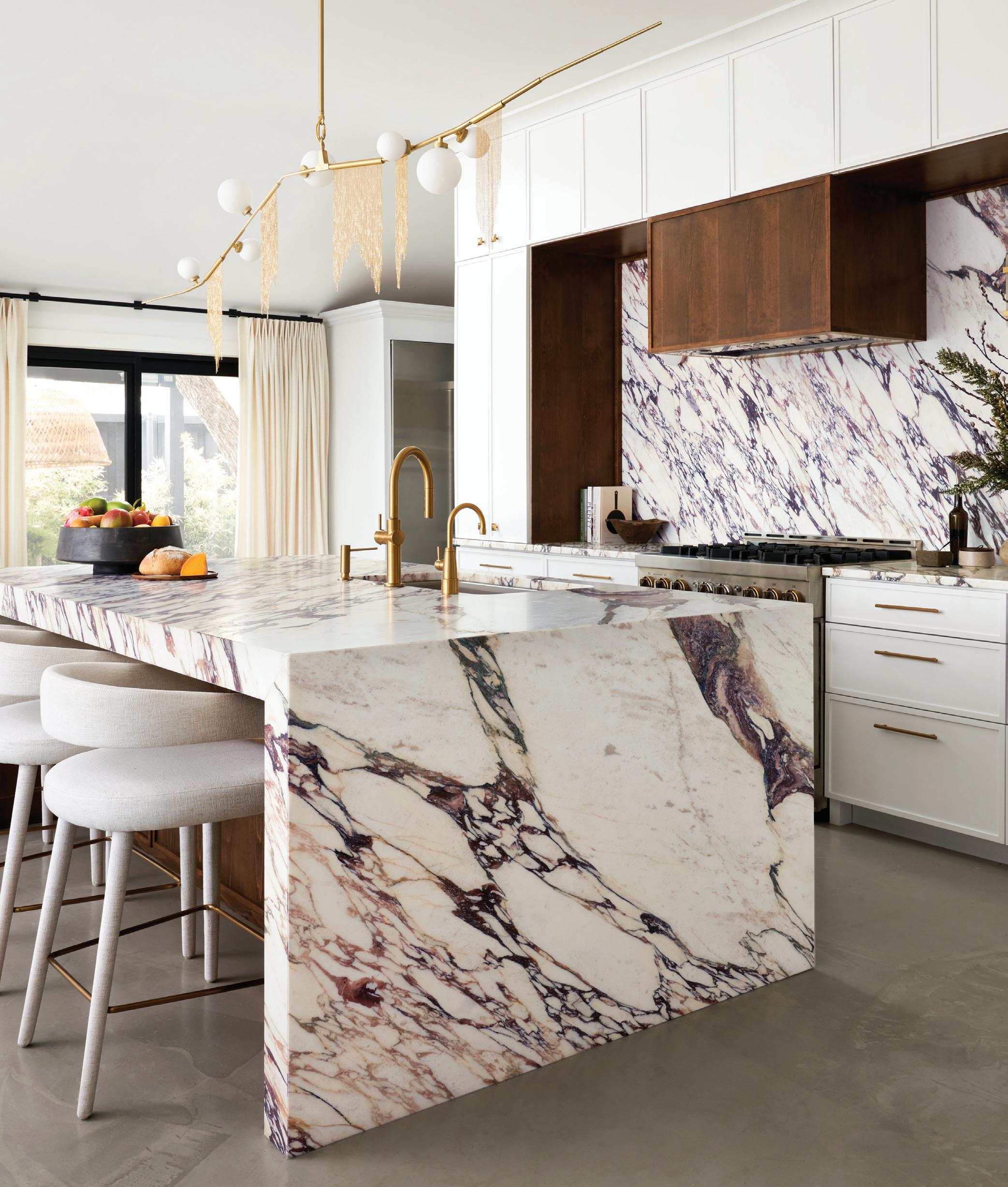

Pressed for Time
Whether for study or decoration, dried and pressed flowers, also known as herbaria, are lasting reflections of our natural world.
BY FRANCES MACDOUGALL

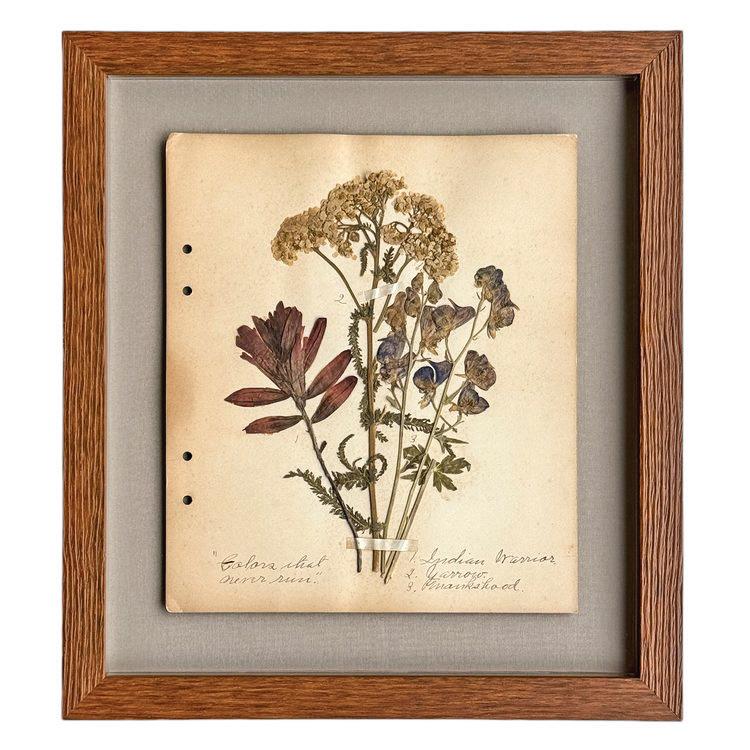

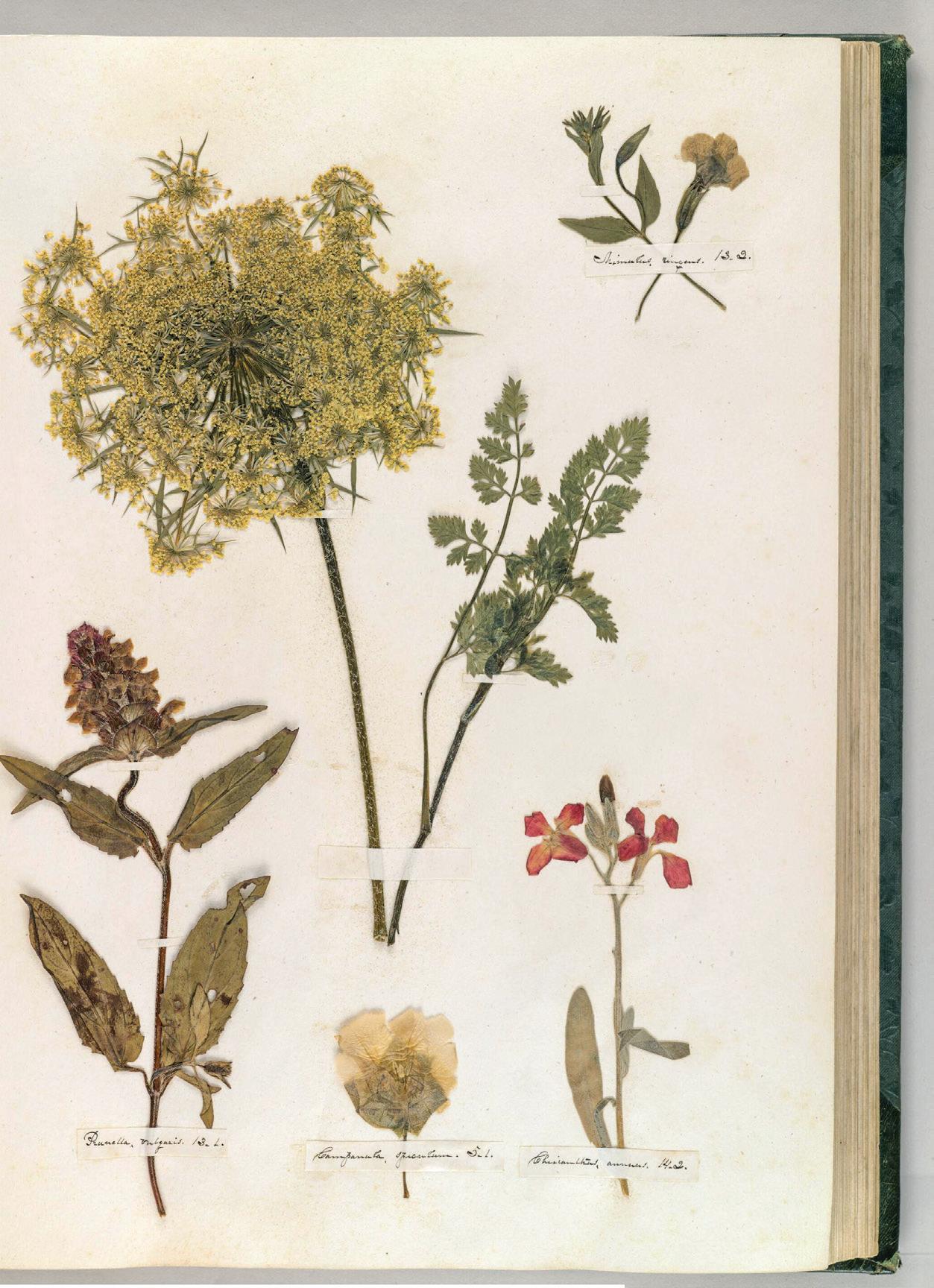
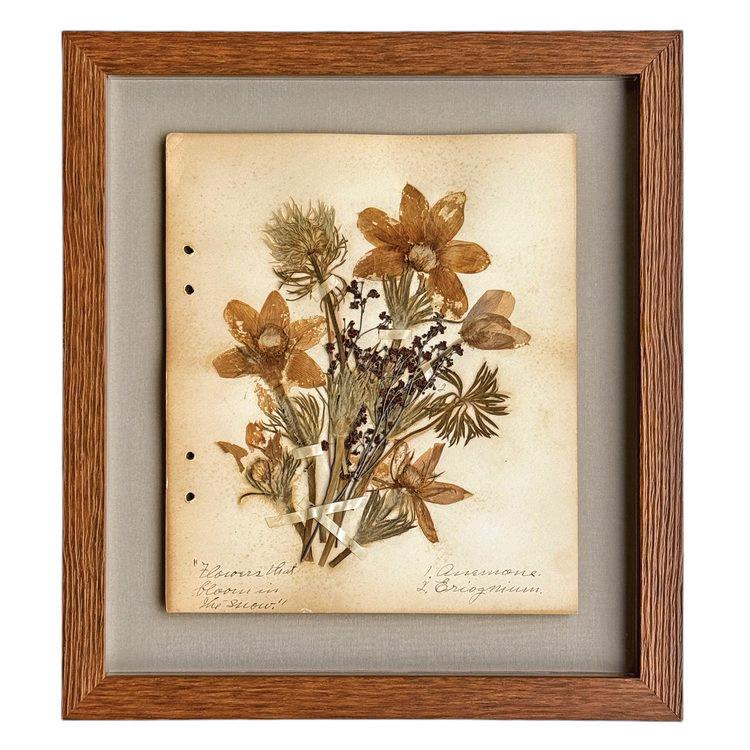
The list of those who have practiced pressing botanicals reads like a Who’s Who of civilization’s iconic figures. From the entombed pharaohs of ancient Egypt, who were adorned in flowers, to the 18th-century Swedish scientist Carl Linnaeus, who created the binomial system of naming and categorizing plants, to the 19th-century English naturalist Charles Darwin, who studied plants that contributed to his theory of natural selection, such leaders, scientists, and scholars have looked to flowers and plants for meaning and insight into the fundamental mechanics of our natural world. Called an herbarium when assembled for study or sentiment, pressed botanicals exist around the world at institutions such as the New York Botanical Garden, The Linnean Society and the Royal Botanic Gardens at Kew in London, and the National Museum of Natural History in Washington, D.C. Whether they are new or centuries old, pressed botanicals continue to serve as research material and exploration in a worldwide collaboration that endeavors to understand our past and future and the diversity of plant life on earth.
This fascination with the dried and desiccated is not just for the world of science, though. It’s a dynamic field that became much more widespread in the Victorian era, as science and sentiment intersected (or were serendipitously tangled). The unauthored and widely published book The Language of Flowers provided a guide of sorts to bestowing profound meaning to a flower or bouquet. For example, a lily of the valley suggested “a return of happiness” while an acacia rose meant “elegance.” A single pressed flower or herbarium preserved those sentiments so they would last for decades rather than just a fleeting moment.
The poet Emily Dickinson assembled her own herbarium in the mid 19th century while a student at Amherst Academy and then Mount Holyoke Female Seminary, collecting and pressing the flowers and greenery that grew up around her and presumably inspired her poetry. The extremely fragile pages, which are stored at Harvard’s
PREVIOUS PAGE: British decorator Liz Morris brings her favorites together above an antique Swedish bench. Beloved dogs Daisy and Dolly preside over the pressed botanical corner, which includes pages floating within silver gilt frames. TOP: Pages from a mid 1920s herbarium feature bouquets created from flowers of the Rocky Mountains. Handwritten observations underscore the personal nature of each pressed composition. ABOVE: As a teenager, the poet Emily Dickinson assembled an herbarium, filling 61 pages with flowers, arranged and pressed from the garden around her home in Amherst, Massachusetts.


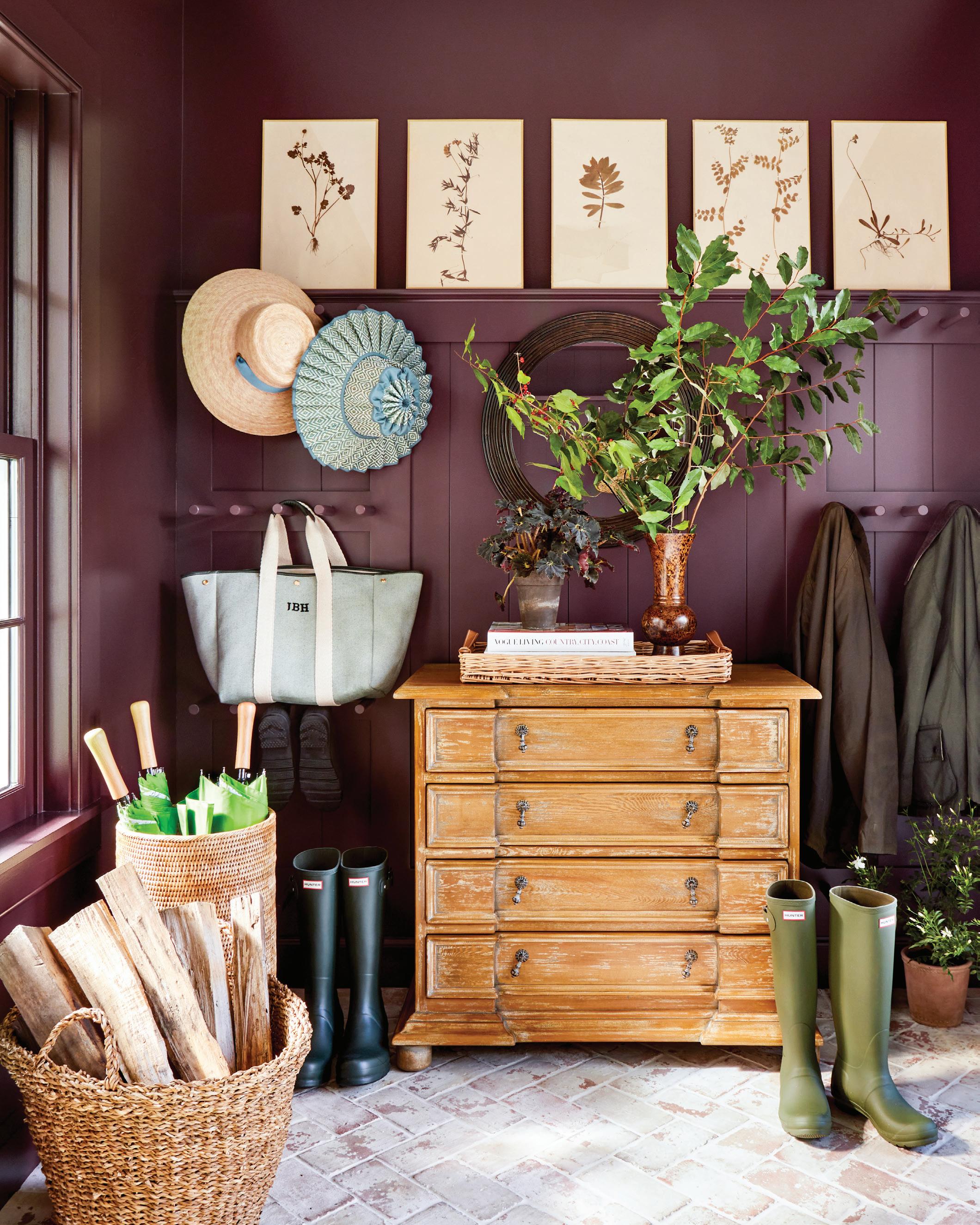
Pressed botanicals have an ethereal element, making them suited to airy spaces. But there is beauty to a dramatically colored wall as the backdrop, as in designer Jennifer Hunter’s mudroom in Connecticut, where the contrast enables the framed pages to stand out.
PHOTO BY RIKKI SNYDER, STYLING BY FRANCES BAILEY


ABOVE: A detail of this 1926 Rocky Mountains herbarium from Right | Proper illustrates that handwritten labeling is as charming as the specimens themselves. RIGHT: Houston designer Brooke McGuyer individually framed a series of French herbiers from Joyce Horn Antiques within a single large gilt frame to create a striking focal point in a hallway. BELOW: “I’m so drawn to the texture and warmth, and the older, the better,” says Dallas designer Shannon Bowers. Assembled and framed as a single work of art, this collection of nine gilt-framed pressed botanicals is an appropriately muted, yet artistic choice for a bedroom.

“Herbaria
are sometimes even better than souvenirs or photographs. They are books of memories.”
—ERIK RETZER OF RIGHT | PROPER

Houghton Library, are available for digital viewing. Their remarkable composition and precise labeling reveal an artist’s hand as she preserved the plants that captivated her.
More recently, decorators and collectors have discovered the charm of framing herbarium pages. Designer Liz Morris, owner of an eponymous business in Stratford-upon-Avon, England, has been pressing botanicals her whole life. “My father had a nursery, so I grew up in the garden,” she says. “We were always cutting flowers to pop in a vase or to press.” As a decorator and antiques dealer, she’s drawn to vintage examples. “I quite like the Swedish and French ones. They’re so simple and look great with the same era of furniture.” Over a lifetime on the hunt, Liz has refined her eye and focused her search. She prefers simple silver gilt or wood frames without matting. “A thin frame suits the delicacy of the flower,” she says. Her most prized pieces feature humble flowers such as daisies, cow parsley, mistletoe, and lavender. Liz also looks for herbaria that include labels or identifying information, such as the year, the Latin and common name, and where it came from. “It’s personal that way,” she says. “The wording may fade over time or the handwriting

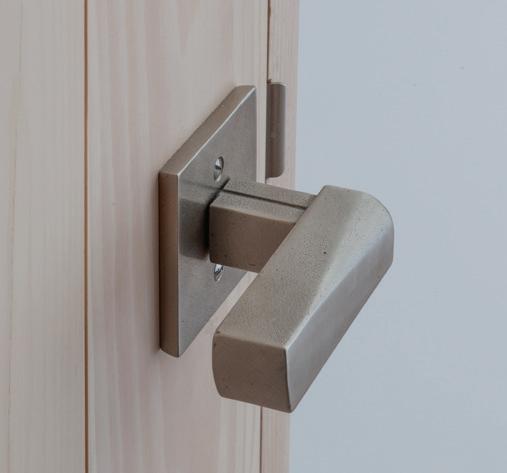
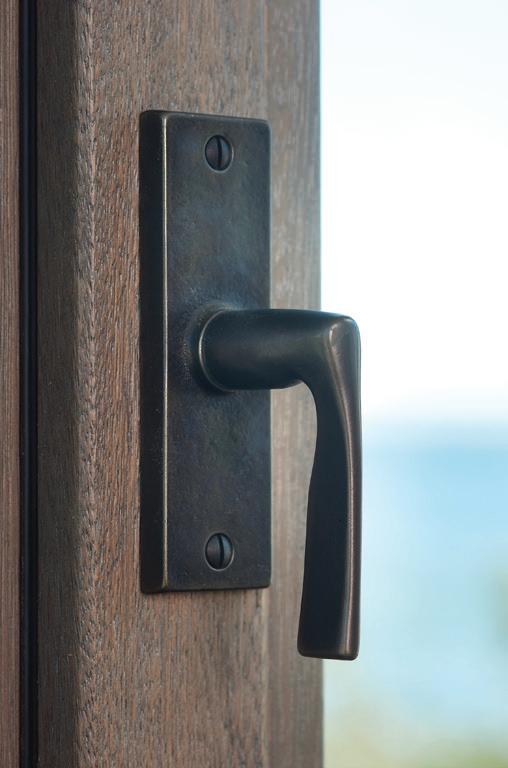



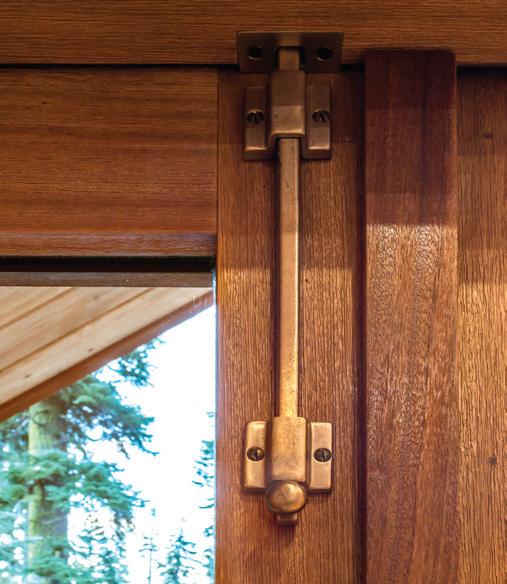






may be hard to read, but the labels are as individual as the flowers.” Chicago antiques dealer Erik Retzer of Right | Proper has searched for herbaria to keep in his shop for years. Erik’s level of devotion to pressed botanicals, especially those “with a few years on them,” means he is always on the lookout. “They’re nostalgic,” he says. “Hasn’t everyone picked a dandelion to give to a parent?” While Erik appreciates botanical prints like those by Pierre-Joseph Redouté or Basilius Besler, he is more intrigued by pressed botanicals, especially those “with a few years on them.” He’s framed 12 pages of a 1926 herbarium that are currently in his inventory. “What I love about this herbarium is how unique each bouquet is,” Erik says. Created by a Kansas family on vacation in the Rocky Mountains, the herbarium is full of pressed flower bouquets instead of the more frequently seen single blossom. Labels include handwritten, personal observations, as well as nomenclature and date. What really thrills Erik is when he finds an herbarium that is local to him or to a client. “To have a collection that includes botanicals from your area has such meaning.”
Before incorporating herbaria into their interiors, designers often clean up or replace frames that have seen better days while leaving the flowers alone. “These pressed botanicals feel authentic and natural,” says Dallas decorator Shannon Bowers, who has no rules when it comes to which rooms are best suited to hang them. “They work everywhere. References to nature are important in every room.”
What began with our ancestors picking flowers for appreciation of their beauty has morphed into pieces that keep history at the forefront. As long as scientists and gardeners, poets and children alike continue to delight in these creations, herbaria will remain important moments captured in time.
CREATING A COLLECTION
• Forage antiques fairs, estate sales, flea markets, and galleries for herbaria. If you’re fortunate to find a few intact, frame them and hang in a grid. If you find ones already framed, consider reframing to give them new life.
• Examine the pages carefully. They will bear the signs of age, which is part of their charm—but watch out for light damage and insects, which will degrade the old paper and the specimen.
• Look for the labels as they’re an important part of the story. They usually contain the scientific and common names, date and location of the collection, and the name of the collector. It’s also not uncommon to find personal notations from the collector.
• Check that the glue or tape holding the specimen in place is still secure. You may have to buy archival-friendly tape or glue to replace glue that’s lost its adhesive over time.
• Avoid direct sunlight when choosing where to hang herbaria to thwart future fading.
Learn about contemporary pressed flower artists at flowermag.com/new-herbaria
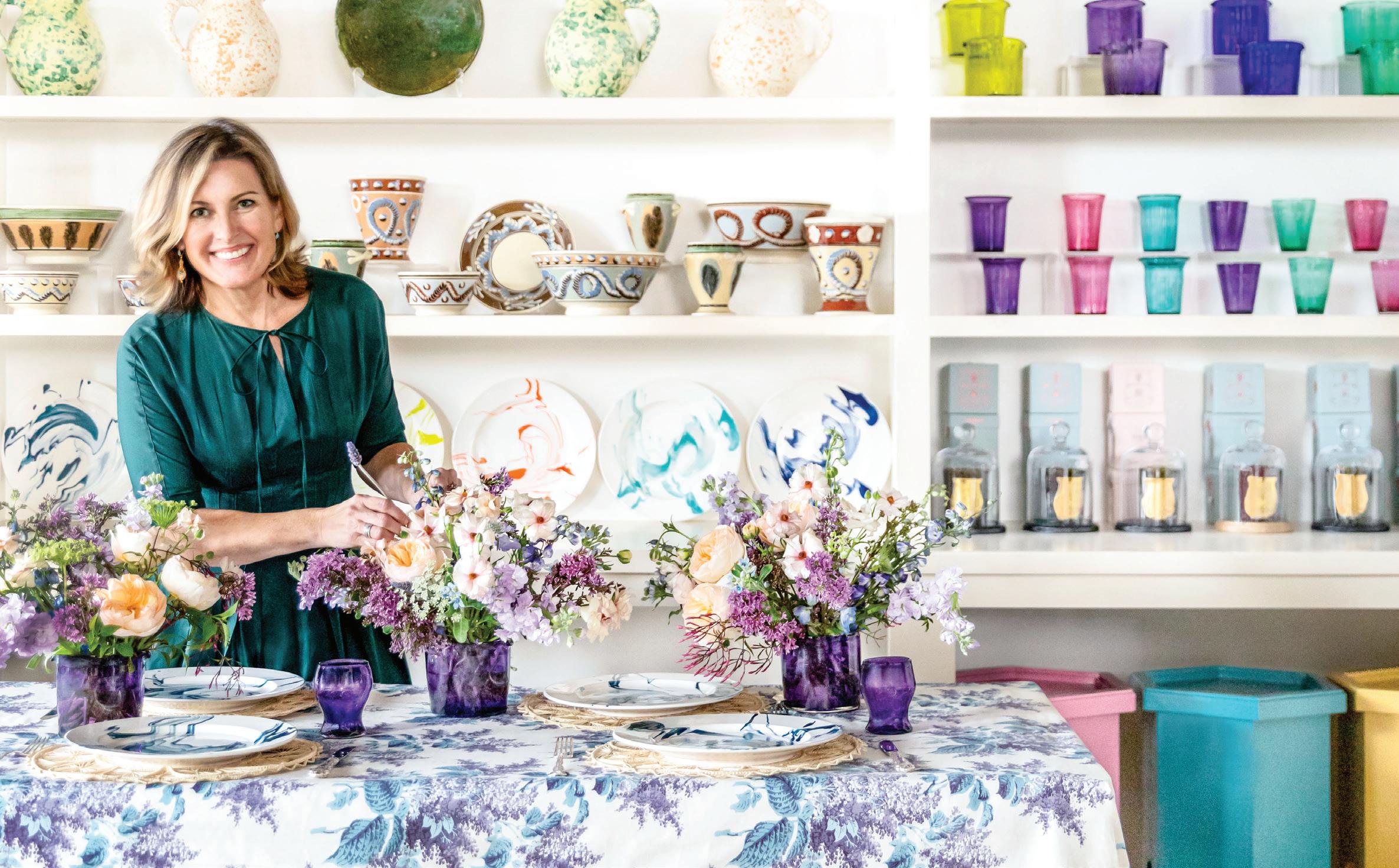


Creating a Spectacle
To celebrate the launch of A Screaming Blast, her new book from Rizzoli, event planner and interior designer Rebecca Gardner dishes on her theatrical party style.
BY AMANDA SMITH FOWLER

How did your love for entertaining and design transition into a full-fledged career?
Mark Twain once said, “Find a job you enjoy doing, and you will never have to work a day in your life.” My job is parties. Imagine that! Truth be told, it’s hard work. But I’m honored that my clients allow me to create magical little worlds in which they celebrate and make memories.
The title of your new book, A Screaming Blast, says it all. You definitely have a flair for the dramatic, and we love having a vicarious invitation to your parties in the pages of the book. How do you balance beauty with more fantastical elements? Parties should be beautiful, of course, but they MUST be fun. I like a party to have a surprise or delight every half hour. Depending on the type of party, venue, and occasion, I plan ice breakers, parlor games, a marching band, burlesque dancers, or a monumental dessert—possibly with sparklers on top. I have an entire category in my shop dedicated to these entertainments. They make parties memorable.
We’re dying to know what your own childhood birthday parties were like!
My mother threw lots of beautiful parties and indulged me in all my early birthday party fantasies. When I turned 7, she staged a fashion show and luncheon. In the finale, I walked the driveway-turned-runway as a bride, decked out in shiny white poly. At 9, I was given full control to contrive a “Pink Pig and Green Frog BBQ Scavenger
BY
PHOTO
ADAM KUEHL


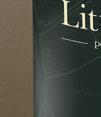





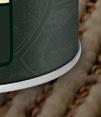
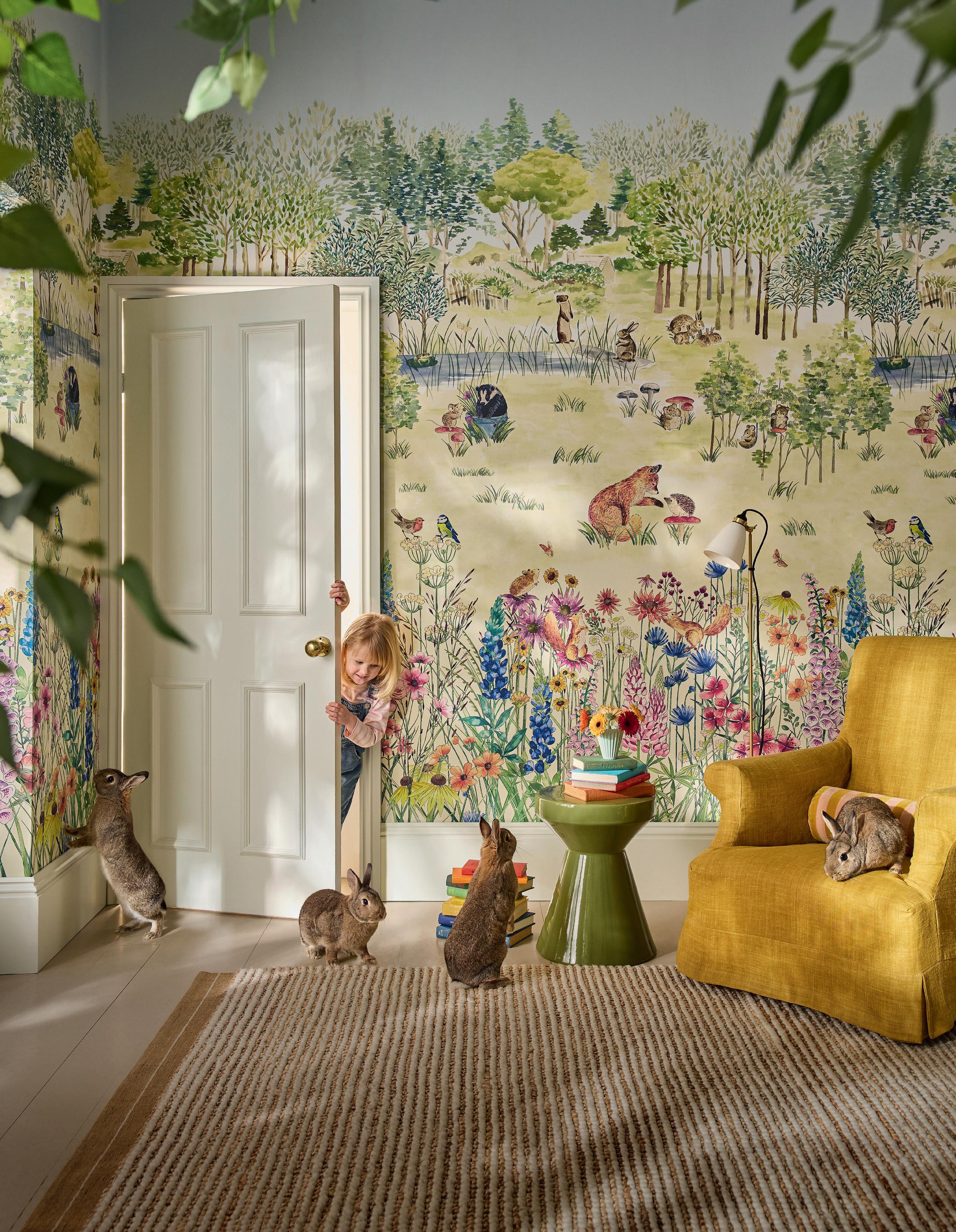


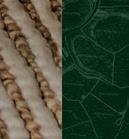










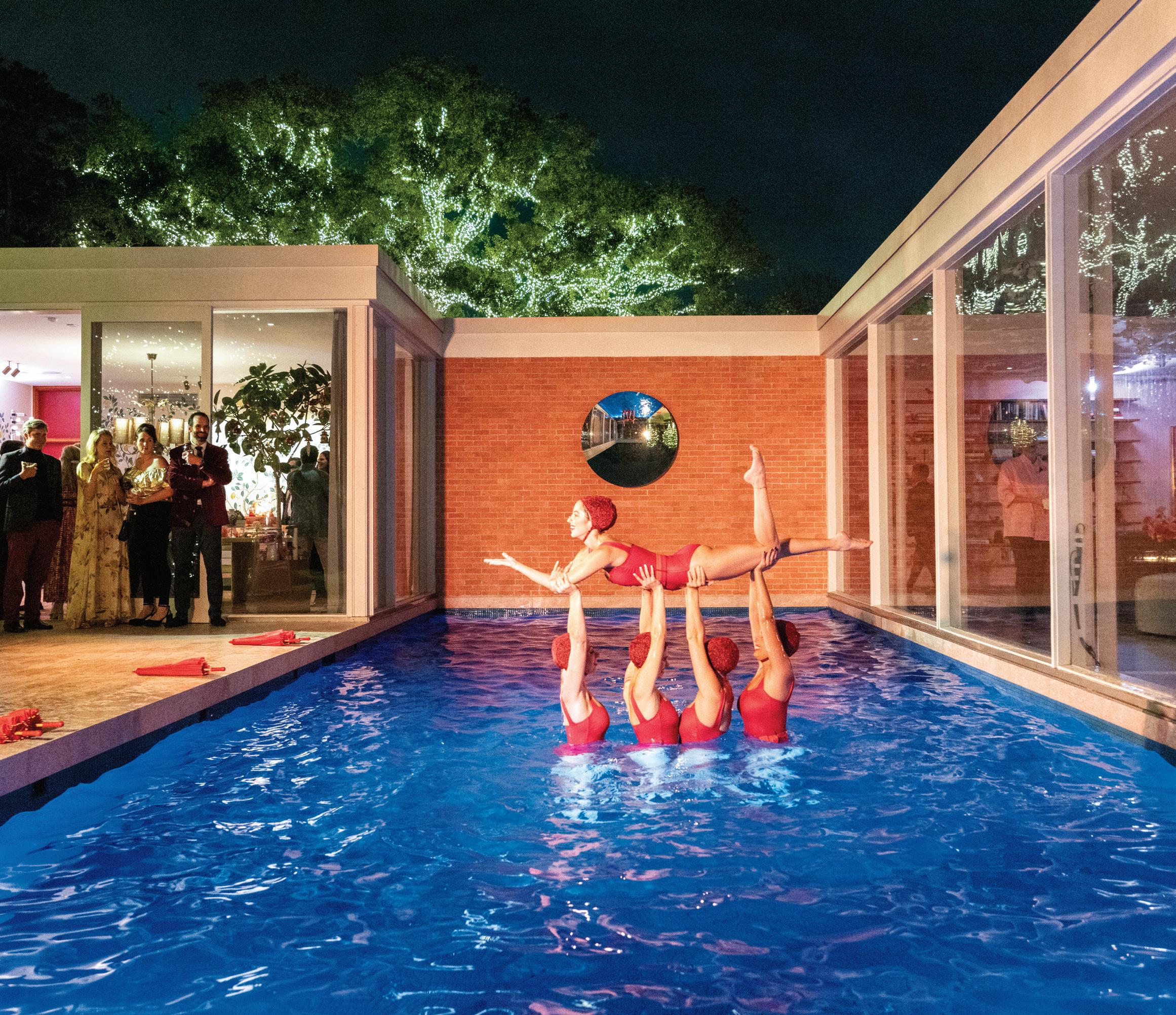
PREVIOUS PAGE: “I like lots of color, bold statements, big jewelry, loud music, and strong drinks,” says event designer Rebecca Gardner. THIS PAGE: “There is a moment during every party I’ve ever planned when guests are surprised by something I’ve set in motion, and somehow, I’m surprised, too,” Rebecca says.
Hunt.” This bizarre and indecisive theme was complete with custom koozies. When it comes to birthdays, I always take the cake.
Tell us more about the philosophy behind things you source, design, and collect for your online shop, housesandparties.com. What makes the cut?
We sell treasures you can’t find anywhere else—things designed especially for our clients, who are devotees of the elegant and unusual. It could be a party hat shaped like a cornucopia, party crackers filled with outrageous prompts, or a set of Ostentatious Sticker Jewelry. I want my customers to
shop and smile so much their cheeks hurt. It all ensures your party will be a success.
We’d love to hear how you’d envision a party where flowers are the star of the show.
I have a party dream to host a long list of girlfriends for a luxurious, lingering lunch at a peony farm on Long Island. One long table, sunken into a carpet of pink petals, would nestle between rows of bursting flowers. I imagine the arrangements marching down the table and all my guests in various shades of pink. Icy pink Champagne, lunch in a summer bento box, and heads thrown back with unabashed laughter.
BY
PHOTO
ADAM KUEHL

“Every party needs a Pied Piper. It’s usually me, but it can be anyone with charisma who’s amenable to assuming the role.”
—REBECCA GARDNER

BY ADAM
“A seated affair calls for silver cream and spray starch…use luncheon napkins for dinner and soup spoons for dessert. No one (except maybe your mother-in-law) cares, as long as it’s attractive and functional,” Rebecca counsels.
PHOTO
KUEHL

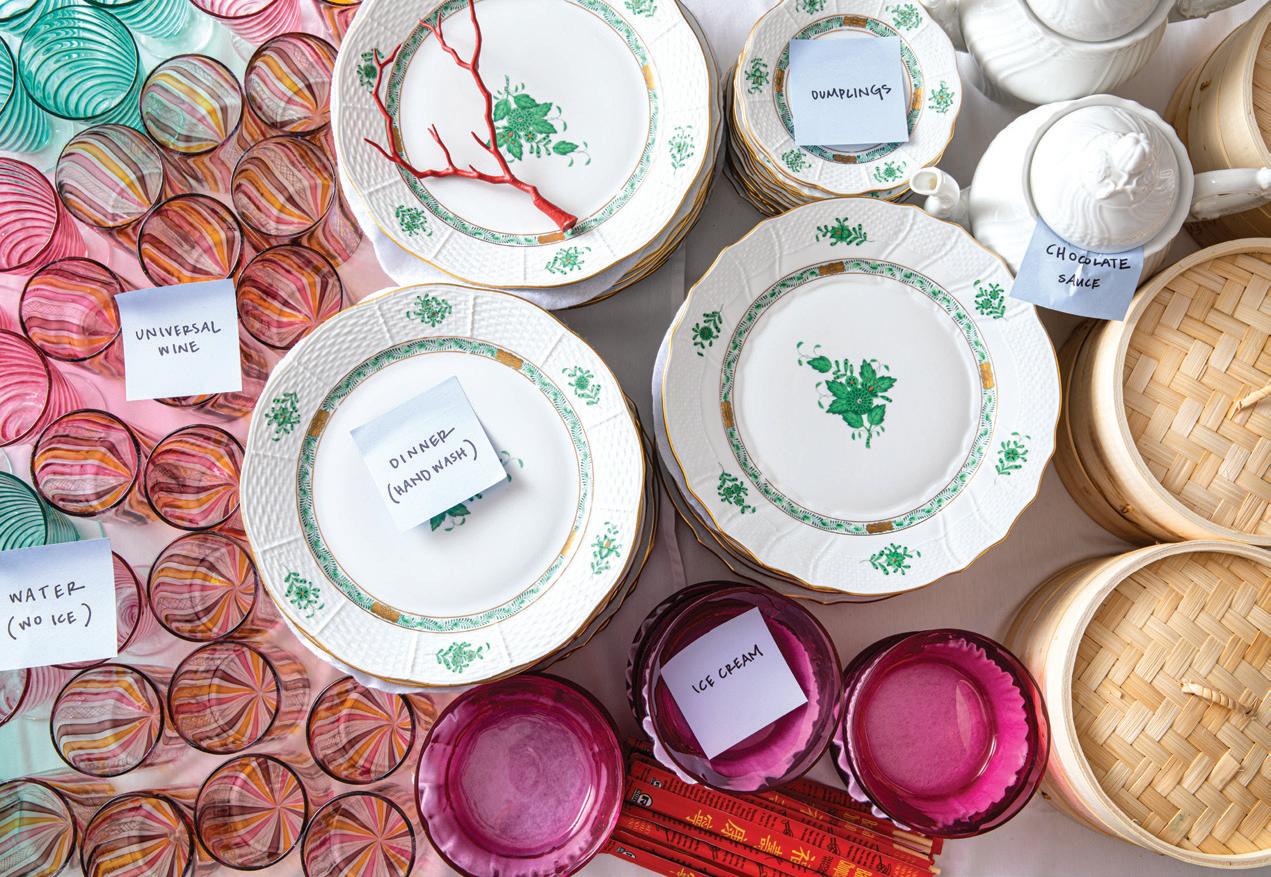
“Intention is everything, and your choices—be they white-jacketed waiters or bountiful platters passed family style—will show people how you want them to feel,” Rebecca says. “Plan like Patton to decrease your margin of error and then at some point, as they say in Alabama, ‘Let go and let God.’ Effort is the key. Effortless is the look.”


REBECCA’S QUICK TAKES
Favorite reason to entertain at home: Nothing is more intimate. It’s an excellent way to make new friends—fast.
How I flower: Everything I use comes from Dutch Flower Line in New York. I don’t garden, and I want insanely special flowers.
House cocktail: A classic margarita. Nothing gets the party going like tequila. I’m a Texan, after all.
Go-to menu: Comfort food and lots of options for picky eaters—fried chicken, a sinful starch, a leafy green salad, roasted vegetables, and a monumental dessert. Outsource and delegate. You don’t have to make everything happen yourself.
Three things you’ll always find at my parties: Low lighting, strong drinks, and thoughtful introductions to new people.
Best cure for pre-party jitters: A glass of white wine on an empty stomach.
The best guest always: Makes an effort to mingle and talk to everyone.
When I’m the guest: I always bring classic cheese straws from my shop. They’re the perfect combo of salty and spicy—and they’re very crispy. I also write a note to the host the next day.
If I could grab only five items from the grocery store for a last-minute cocktail party, I’d buy: The best Champagne in the store, a dry white wine, frozen pigs in a blanket, sugar snap peas, and a huge chunk of Parmesan. Serve the nibbles in various pretty bowls, and concentrate on the conversation.
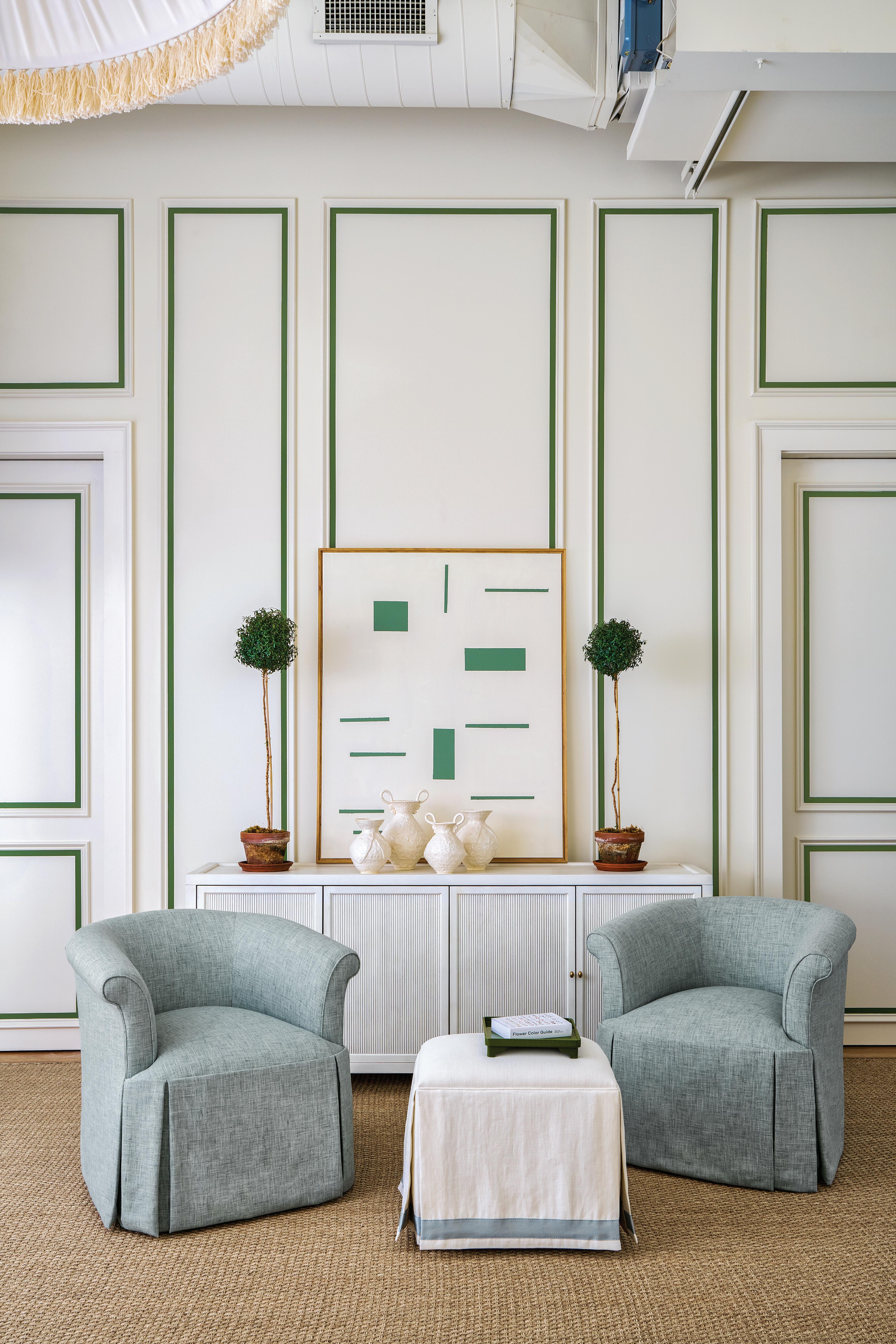

One Enchanted Evening
At their home in Birmingham, Alabama, FLOWER Editor-in-Chief Margot Shaw and husband Gates welcome designers near and far to a picture-perfect garden party.
BY CATHY STILL MCGOWIN | PRODUCED
AMANDA SMITH FOWLER | PHOTOGRAPHY
BY
BY DAVID HILLEGAS
FLORAL DESIGN BY SYBIL SYLVESTER



“People
want to feel the real gift of hospitality. Birmingham is a gardening town filled with elegant hostesses who love to throw polished parties brimming with beautiful flowers. It’s fun to share that part of our city’s reputation.”
—MARGOT SHAW
October is one of the most magical months in Birmingham, Alabama. The days are still warm, and the nights are just chilly enough for a light sweater. Gardens are even more vibrant beneath aster blue skies—professing their love for the temperate season with their last blooms before the November frost. It’s the perfect time for outdoor entertaining—and an especially good time to share Southern hospitality with guests arriving to savor the Birmingham Botanical Gardens’ Antiques at the Gardens, an event that draws designers, tastemakers, and aficionados of style to the city.
“There’s nothing better than entertaining at home,” says FLOWER Editor-in-Chief Margot Shaw. “When you open your home, you are sharing more of yourself, the place you live, and your personality.”
Margot and her husband, Gates, live in a 1940s Dutch cottage with farmhouse underpinnings filled with color and curiosities. On shelves and tabletops, they display collections from travels, along with family heirlooms. “There’s nothing fancy about it,” Margot says. “It’s a comfortable atmosphere for having fun and sharing interesting conversation.”
Well-practiced in the art of entertaining with grace, Margot says there’s no greater compliment to a hostess than having guests who truly feel at ease. She and Gates have an unassuming elegance that is as sophisticated as it is welcoming. “When we learned that Kravet was the fabric sponsor for the 2024 Antiques at the Gardens, we wanted to plan a party with them in anticipation of the event,” Margot says. “A garden party was an intimate way to share a part of our lives with guests.”
To set the convivial scene, Margot collaborated with Lee Jofa to

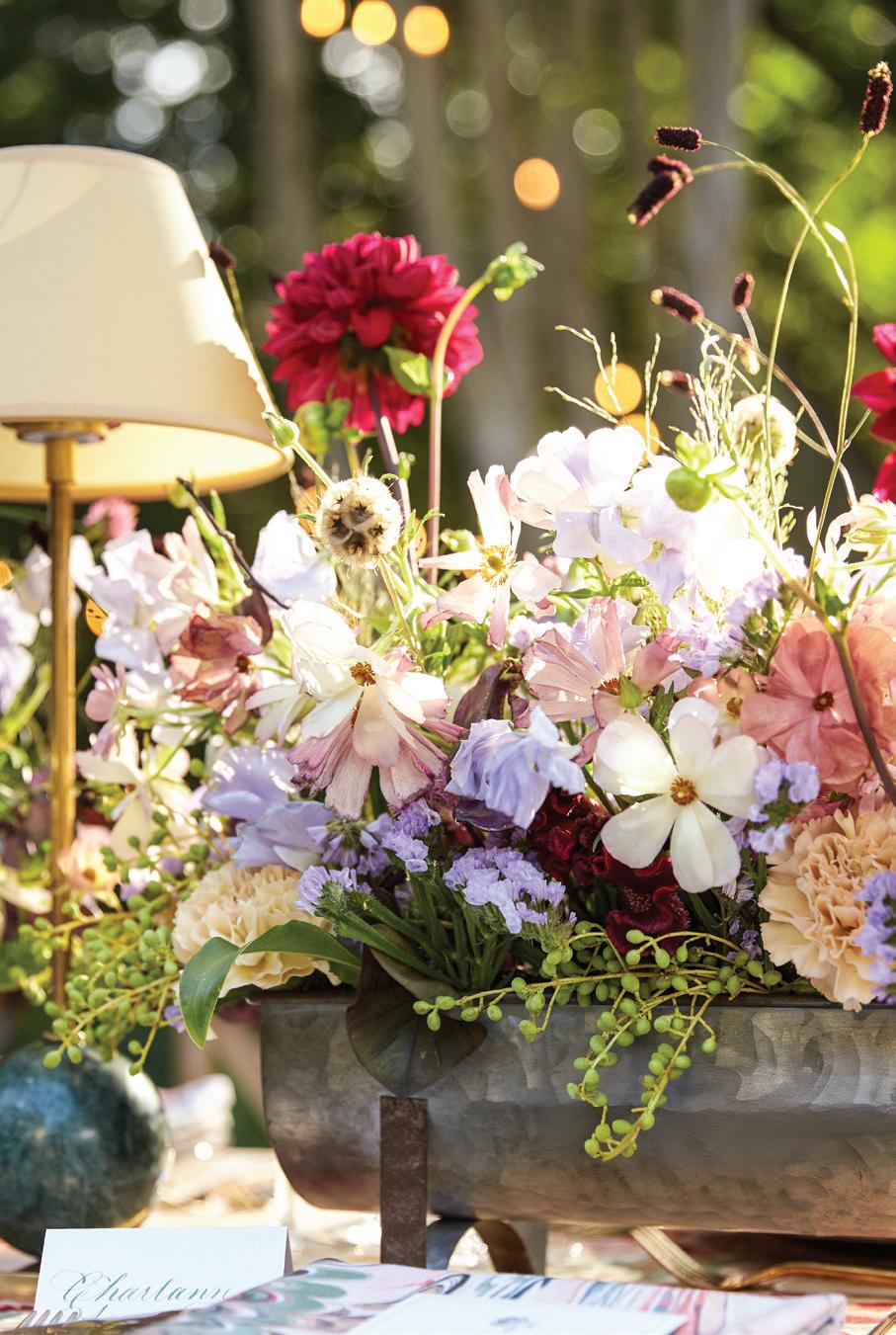
PREVIOUS PAGE: The hues of Kravet’s recent introduction, Garden Walk by Lee Jofa, drove the warm palette. THIS PAGE, CLOCKWISE FROM TOP LEFT: Margot’s antique carousel giraffe, an heirloom inherited from her great grandmother, playfully greets guests with a bouquet of butterfly ranunculus. • Margot and Gates welcome guests to the garden-themed dinner. • Floral designer Sybil Sylvester created blousy compositions for a fresh-cut effect. Cordless table lamps from Pooky served as chic substitutes for candlelight.



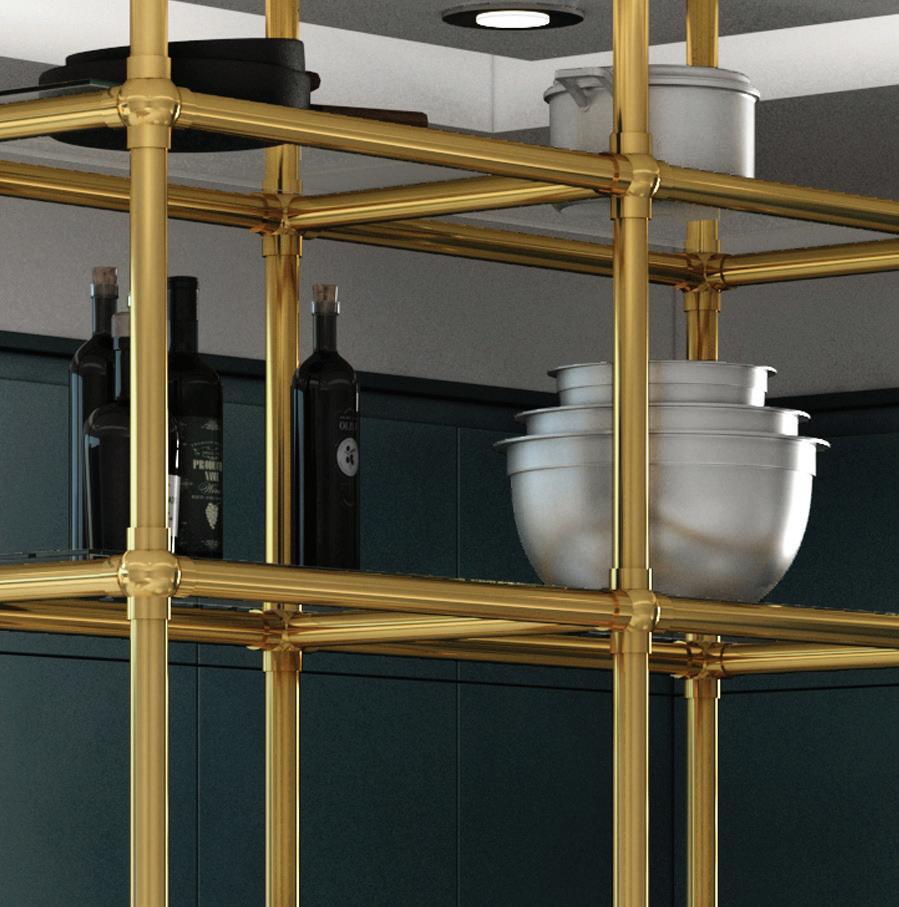

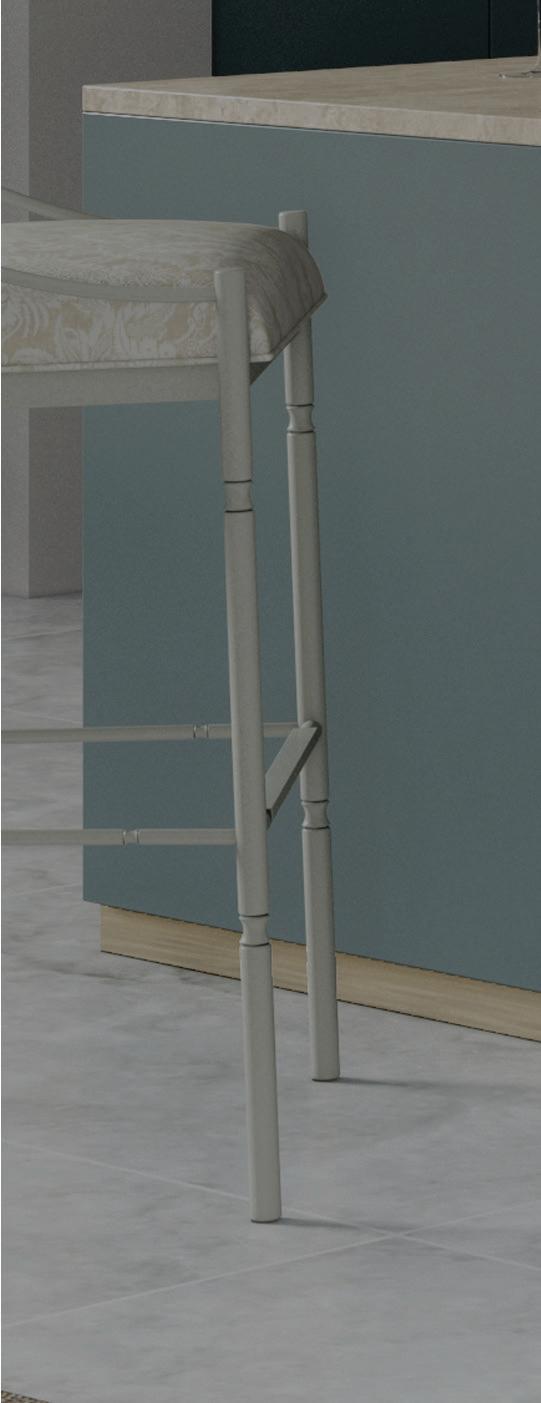


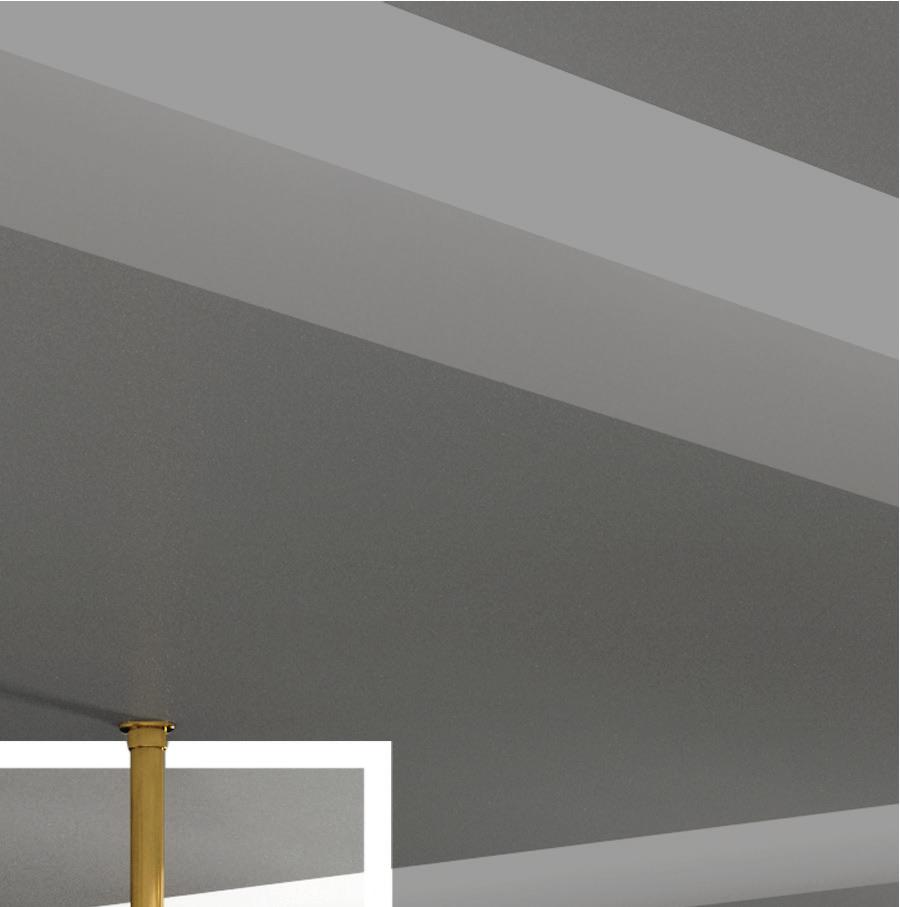
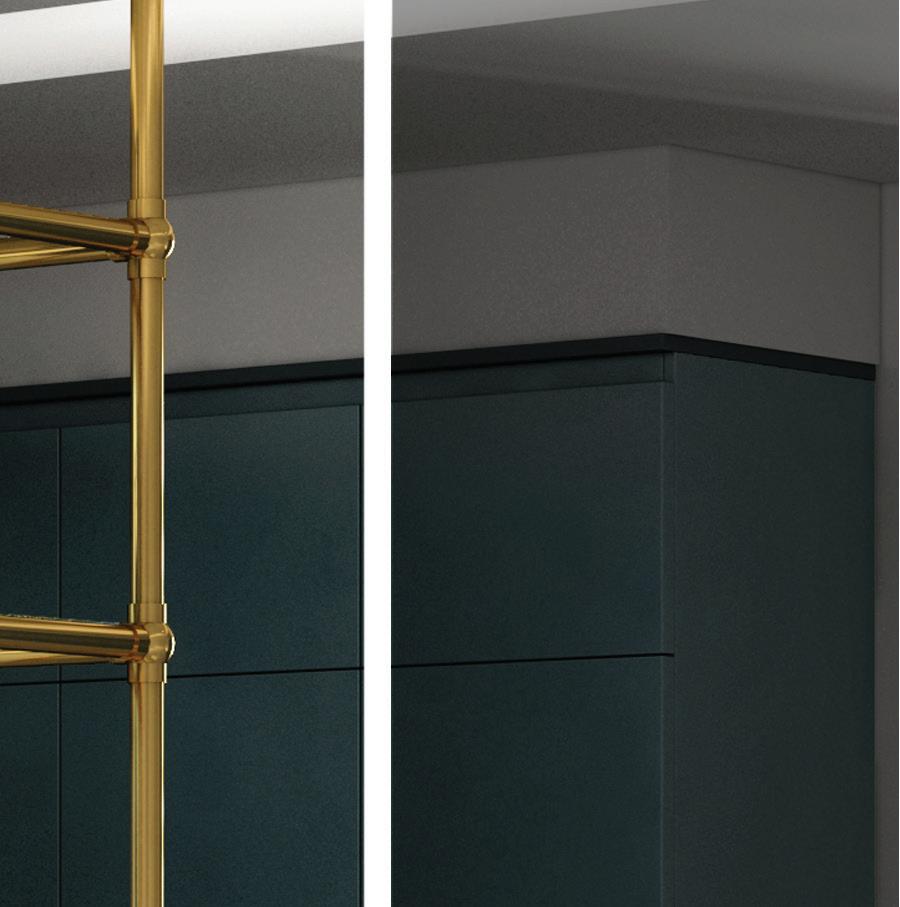





Before the seated dinner, guests mingled over beverages. “I always ask servers to pass drinks on trays,” says Margot. “There’s nothing worse than people getting stuck in line at a bar.”
showcase their new fabric collection, Garden Walk. Letterpress invitations hinted at the party’s scheme with envelope liners reproducing the Taplow Print in Juniper/Petal, a design that was also used for dinner napkins. Yardage of Posy Print in Berry/Leaf, a pattern of flowering vines and birds in a batik-inspired design, became custom tablecloths for the 40-foot-long table. Above, a strand of Pooky shades of small ikat-spot linen by GP&J Baker provided overhead lighting.
Florals by Sybil Sylvester complemented the scheme. “The fabrics directed my color choices in loose, airy arrangements that looked like they had been snipped straight from the garden,” Sybil says. To underscore that fresh-cut effect, she chose galvanized containers that recall the look of French flower buckets and filled them with a medley of butterfly ranunculus, sweet peas, gomphrena, scabiosa pods, carnations, coxcomb, statice, stock, sedum, hyacinth bean vine, and privet berry. Dahlias were supplied by a local grower. “We mixed in greenery cut from friends’ yards (with permission of course!), along with hosta and hellebore leaves clipped from Margot’s garden,” Sybil says. “The addition of explosion grass and Sanguisorba created a natural garden feel.” Bouquets lined the center of the table, interspersed with Pooky’s Lollie cordless table lamps.
As the three-piece band warmed up and Chef Chris Hastings and his team prepped the food, guests began to arrive in the early evening hour. Margot, Gates, and Scott Kravet, the chief creative officer of Kravet Inc., took their places to greet the crowd. “It’s fun to introduce interesting, talented people to each other and watch the sparks,” Margot says. “We had so much talent in our garden sharing tips, tricks, and their latest projects. I wish I could have recorded it.”
ENTERTAINING WITH EASE
Margot credits her mother’s influence, the talented contributors to FLOWER, and her own experiences for her well-honed gifts for entertaining. Here, she shares a few no-fail must-haves for hosting a successful party.
TRUST YOUR CATERER
When you have talented chefs like James Beard Award winner Chris Hastings in your hometown, you can spend time with your guests and be assured that dinner will be fantastic. Also, be sure to order enough food to surpass your headcount. No hostess ever wants to run out—and guests will welcome to-go boxes.
CALL IN THE PROS
I enjoy doing my own flowers, but for this party, I leaned on trusted friend and FLOWER contributor Sybil Sylvester. We’ve worked together so many times that I don’t ever need to give direction.
OFFER A VARIETY OF REFRESHMENTS
Not everyone wants a cocktail, wine, or Champagne when they arrive. In addition to alcoholic beverages, I always offer sparkling water and spirit-free alternatives.
SET THE MOOD WITH MUSIC
Whether you devise your own playlist or hire a DJ or band, background music is essential. Consider your audience. Some of my favorite playlists include modern R&B, jazz, and old standards with a few showtunes mixed in.

Introducing Caesarstone ICON™
Crafted with advanced fusion materials, the kitchen has been reimagined, the bathroom, redefined, and the workspace, reborn. Discover an environmentally sustainable collection offering intriguing layers, flowing textures, and a color palette inspired by Mother Nature herself.

8521 Wild Taj
8477 Ocean Sage


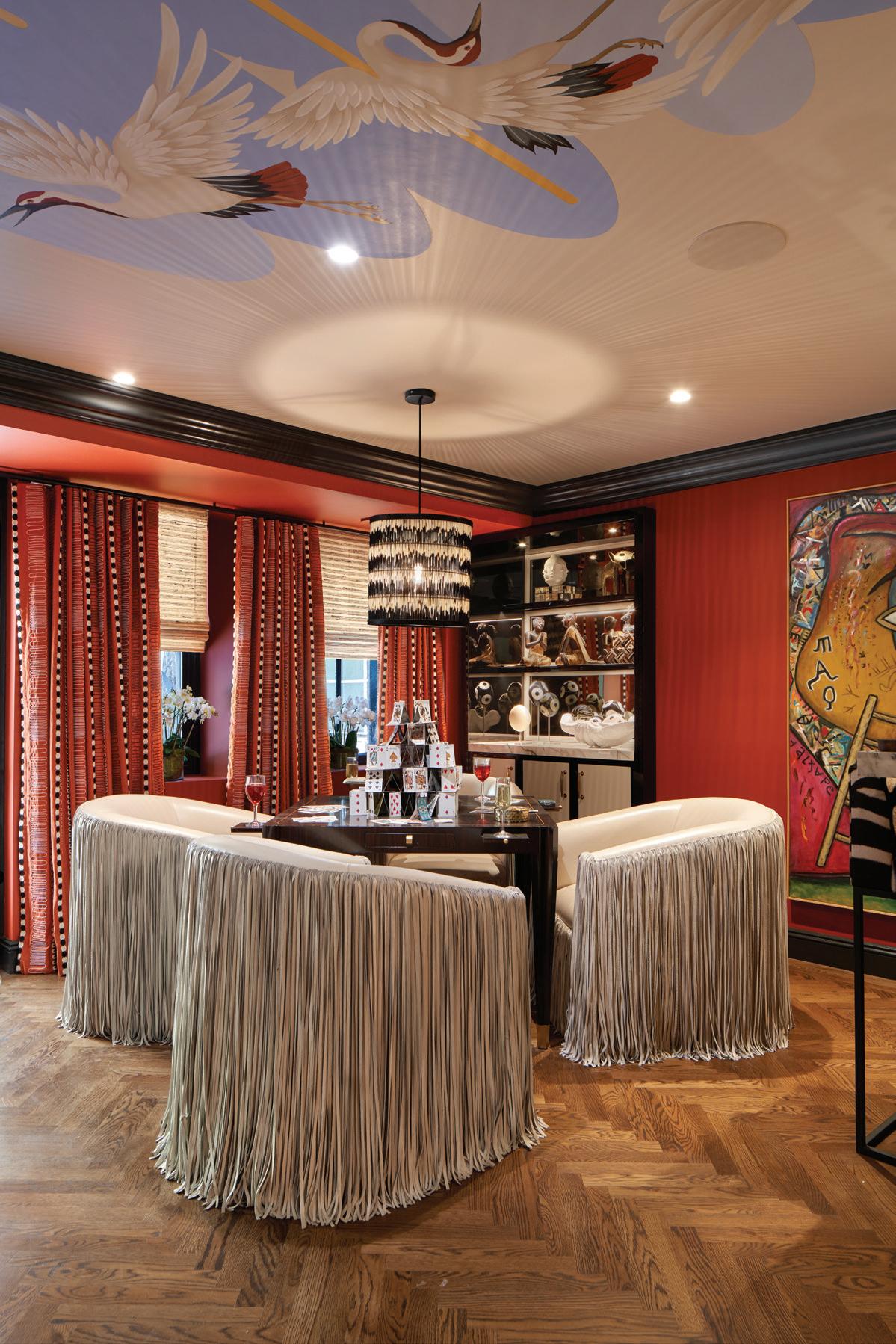




Custom Architectural Metalwork


Tracy Wind Photography
Lauren Vallario Designs

Floor & Ceiling: Foundation Collection #6
Photo: Joseph Bradshaw
Designer: Cara Brock Interiors Builder: Trace Construction

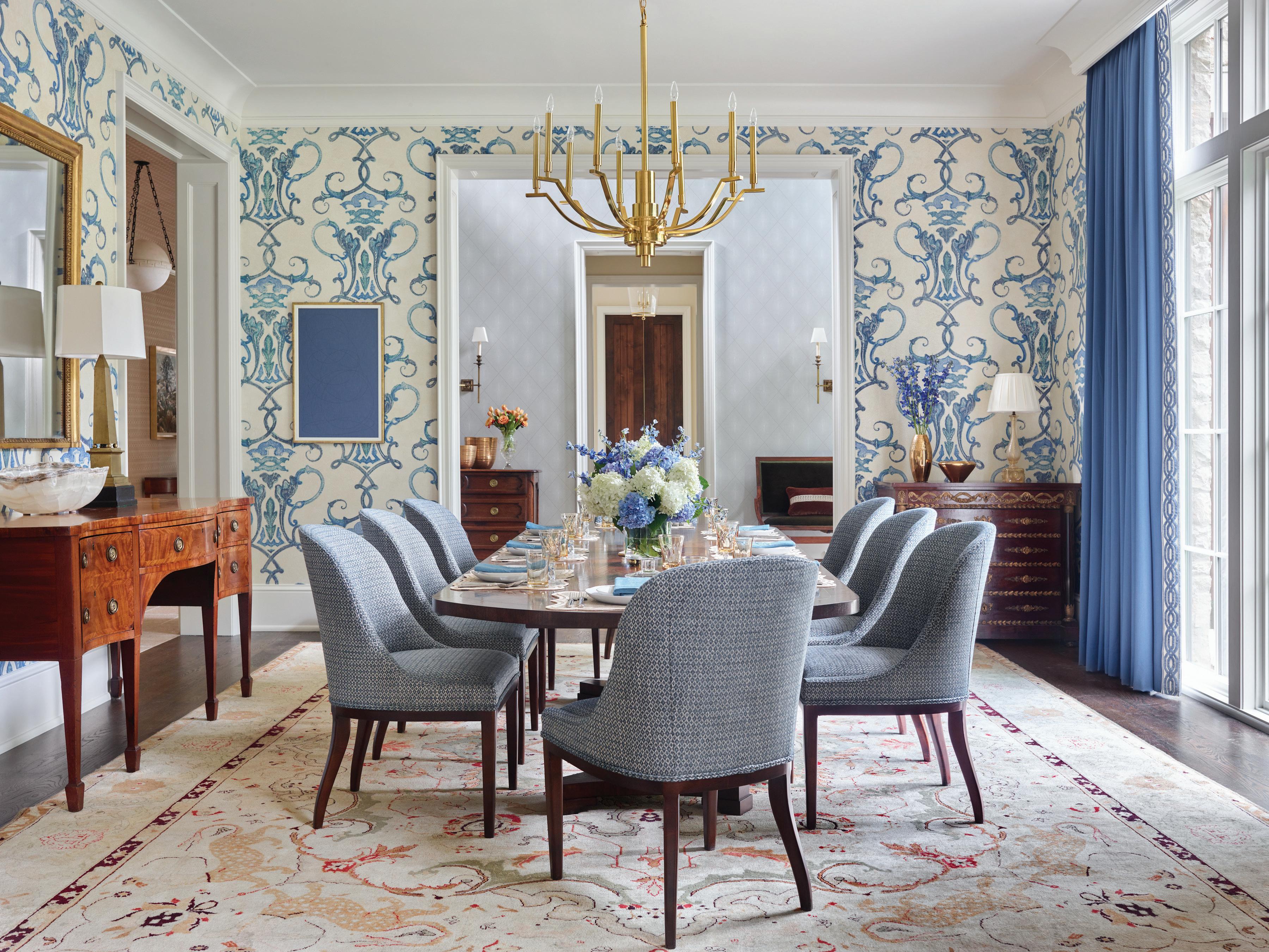



Design Come True
Lifestyle editor Alice Doyle entrusts interior designer Danielle Balanis to help her check off the long wish list she’d accumulated after years of living in her historic Mediterranean Revival house in Birmingham.
BY ALICE WELSH DOYLE | PHOTOGRAPHY BY DAVID HILLEGAS | FLORAL
DESIGN BY MARK THOMPSON

Henry, meet Chronos.
It’s one thing to read and write about something you love; it’s entirely different to practice the craft. I’ve been writing and producing stories about interior design, architecture, gardens, and entertaining for over 30 years. You’d think by now I’d be very clear about how I wanted my own home to look and live, but the opposite was true. Being exposed to a variety of styles and talents only made it more challenging to make my own decisions.
When my husband Liam and I found this 1925 Mediterranean Revival home in our favorite Birmingham neighborhood, Forest Park, we knew we wanted to buy it. The original house had been remodeled by the previous owner into a four-bedroom, fourbath while keeping the classic bones, original floors, and a wall of French doors that flooded the living spaces with light. With the architectural and structural renovations in place, it was time to bring in more color to the mostly neutral palette and add better livability and more “wow” moments.
I first met designer Danielle Balanis while on an assignment and felt an instant connection with her exuberant decorating style. That she loves fashion as much as I do only further solidified our kindred-spirit status. It dawned on me that she was the designer who could guide me through my indecision and push me a bit out of my comfort zone. As you’d expect, I’d amassed piles of magazine clippings, website links, and other ideas to sift through. Liam and I also wanted to keep many pieces we already owned. Danielle was game for combining both the old and the new, so our collaboration began.
The architectural style of the house guided many of our design decisions. Blues inspired by the Mediterranean Sea and my collection of Chinese porcelain provided a natural starting point for the palette. One of the first challenges we addressed was the furniture arrangement in the living room. With so many French doors, placement was tricky. Contributing to the dilemma were pieces I’d purchased for a home in our former city. Eschewing a sectional, I’d splurged on two 7-foot-long matching sofas. When we moved back to Birmingham, they


PREVIOUS PAGE: The formerly sterile living room became a layered, comfortable area with seating options and a mix of textures, prints, and furniture styles pulled together by a black lacquer Chinois screen and a silk B. Viz suzani throw.
THIS PAGE, TOP TO BOTTOM: Interior designer Danielle Balanis (left) and myself. • A glass coffee table makes an assortment of collectibles stand out, including a silver, monogrammed change purse that was the first gift my grandmother received from my grandfather and an unused Stork Club matchbook from my bon vivant godfather.
My books reflect my dual loves of fashion and interior design.






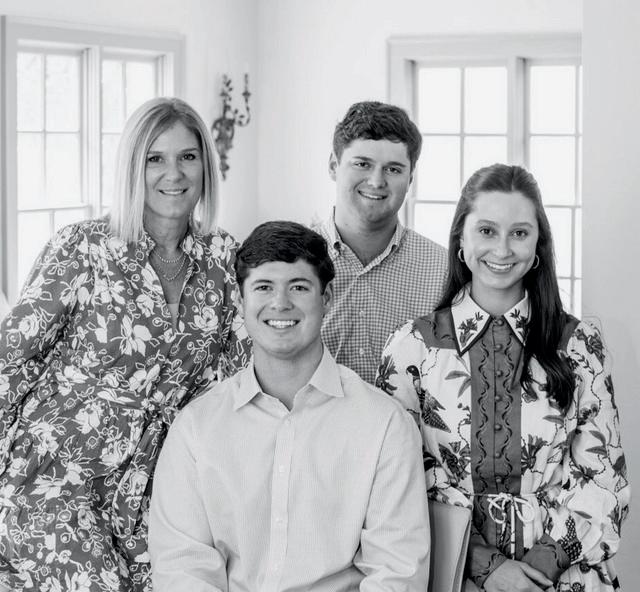







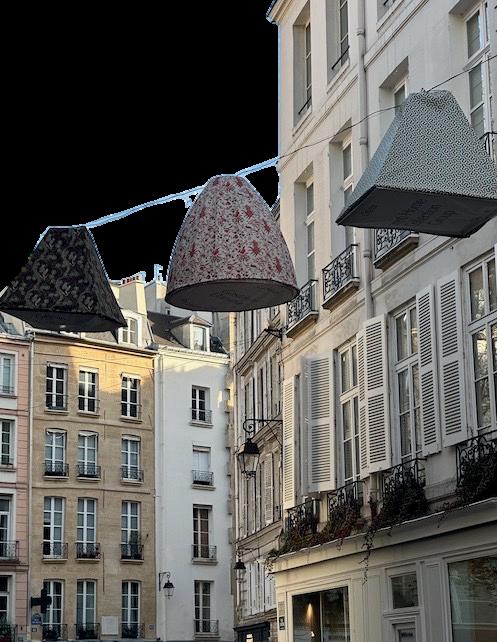

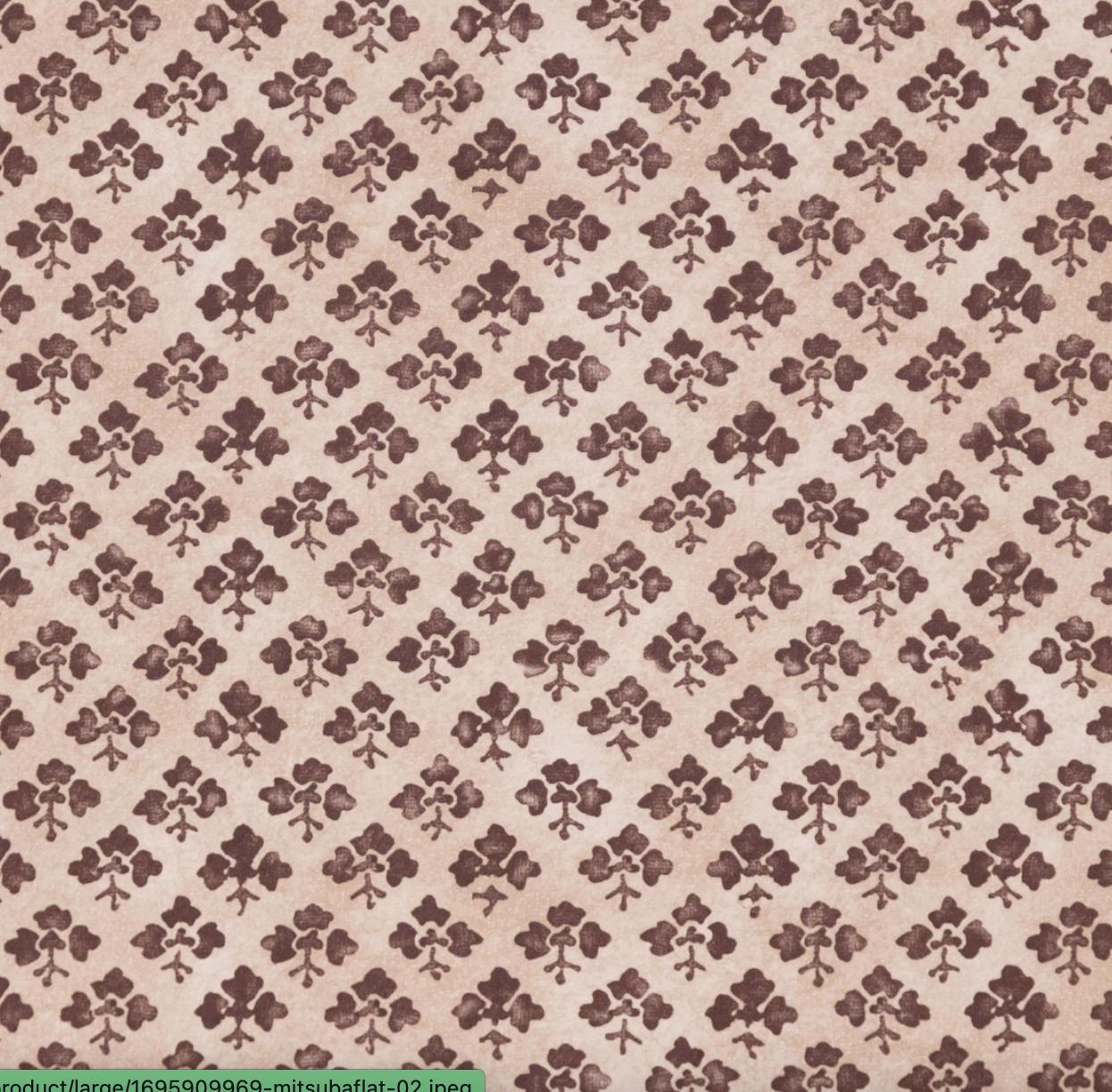



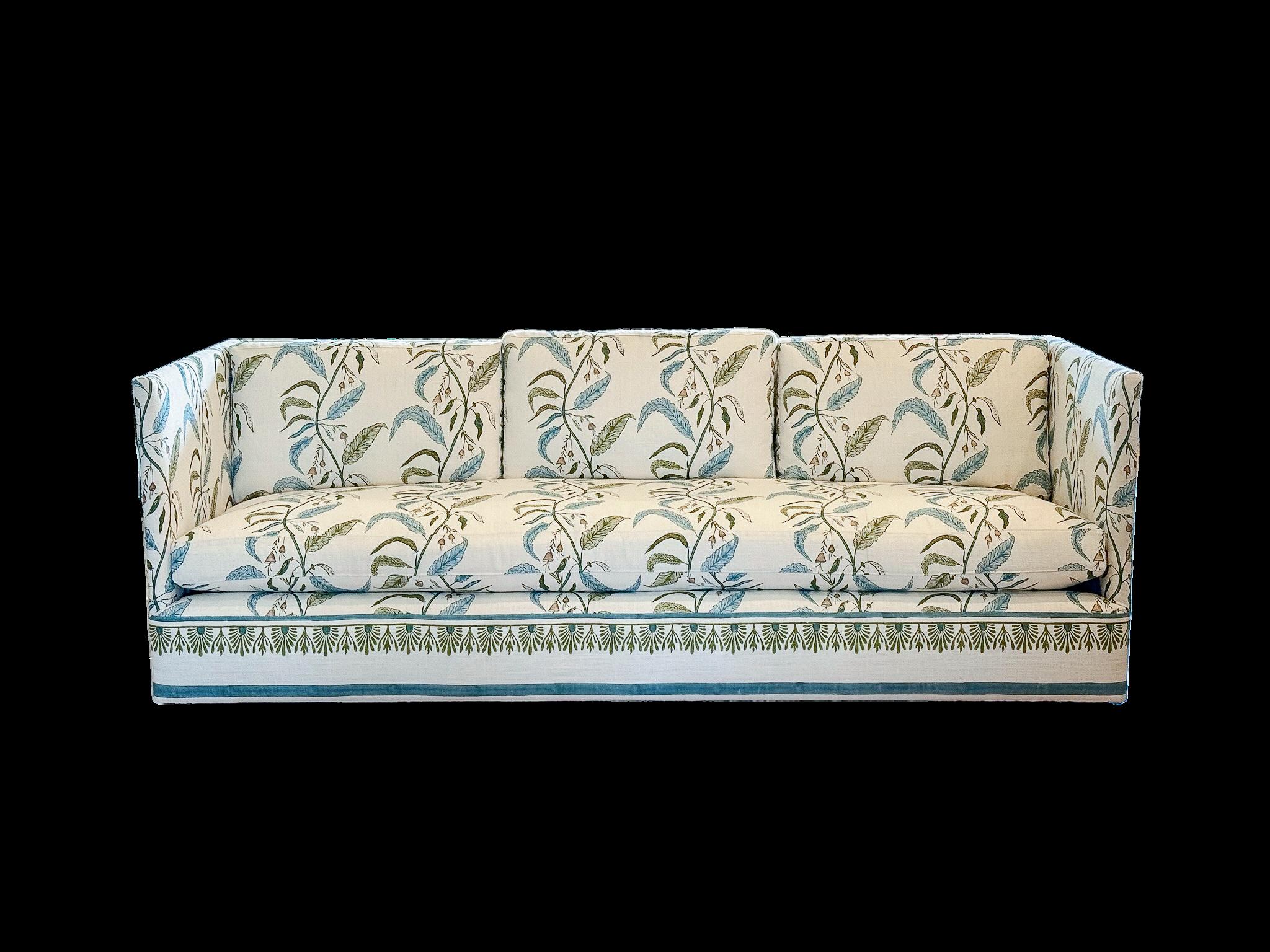

“I’d always dreamed of living in this style of architecture with its plaster walls, red tile roofs, wrought iron, and exoticism—it’s not typical in the deep South.”
—ALICE DOYLE


landed in the living room, commanding most of the real estate. While I’d tried to make both sofas work for years, Danielle figured out an inviting furniture plan for the space within days—albeit using only one of the sofas. Her proposal was so compelling, it gave me the “permission” I needed to retire the other sofa. As a result, we now have multiple seating options—two chairs, a love seat, a bench, and of course, the remaining sofa reupholstered in a luxurious blue velvet.
Since we first moved in, I’d longed to give the adjoining dining area its own character with blue-and-white tile wainscoting, similar to treatments in other Mediterranean houses of this age. Danielle found two patterns we laid in an alternating design, and now they look like they’ve always been here. Although I’ll never tire of my hand-crafted dining room table (a sizeable investment early in our marriage), the chairs cried out for attention. They were originally upholstered in a putty-colored vinyl I’d vowed to replace as soon as possible. However, with a toddler at the time, I quickly realized how convenient they were to wipe down. Our son Declan turned 19 before the chairs were finally reupholstered with the same velvet used for the sofa.
Danielle kept them out of the “too matchy” zone by covering the backs with a patterned fabric and enhancing their silhouettes with an outline of ivory ribbon.
While I lean classic, I do like a dash or two of the unexpected—and Danielle found that perfect balance. One of the first things she sourced was a pair of Moroccan-themed vintage sconces, which sparked mixing in some spicy colors with the blues—curry, paprika, saffron, and cinnamon, plus a sprinkling of herbal green. Time and again, I’ve written
TOP RIGHT: I’ve always been drawn to Mediterranean Revival architecture.
ABOVE: Danielle transformed the sunroom into a destination with Moroccan Schumacher wallpaper in a metallic sheen for the ceiling and a skirted table made from Pierre Frey fabric.

DESIGN

The dining room lacked color and personality, so Danielle added custom chandelier shades to the existing light fixture and reupholstered the chairs in two fabrics. Bamboo-style lamps were updated with rattan shades while a favorite wrought-iron buffet now features a tailored skirt in an ikat fabric by Pierre Frey.
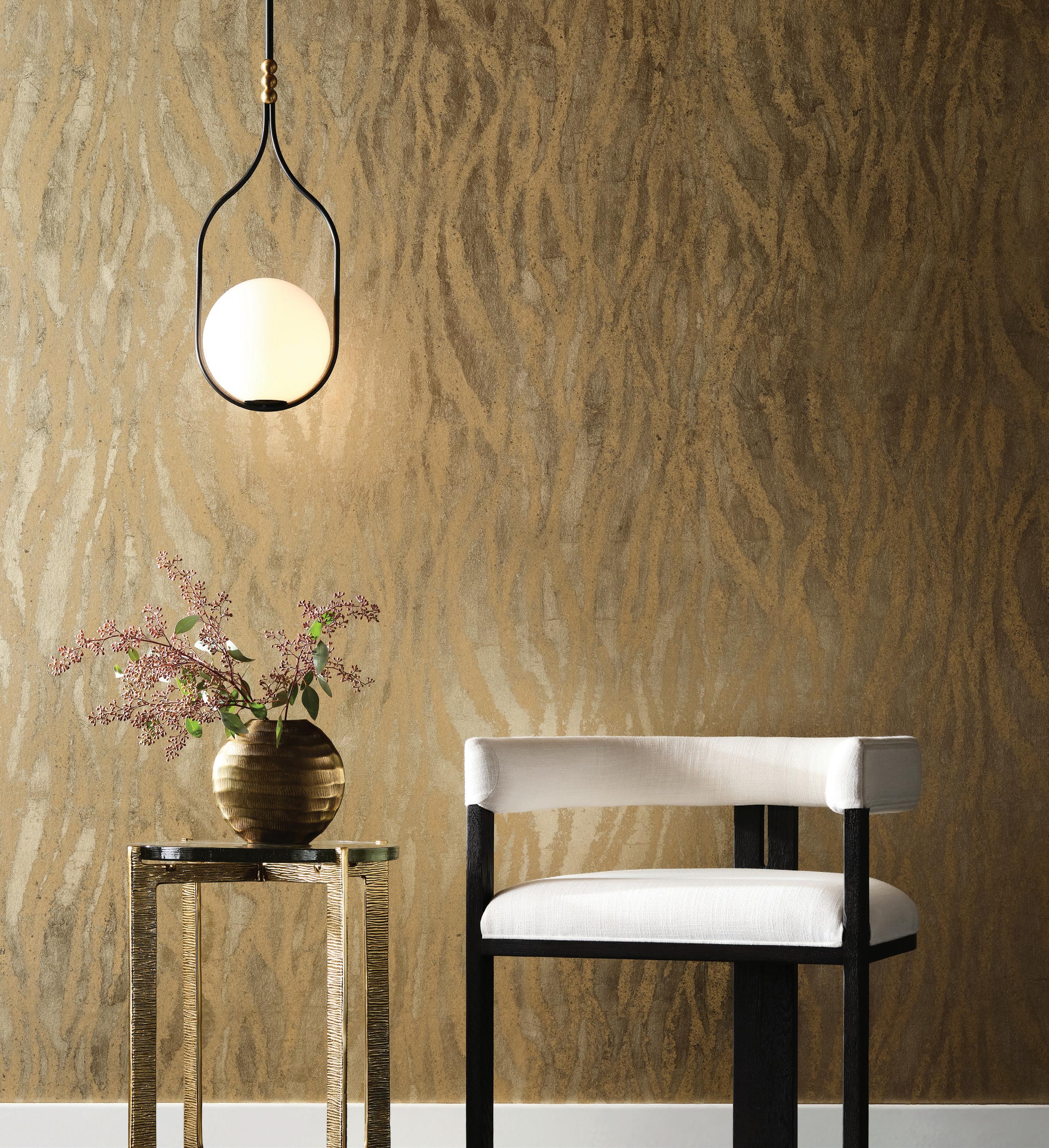

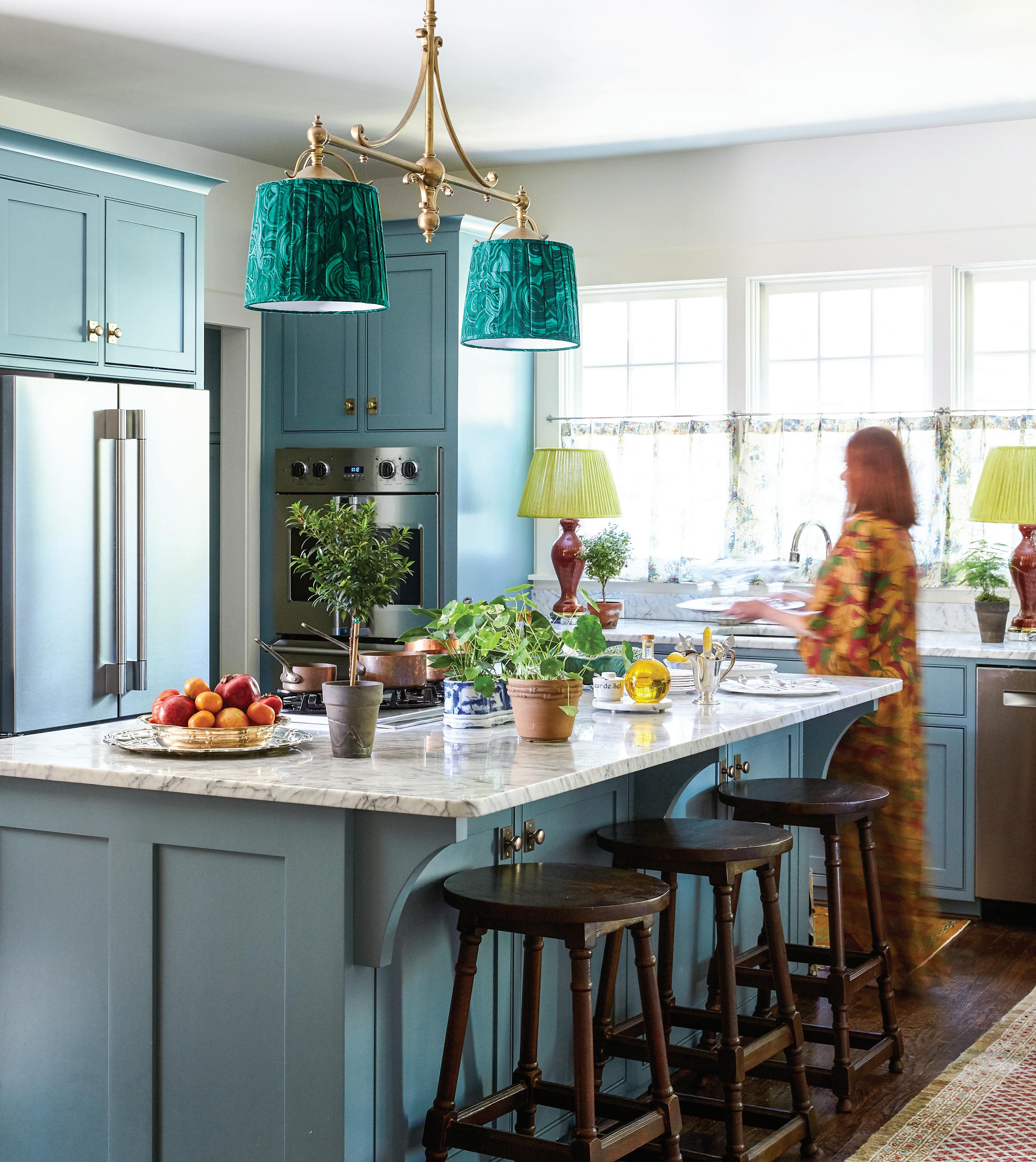
Danielle infused the kitchen with a colorful spirit by painting the kitchen cabinetry Sherwin-Williams ‘Moody Blue.’
A new brass light fixture with custom malachite chandelier shades added a dose of drama.


ABOVE AND OPPOSITE: A gallery wall in the guest room includes family photos, china, my grandmother’s needlework, and a mix of art. Instead of traditional bedside tables, Danielle found these vintage étagères with built-in lighting. The whole bed wall is covered in a Rose Cumming chintz with multi-colored tulips. My grandmother’s desk and my mother’s blue-andwhite porcelain lamp provide a place to work making the room multi-functional.
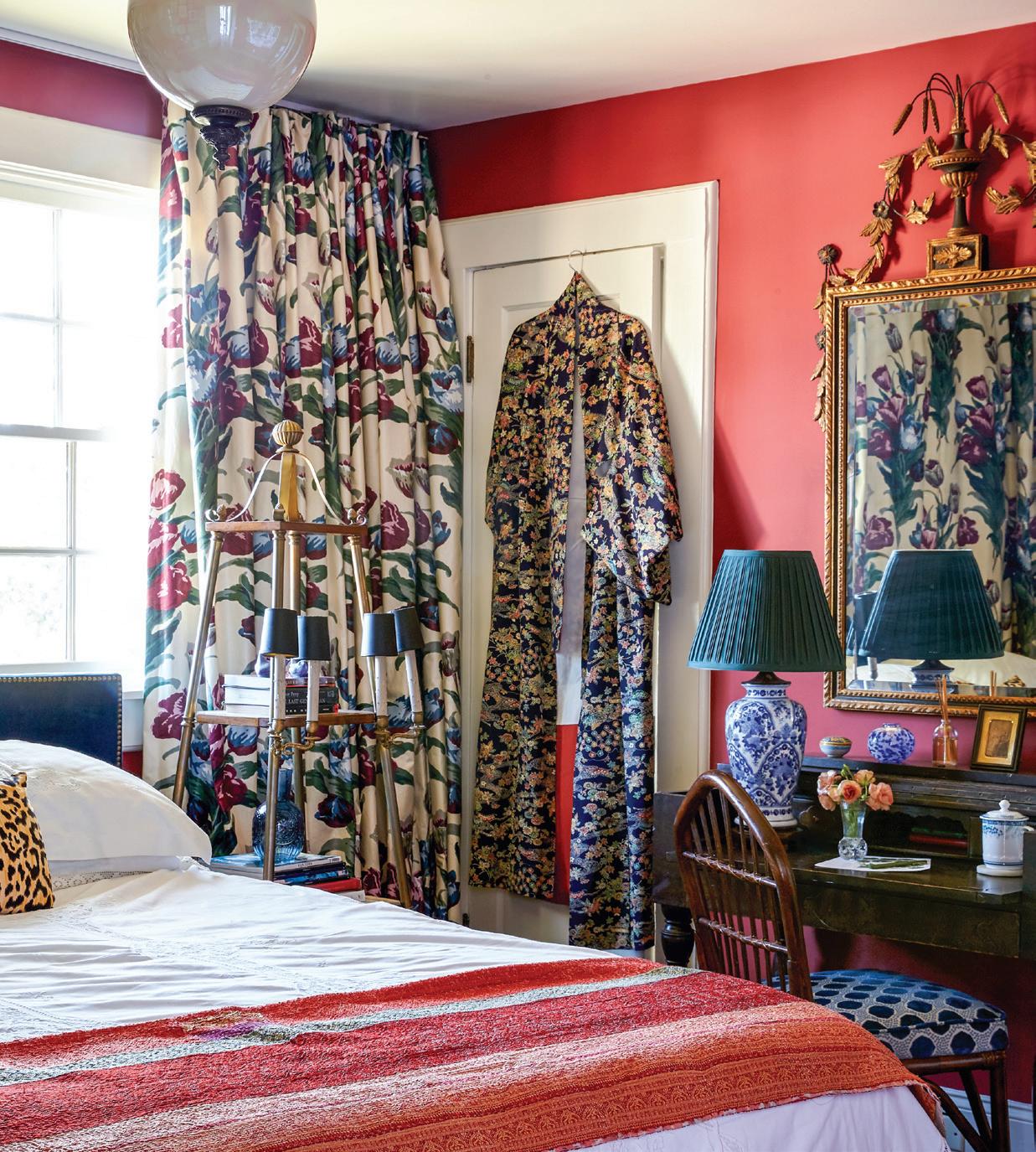
LESSONS LEARNED
about a designer’s process of creating fabric and wallpaper schemes, but it was another thing to experience it firsthand as Danielle fit floral, ikat, animal, paisley, and small geometric prints together like pieces of a puzzle.
We also brought favorite Chinois pieces into the scheme. A vintage Coromandel screen with eight panels gave life to the white expanse of wall behind the velvet sofa, but it also had a very personal significance for me—a similar screen sat in my godmother’s apartment. Even at a young age, I recognized it as something special. I’d always wanted one for myself, and a childhood dream came to fruition at last.
Sometimes at night when the house is quiet, I walk around and reflect on the transformation. Like many homeowners I’ve interviewed over the years, I had to learn to let go and realize my limitations to achieve what I wanted. Lately, I’ve been trying to convince my husband we need a second home in Western North Carolina, perhaps partly so I can have another design experience with Danielle. Thus far that request has been met with only an eye roll, but I’m pretty persistent—there’s always the next decorating story to find, write, and live.
Scale matters: In working with Danielle, I saw firsthand how vital scale is and why I’d made a few mistakes. Designers seem to have an intuitive sense of scale that the rest of us lack. I tended to under scale, but during the process, I embraced the idea of “go big or go home!”
Gallery walls: When you think you’ve collected enough art and accents to create a gallery wall, go ahead and double that. With each piece placed so close together, it takes a lot. During installation, I was often running to my basement to look for more pieces. It also pays to have a professional hang them properly. Practical can be beautiful: This concept is a struggle for us design enthusiasts who often go for a particular look rather than consider daily use. The prior owner had renovated the kitchen, and while we appreciated the large size, the space no longer
had a butler’s pantry. We needed more closed storage. I shared a few ideas I had, and Danielle said, “I think we can do better.” She designed a white oak cabinet with claw-and-ball feet and two sets of double doors that open to reveal pullout drawers and shelves. Door fronts are lined with a floral linen and covered with chicken wire. Interesting hardware adds style to the utility.
A high-low mix: How many times have I seen this phrase in a design magazine? Budget restraints made it a necessity for us, but it didn’t mandate compromise. For example, the brass light fixture with custom shades in the kitchen was a splurge, while Danielle sourced the vintage globe light in the guest bedroom for a low, almost too-good-to-be-true price. A designer who loves the thrill of the hunt was a perfect asset to a project like mine.
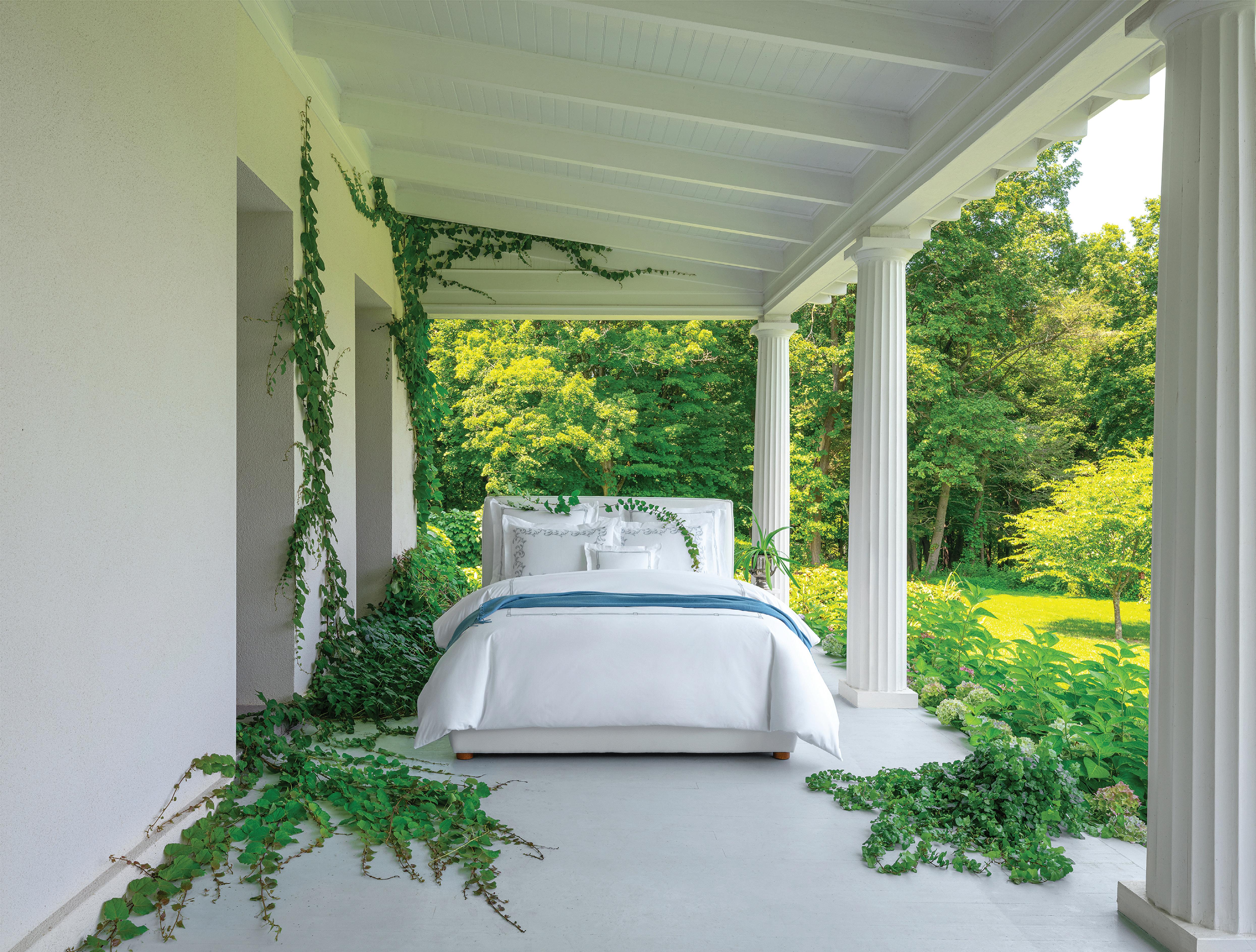



NAADAM
White cardigan. $250
MESTIZA
Daniella skirt. $325
STRATHBERRY
Mosaic bag. $625







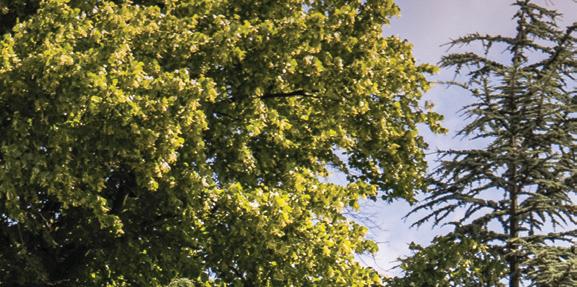





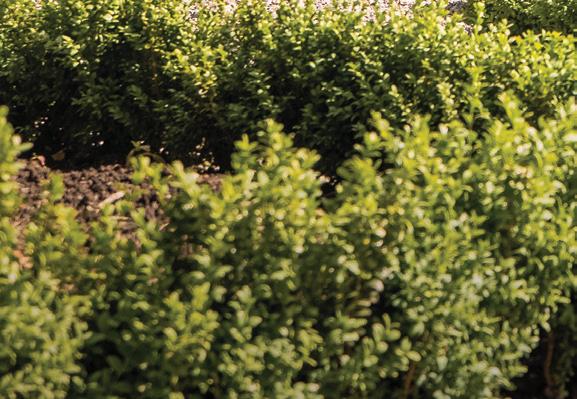























WHAT’S ONLINE
Trending Now at FlowerMag.com




Living Rooms
In an excerpt from his latest book, Design Reimagined: A Fresh and Colorful Take on Timeless Rooms (Rizzoli, 2025), Corey Damen Jenkins shares his expertise in creating living rooms that serve as the heart of the home. Corey believes that versatility is key, especially in living spaces. “After all, it’s where you entertain guests, spend time with family, watch movies, and make memories.” See more at flowermag.com/design-reimagined.

MARVELOUS MUMS
A pot of chrysanthemums on the front porch makes a simple yet showy welcome, but don’t overlook these fall favorites in a vase or in the garden. At flowermag.com/mums, we’re exploring heritage varieties with Melinda Cordell, digging into Naomi Slade’s guide to mums as a garden plant, and looking back at Erin Benzakein’s tips for arranging chrysanthemums.

Relaxed and Refined
Interior designer Jennifer Hunter sets an outdoor table layered with charm for a change-of-season gathering. Enlisting the help of her young daughters, Jennifer planned a laid-back meal under the open sky. Go to flowermag.com/ hunter to find out more about her outdoor entertaining style.
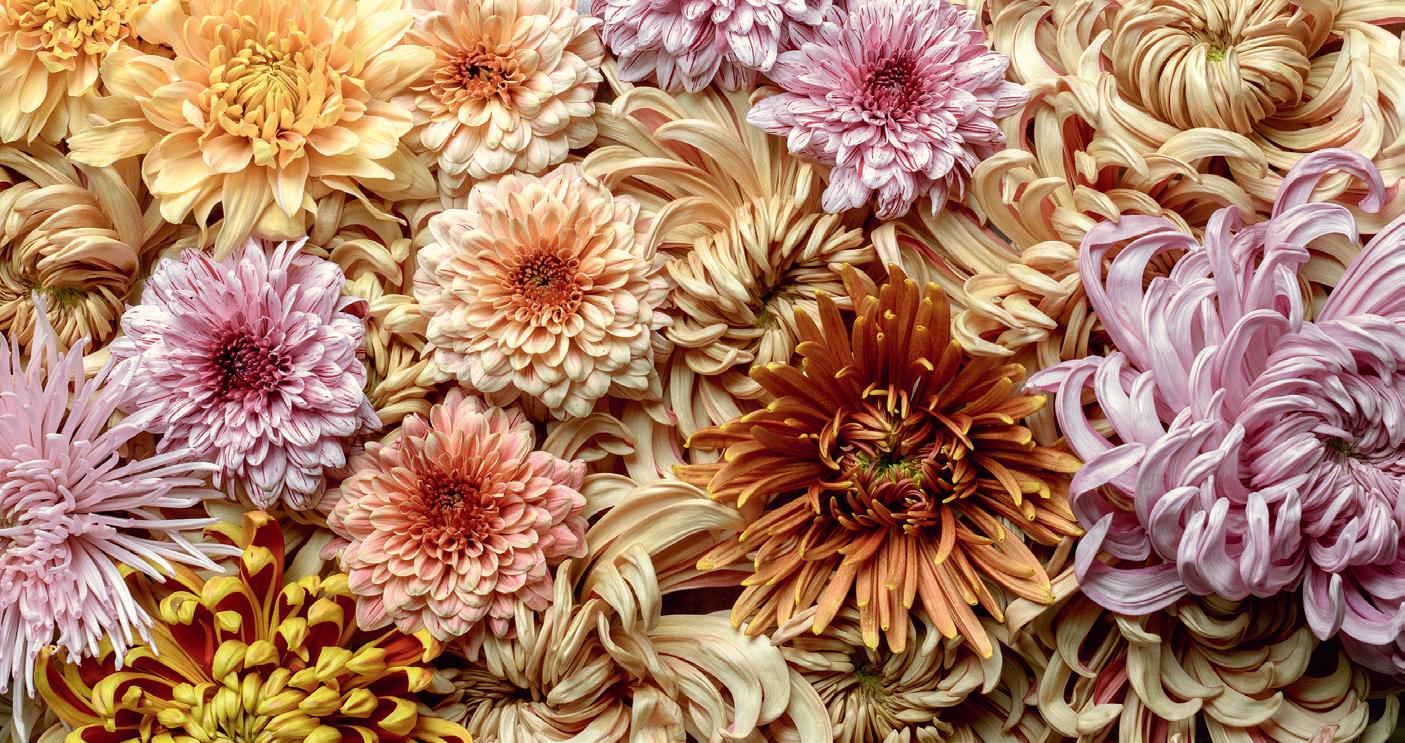

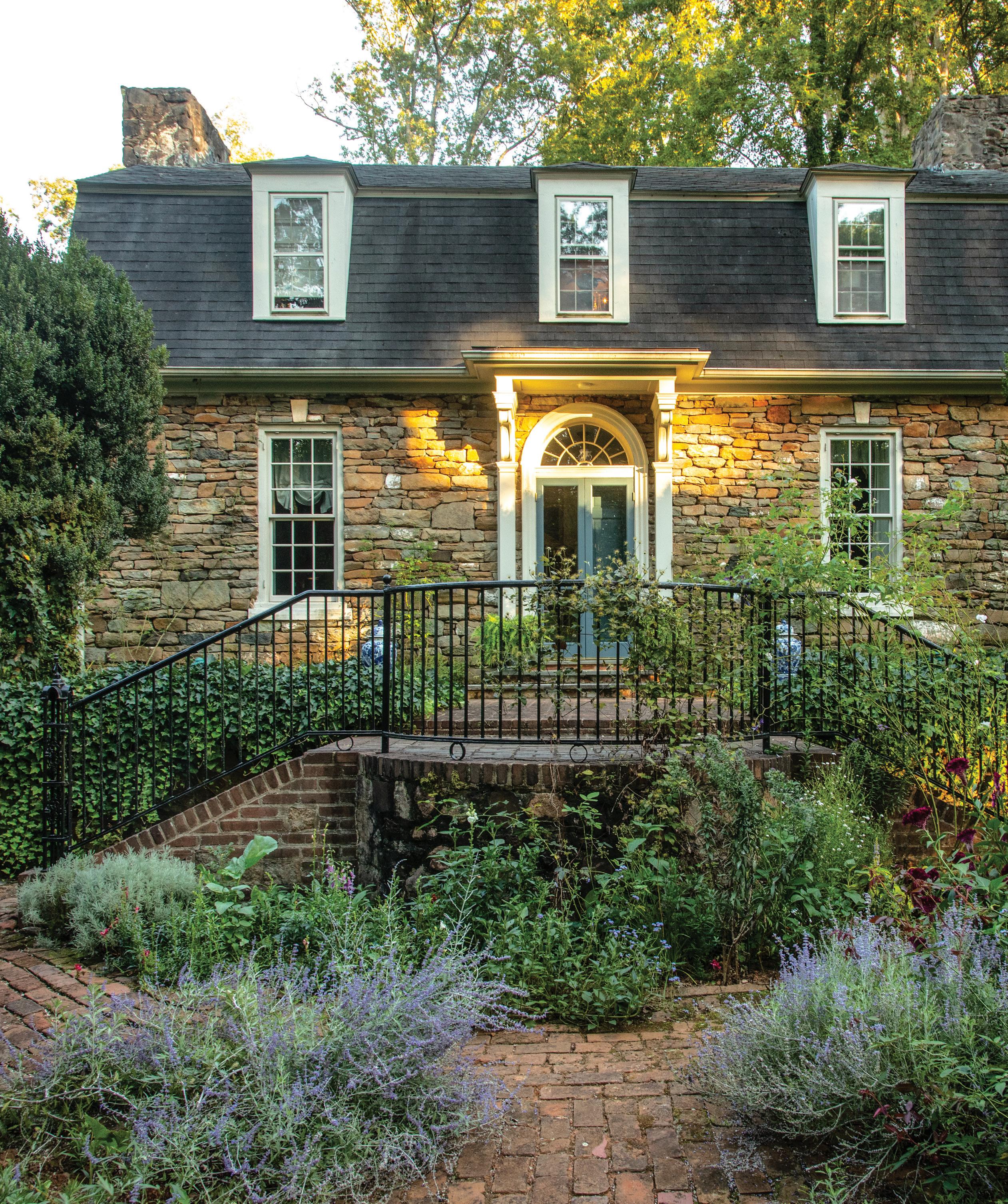
Finding Home
A search for their ideal house took New York designers Michael Devine and Thomas Burak farther afield than originally planned, but in Virginia, they found an idyllic place to land.
BY KAREN CARROLL I PHOTOGRAPHY BY ERIK KVALSVIK



“We were looking for a ‘paint and paper’ house,”
says Michael Devine.
Michael, a textile designer, and Thomas Burak, an interior designer, had already traversed the winding and often stressful road of major renovations in their previous residences in Manhattan and Kinderhook, New York. While both men have an unwavering affection for the old and timeworn—antiques, patina, and vintage textiles are essential elements of their métier—that fondness doesn’t extend to crumbling foundations or antiquated plumbing and electrical systems. “In our next house, we wanted to be done with all that and skip to the fun part—the decorating,” says Thomas.
After a two-year quest for real estate in Connecticut and the Hudson Valley led to one disappointment after another (multiple contracts fell through; other places required too much remodeling), they expanded their scope. “I opened Zillow on my laptop, started in Maine, and worked my way down the Eastern seaboard,” Michael remembers. That virtual journey culminated in Orange, Virginia, with a 1950 stone house nestled on an 8½-acre, mostly wooded lot. Designed by Milton Grigg, a Charlottesville architect renowned for his restoration efforts at Colonial Williamsburg and Monticello, the house had a historic sensibility but required relatively little modification beyond removing and replacing some outdated interior details. It appeared to be a perfect fit at last.
“The house had been in the same family for 70 years, and they maintained it well,” says Thomas. “We also appreciated that they’d incorporated salvaged materials like marble mantels and old floors, which spoke to us.”
Together for over 25 years, Thomas and Michael share an aesthetic love language as well. Both have a passion for European antiques, interiors layered with art, porcelains, and collections, and perhaps above all, textiles. “For me, fabrics are where the character in a room really comes through,” says Thomas, who served as creative director for Schumacher before opening his own decorating business. Michael designs hand-printed fabrics for his own boutique line, Michael Devine Ltd. And that’s only one of the material ways the duo looks to be in lockstep. They’re inveterate hunters and
gatherers of all things decorative, and often find themselves drawn to the same objects when combing through markets such as Brimfield or the Marché aux Puces in Paris.
On an occasion when they don’t see eye-to-eye, as when they began considering and debating a scheme for the entry, “We don’t argue. We’ll just do nothing and wait until one of us comes up with the right idea—however long it takes,” says Michael. Thus, at least for now, the room remains “a little bland,” as he describes it. But given the colors they’ve woven throughout the rest of the house, it’s evident that other such design indecisions have been few and far between. Rooms flow from bright and light to intense and moody, with natural tones used in hallways and hyphens that connect the spaces.
The dining room, to the right of the entry, counters its neutral neighbor with lively mulberry walls. It happened to be an easy and immediate choice and was the first room painted, which isn’t surprising as Thomas and Michael are prolific hosts. They knew they’d soon long to entertain, likely before the paint had barely dried. The mural was a later addition, its motif inspired by over a hundred rose bushes Michael planted in the garden. “After we moved in, I offhandedly remarked I’d paint a mural above the chair rail and then listened to Thomas ask for the next three years when I was going to get around to it,” Michael laughs. “I guess I figuratively painted myself into a corner.”
Both Michael and Thomas’s approach to making a beautiful home goes well beyond the expertise expected of design professionals to pick palettes, arrange furniture, and pull together just the right mix of styles, patterns, and textures. They also have a gift for DIY, with elegant results. Thomas might be found reupholstering a side chair with his latest textile find or applying wooden garlands of carved acorns and pinecones to a mirror that looks as if sculpted by a modernday Grinling Gibbons. Meanwhile, Michael meticulously sews curtains in the basement studio and puts his talent for needlepoint to work stitching pillows, ottomans, and the like. However, Michael’s ultimate hands-on project has been the plotting, planning, and nurturing of a series of gardens that surround the house. It’s his ongoing labor of love, and although Thomas pitches in (and enjoys the rewards of flowers for arrangements and vegetables on the table), he says he’ll always consider himself a reluctant gardener. It’s one of the rare instances the pair’s interests diverge—naturally.
PREVIOUS PAGES: The house, designed in 1950 by noted architect Milton Grigg, bears a historic presence that belies its relatively young age. When Michael Devine and Thomas Burak first saw it, “The marble and slate checkered floors in the entry hooked me,” says Michael. “It reminded me of a wee little château.” THESE PAGES, OPPOSITE: Floral references abound in the living room, from a 19th-century still life to the citron damask on a French chair to the cloud-like arrangement of dried hydrangeas from the garden.
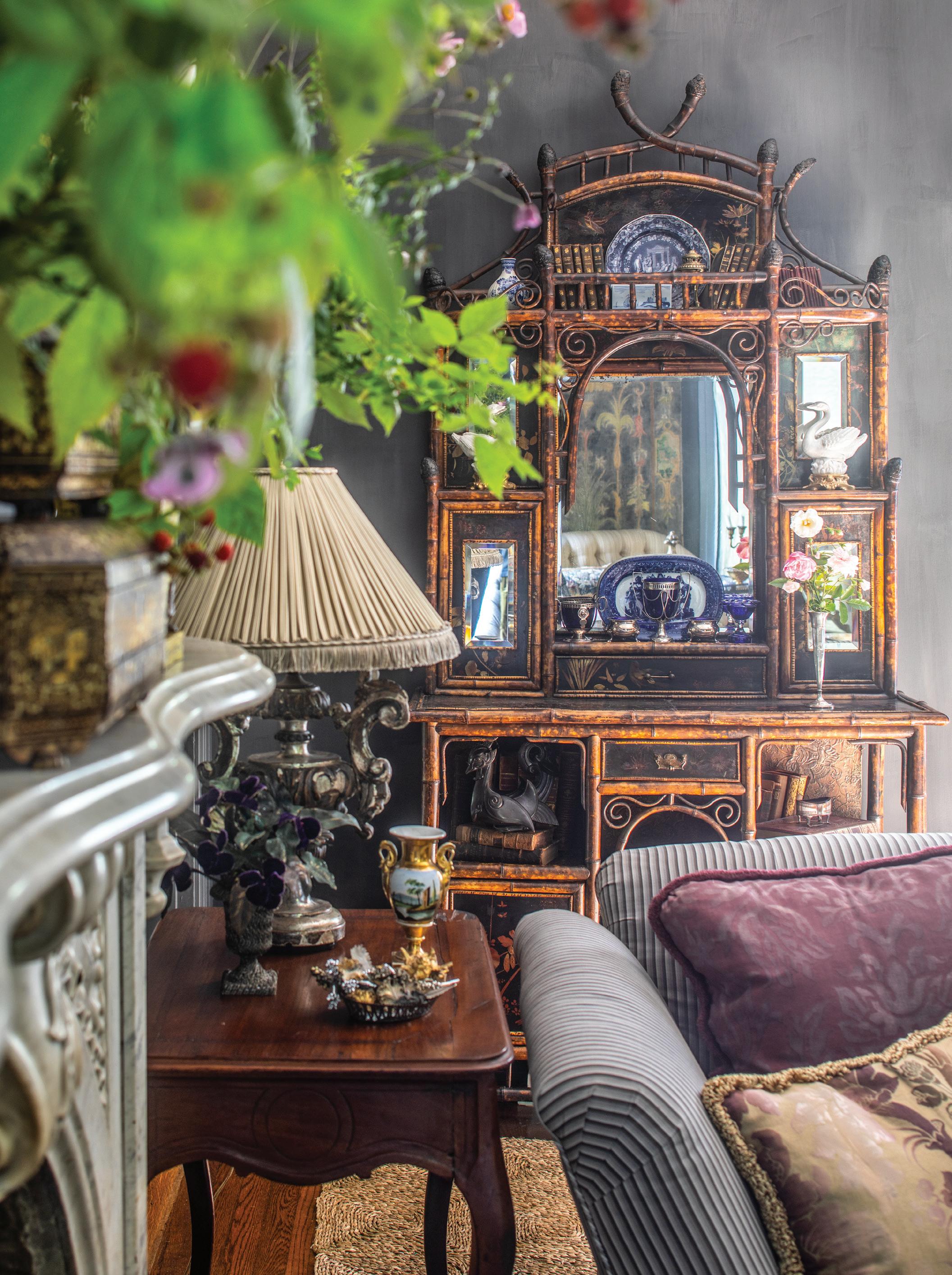
ABOVE: A Victorian étagère was the first piece of furniture Thomas ever purchased. It has since traveled with him from house to house, and now has a prime spot in their Virginia living room. The smoky-gray wall color is “Caviar,” a lime paint from Ressource. OPPOSITE: Brackets hung on a paned-and-mirrored wall display bits and bobs from the couple’s vast collection of blue-and-white porcelain.



ABOVE: Despite the homeowners’ desire to avoid major renovations, the sunroom did receive some structural alterations. Thomas and Michael removed three walls of bookcases and reopened a blocked doorway, installing French doors that lead to the garden. “It adds so much light to this room and the adjacent library,” says Thomas. OPPOSITE: The library, swathed in a pale blue-green, houses their extensive collection of books, from French novels to vintage and contemporary decorating and gardening titles. Sofa throw pillows needlepointed by Michael mingle with a couple of antique ones.
house,
flowermag.com/burak-devine.
“In the evening, the dining room is illuminated with candles in the chandelier and sconces and from the glow of the fireplace. No electricity allowed—we love hosting candlelit dinners.”
—THOMAS BURAK
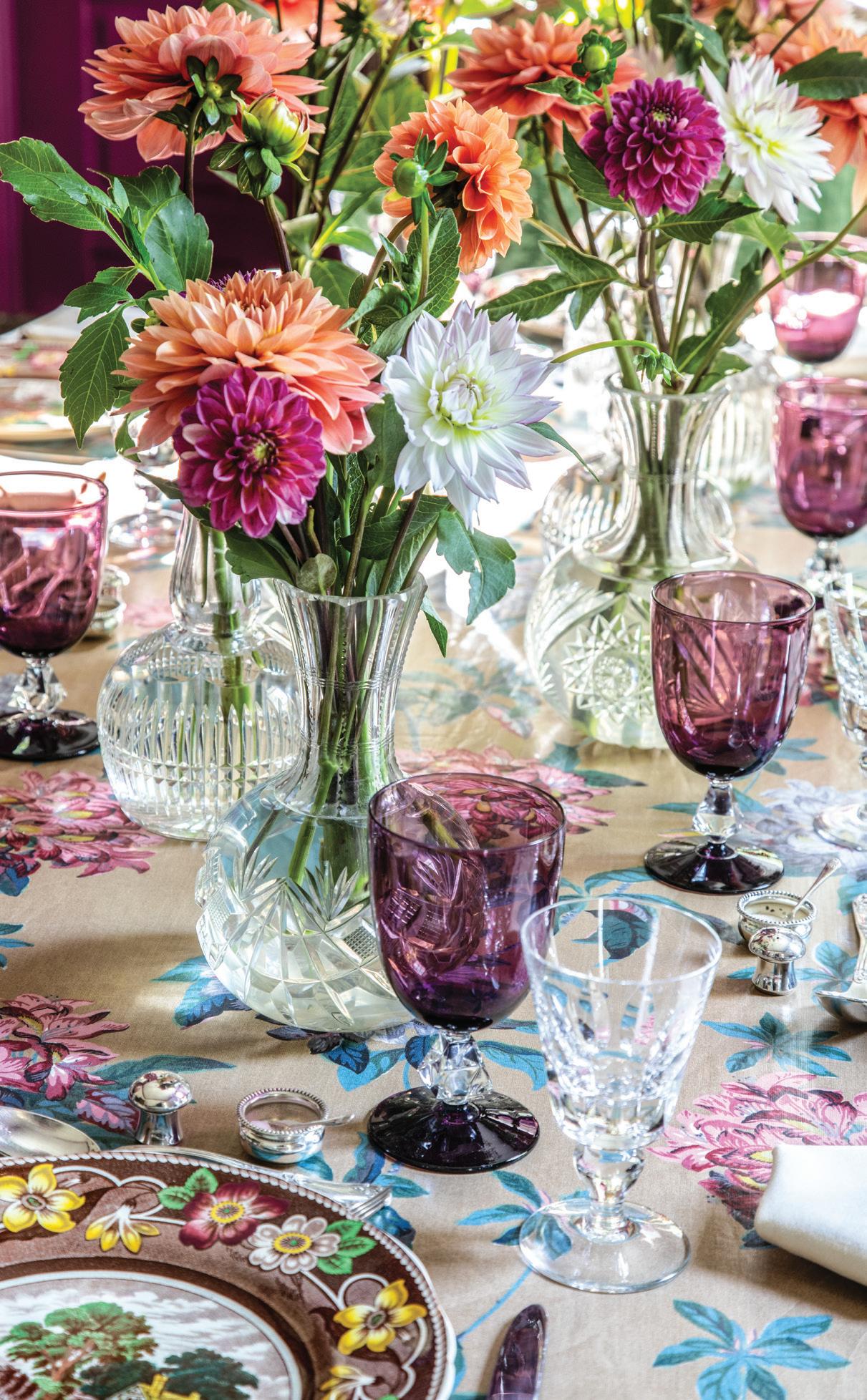

ABOVE, LEFT TO RIGHT: Dahlias echo the hues of English transferware and amethyst goblets. “I enjoy clipping flowers from the garden for arrangements,” says Thomas. “Michael always tells me to either cut and use them or get out there and deadhead.” • A detail of Michael’s hand-painted mural OPPOSITE: Enveloped in deep magenta and with no electric lighting, the dining room becomes even more magical when the sun sets and the candles are lit. FOLLOWING PAGES: Michael’s devotion to hands-on gardening rivals his acumen with interiors. His idea to line blue-and-white-porcelain jars alongside a brick pathway was inspired by the delftware vases in the Paleis Het Loo garden in the Netherlands.


“Sometimes Thomas and I joke th rather than a house

at we have a garden with a house, with a garden.”
—MICHAEL DEVINE


A Saffron Soirée
Entertaining guru
Jane Scott Hodges of Leontine Linens combines elements of India with Big Easy style for a
festive, alfresco dinner.
BY LYDIA SOMERVILLE
I PHOTOGRAPHY BY PAUL COSTELLO FLORAL DESIGNS BY PAMELA DENNIS

JJANE SCOTT HODGES MAY REIGN SUPREME OVER embroidered linens with her Leontine Linens line, but when she entertains, she’s just like any other hostess checking off her task list as she attends to every detail. Such was the scene on the day of a dinner party she held at her New Orleans home. The guests, including several of her dear friends, were all members of the Crown Society, the Mint Museum’s travel club based in Charlotte, North Carolina. With the help of many talented locals, Jane Scott set the stage for a memorable evening of alfresco dining on her terrace.
“This group is so special. We really wanted to put on the dog for them,” says Jane Scott. “We hired a jazz trio to play, and
we opened the windows to the terrace to create one big space with the dining room. We covered three tables in Indian block-print tablecloths borrowed from a pal. Since they were smaller than the tables, my husband had to run out and get Saints gold cloths to fill in underneath.” For the place settings, she called on resources from neighbors. Three different but complementary china patterns appeared on each table. “We all share china on our street,” Jane Scott says. “We scratch each other’s backs for these occasions.”
Centerpieces of marigolds and purple scabiosa, created by floral designer Pamela Dennis, pulled oranges and pinks from the block-print fabric. “I’m not great at flowers, so I asked Pamela to do them,” says Jane Scott. Place settings, however, are her forte. “It’s always fun for me to decorate the tables,” she says. “The china included a mix of patterns in orange, rust, and rosy tones. I like using natural woven chargers under the plates to distinguish them visually. The layers of color make the tables feel warmer. It’s not about perfection.”
For the meal, Jane Scott enlisted the talents behind Saffron, a New Orleans restaurant specializing in Indian cuisine. “I love their food and knew it would be a hit for this group,” she says. The menu melded the flavors of New Orleans and India with curried gumbo, roasted oysters, tandoori squash, and chicken biryani. Hand-painted menu cards with a marigold motif lent a touch of art to the tables. A macaron cake crowned the feast with its extravagant flourish.
While Jane Scott has plenty of entertaining experience under her belt, she admits that throwing a dinner party still has its stressors. “It’s hard work, but people are so appreciative of your efforts,” she says. “It allows you to create an experience for your friends and then enjoy it with them. I think it’s the nicest gift you can offer.”
PREVIOUS PAGES: Jane Scott Hodges took a moment to catch her breath before her guests arrived. “I found a dress that matched my scheme,” she says of her ivory-and-aubergine frock. THESE PAGES, ABOVE: Jane Scott and husband Philip welcomed guests as they arrived for the festive affair. OPPOSITE, CLOCKWISE FROM TOP LEFT: Customized place cards let guests know their presence was much appreciated. • A glass by New Orleans glassblower Ridge Walker mingles with French porcelain and a woven place mat. • A hand-painted menu card mapped out the evening’s menu by the chefs at Saffron restaurant.• Jane Scott’s embroidered table linens are the jewel in the crown of every table she sets.

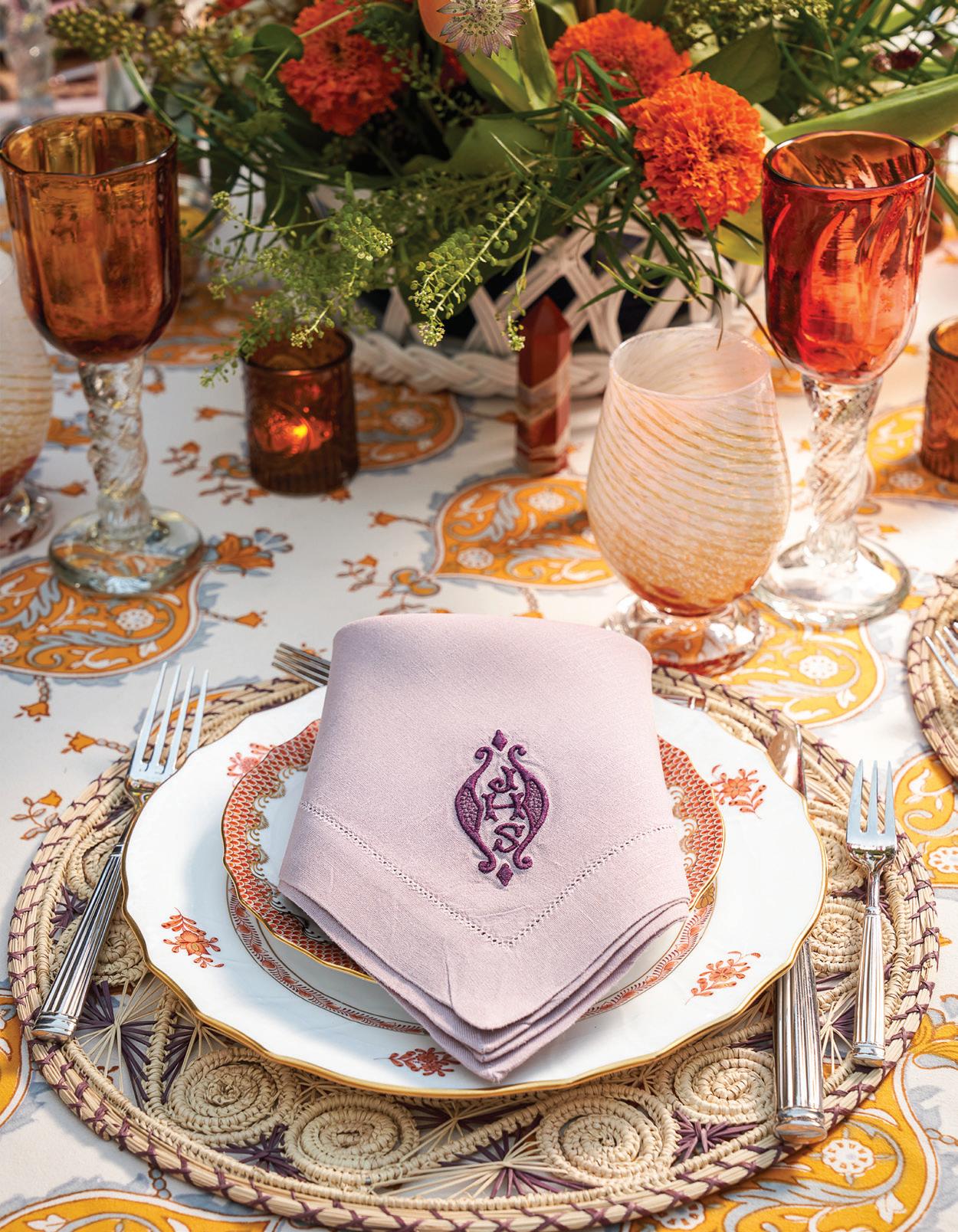






ABOVE, CLOCKWISE FROM TOP LEFT: Mojitos were served in julep cups—a classic mash-up of Cuban and Southern influences. • Opening expansive windows allowed the party to flow seamlessly from the dining room to the terrace. • A macaron cake created by Heidi Eppling echoed the party’s palette. • A jazz trio added to the lively mood. OPPOSITE: A crowd of patrons of the Mint Museum in Charlotte, North Carolina, descended on The Big Easy for a weekend of museum visits and revelry. Jane Scott welcomed the group to her home for a seated dinner.

“Throwing a dinner party allows you to create an experience for your friends and then enjoy it with them.”
—JANE SCOTT HODGES
Old-world Soul
A Houston remodel brings Mediterranean character and ageless artifacts together in a contemporary, livable home with heart.

BY JENNIFER CHAPPELL SMITH
PHOTOGRAPHY BY JULIE SOEFER
STYLING AND FLORAL DESIGN BY JESSICA HOLTAM

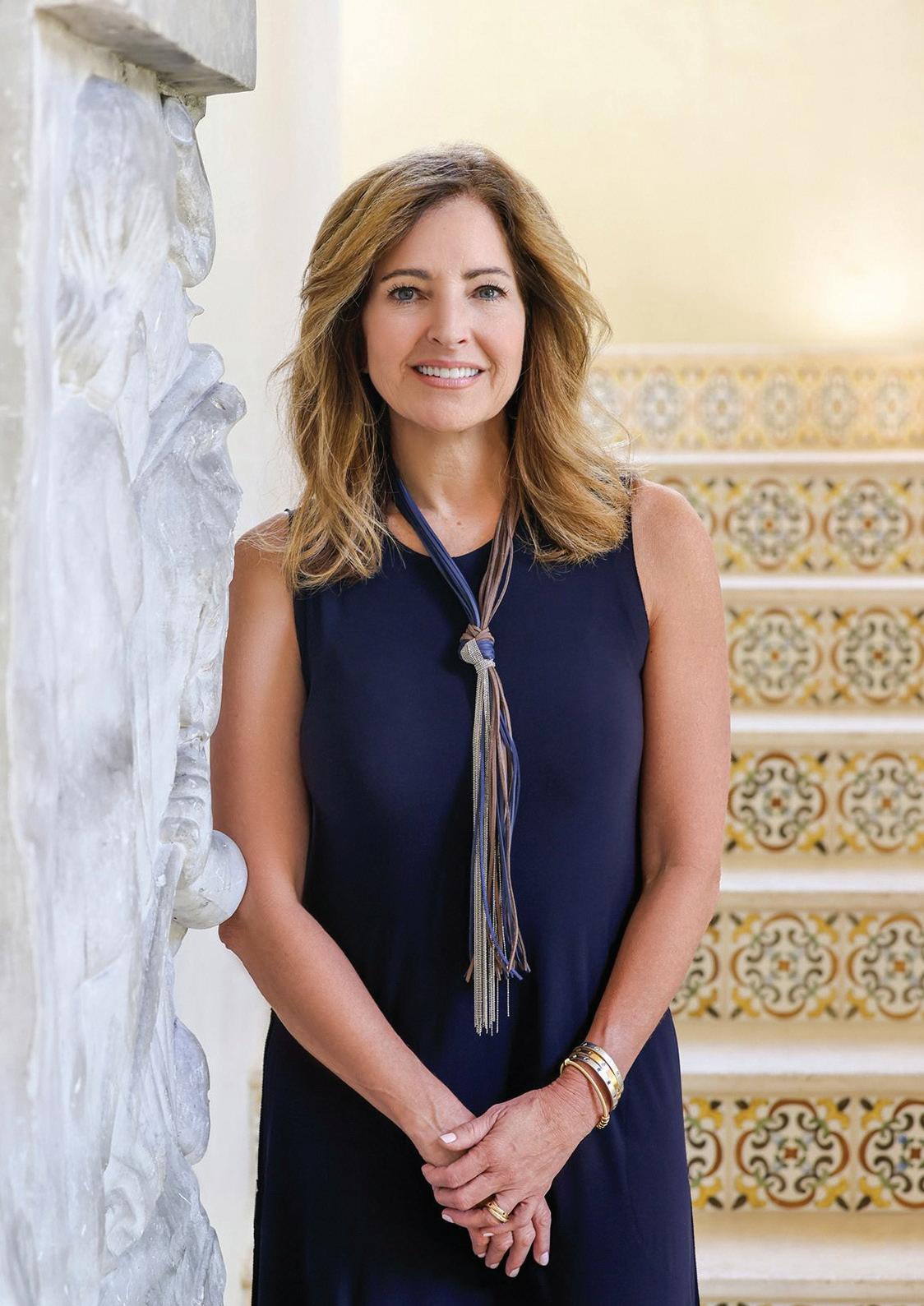

SSET BACK FROM THE ROAD before the sheen of an emerald lawn stands a contemporary Italianate villa where every detail has meaning. The thin, tower-like chimney rises like a spire, and Boston ivy climbs the façade. While this updated masterpiece of a family home sits firmly rooted in Houston’s River Oaks District soil, its Mediterranean style echoes half a world away.
“As grand as it is, it’s surprisingly unassuming,” says designer Kara Childress of Kara Childress—Interior Atelier in Houston. Owners Cindy and Stephan Kinsella tapped Kara to work a kind of alchemy on the interiors, creating comfortable, contemporary rooms built around antique and age-old elements, as well as natural materials like stone and marble. “I love working with reclaimed materials,” Kara says.
Gina Elkins, with locally based Newberry Architecture at the time, drew the plans for the renovated spaces. To fill the revamped rooms, Kara worked closely with both Gina and the Kinsellas. “The home was well-crafted but lacked the character and attention to detail they craved,” the designer says.
The clients appreciate color, texture, and layers—not just layers of materials but also eras and personal history. “Cindy loves antiques and appreciates their provenance,” Kara says. “She’s willing to wait for the right piece. It takes time to curate the things that give a home soul.” Among the finds are antique
light fixtures, European pieces, and unique artifacts. One of the most interesting items is an 18th-century, deconsecrated, stone baptismal font that serves as a sink pedestal in a powder room—a brush with history while rinsing hands.
Such pieces enhance the couple’s life in rooms built for daily routines. In the breakfast room, Cindy starts her workdays over coffee at a Belgian bluestone-topped table near an 18th-century fireplace. She enjoys backyard views as morning light filters past shades framed by luxury floor-to-ceiling draperies. Kara worked with the architect to add the rows of windows and doors made of steel and glass that connect the interiors to the outdoors. “Cindy gets especially excited about what is seasonally blooming outside,” says Kara.
In the nearby kitchen, a late 18th-century zinc bull’s head presides over the space—a nod to Wall Street and Cindy’s work in the oil and gas industry. New concrete countertops have what Kara calls a “quiet presence” with a soft patina. An antique fireback from a 17th-century French château leans behind the range, adding a sense of history to everyday meal prep.
The dining room features a hand-painted Indian tea paper that covers the walls, setting the backdrop for a custom dining table and mohair-upholstered chairs. Sumptuous drapery creates a bit of drama in a subtle way, according to Kara. Arched

PREVIOUS PAGES, LEFT TO RIGHT: An antique Flemish tapestry backs an antique French canapé made of walnut. The acrylic side table “gives the space a transitional feel,” says designer Kara Childress. • The great room exudes plenty of character due to reclaimed elements such as an antique carriage lantern and mantel, as well as a side chair upholstered in an antique, Flemish tapestry remnant. THESE PAGES, OPPOSITE LEFT TO RIGHT: Designer Kara Childress helped the homeowners create a Mediterranean-inspired villa with modern liveability. • On the left side of the front façade, Kara and team renewed flooring on a terrace and added a second-floor pergola. THIS PAGE: On the reinvented patio space, delicate garden chairs with cushions in outdoor fabric surround a hefty Belgian bluestone table. An olive tree anchored by English ivy fronts a wall of espaliered star jasmine.


“It takes time to curate the things that give a home soul.”
—DESIGNER KARA CHILDRESS
windows offer sweeping views of the front and side yards. Just outside, a terrace with new pergola and a refurbished patio offer alfresco dining options and more spaces to entertain.
A guest room, dubbed the “LSU room,” offers a nod to the couple’s alma mater with its color palette. The space features pillows made of antique textiles by B. Viz Design. “These pillows are truly pieces of history,” Kara says. Modern details such as a purple mohair headboard and chartreuse grass cloth on the walls add a sense of freshness. Thanks to Kara’s keen eye for both details and storied pieces, the Mediterranean-inspired home now embodies the character the Kinsellas desired—a perfect balance between the enchantment of yesterday and the comforts of today.
A dining room chandelier hangs from the coffered ceiling with new plaster insets that contribute to the grand feel of a room. A gilt mirror serves as a focal point. Hand-painted De Gournay wallpaper envelops the space.
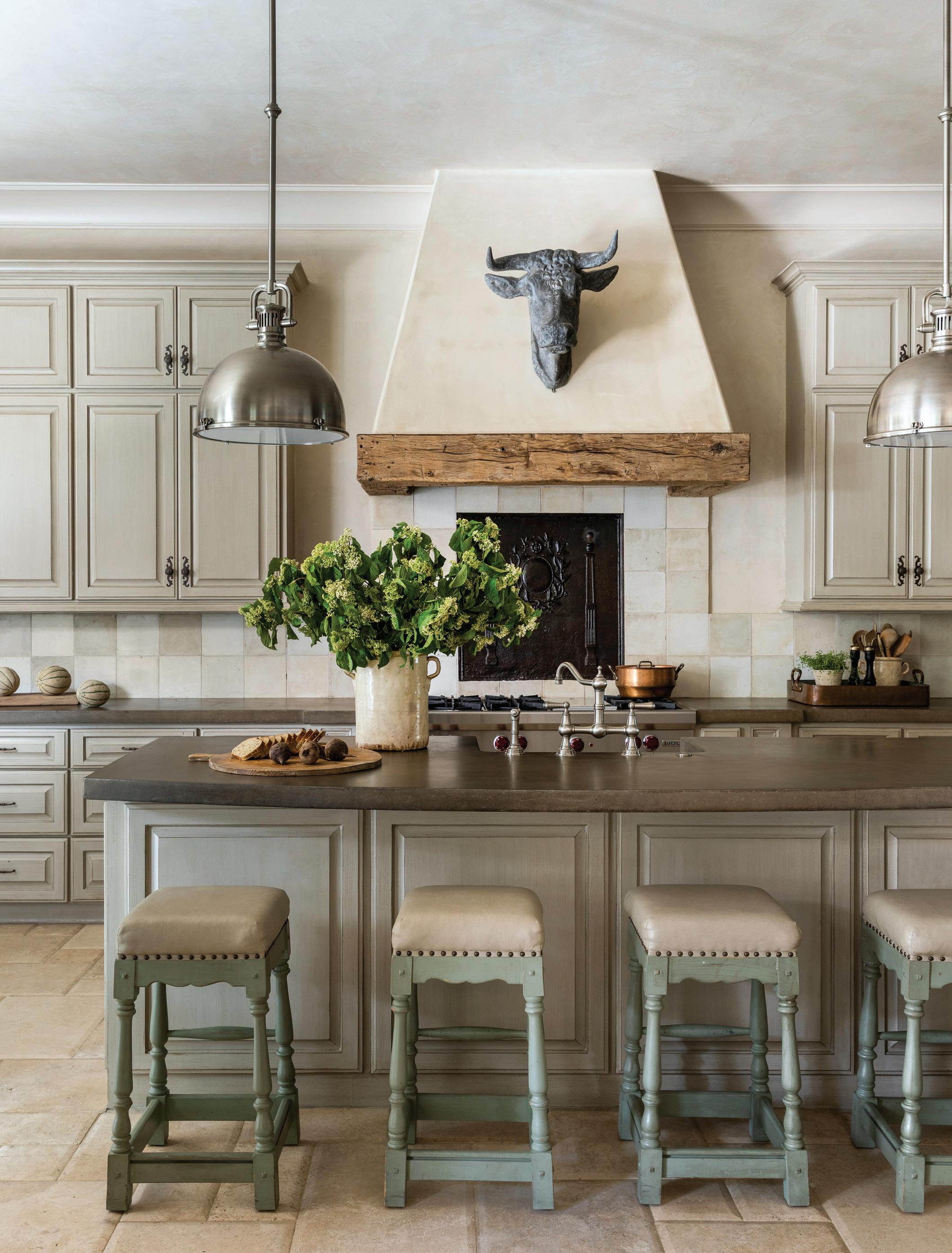
THESE PAGES, ABOVE: Original, pillowed limestone tile flooring serves as a neutral base for the kitchen redo. Contemporary, concrete countertops pair with a 19th-century cement tile backsplash, juxtaposing old and new. Fresh viburnum stems add a color punch.
OPPOSITE: In the breakfast nook, textures from a Belgian bluestone tabletop, weathered oak chairs, and a flecked finish on a 19th-century, Swedish Gusatavian cabinet mix with cut magnolia branches to create a still life-worthy tableau. FOLLOWING PAGES: A purple-and-gold guest room with grass cloth-covered walls honors the owners’ school colors from days at Louisiana State University.


“Every project is about what speaks to the client.”
—DESIGNER KARA CHILDRESS

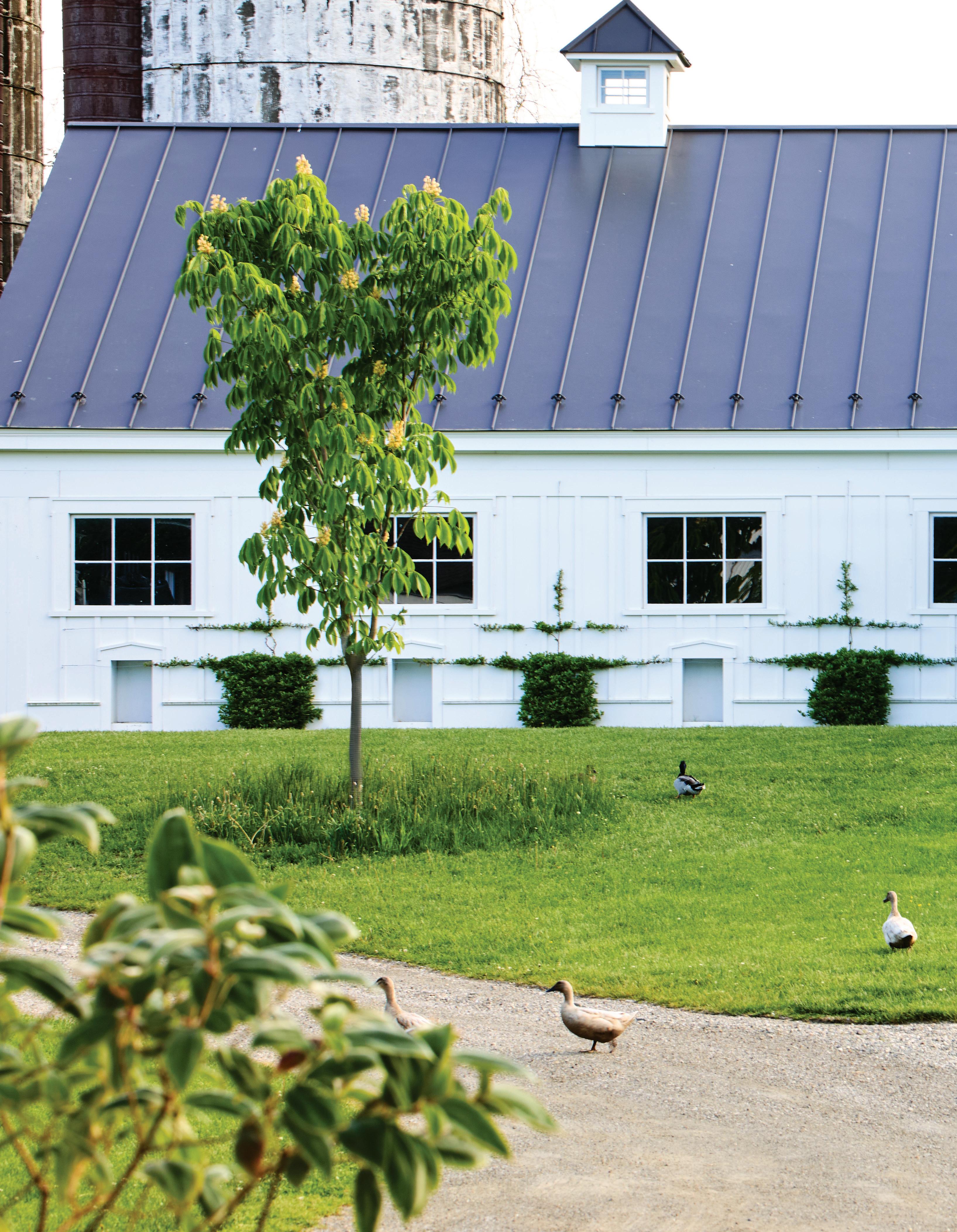
Tending Nature
Anthony Bellomo thrives on cultivating community, whether home at Clove Brook Farm or in his shop, Orangerie Garden + Home, in Millbrook, New York.

BY TOVAH MARTIN
PHOTOGRAPHY BY ANNIE SCHLECHTER
STYLING BY FRANCES BAILEY
LYON THE
BLACK LAB CAN’T WAIT FOR DAWN So Anthony Bellomo rolls out of bed, pulls on a pair of seriously well-worn work boots (“loafers wouldn’t last an hour here at the farm”), and follows the overly enthusiastic pup down to the 1790s kitchen of the farmhouse where breakfast is served to this most impatient tail-thumping family member. Soon Fanny, the less
demonstrative Cavalier King Charles Spaniel, wants her morning feast—and the kittens also get into the act. Then Anthony tends to the chickens and turns the Babydoll sheep out to pasture before diving into planting, repotting, watering, or whatever other gardening task he has planned for the early hours of morning. When he finds his way back into the kitchen, he brews coffee for himself while also boiling a pot of tea for his husband, Christopher Spitzmiller. Farm chores are a daily occurrence at Clove Brook Farm, and Anthony wouldn’t have it any other way. “When you love the world you’ve created around you, it’s okay that every day is the same,” he says.
It didn’t take long for Anthony and Chris to discover they had a lot in common. For starters, they both believe in magic—not the abracadabra kind but the version that occurs when you walk through an ornate gate to see a parade of poppies or peonies in full blossom that takes your breath away. That kind of magic fits perfectly into the lives of these two creatives—Anthony is a landscape architect; Chris is a ceramicist who has created a widely acclaimed line of lamps, cachepots, dishes, and vases. Clove Brook is the 5½-acre farm and formerly forlorn Greek Revival house in Dutchess County, New York, that Chris spent five years renovating. It’s surrounded by a classical garden filled with idiosyncrasies galore. Both Anthony and Chris are dedicated to making uncommonly wonderful things happen, especially in this refuge from Manhattan’s hubbub. And sharing that aesthetic with their neighbors is also key.

opportunity to really get to know the neighborhood and its residents, the pandemic happened. Originally coming from a small town in the Finger Lake region of New York, he especially missed that sense of community. When he caught wind of a greenhouse/ nursery/shop in nearby Millbrook, New York, in need of a new tenant, he saw an opportunity to connect with others—and Orangerie Garden + Home was born. Anthony’s vision was to cater to his customers’ creative spirits with his collections of specialty plants.
As Anthony began joining Chris for weekends at the farm, they could unwind and indulge their collective love of gardening with all its accoutrements. But before Anthony had the
By midday, after a morning spent working in the garden at home, Anthony heads to the shop with a worn leather duffel by his side and a vase of freshly cut flowers from Clove Brook—tulips, peonies, or dahlias, depending on the season—in the back seat of his Jeep. As he sweeps through the shop’s doors, he takes a few minutes to tidy up—perhaps straightening a line of bud vases or tucking an auricula primrose into an exquisitely glazed cachepot. Soon he gravitates toward the greenhouse, where he’s really in his element. Unusual succulents, dramatic topiaries trained into choreographic-like feats, a variety of ferns, you name it—that’s what Anthony specializes in hunting down for his shop. But it’s not only about the extraordinary. “Orangerie is really born out of the way we put beautiful things together at Clove Brook Farm,” Anthony says as he crowns a display with a particularly impressive topiary. “Our goal is to inspire everyone to live with nature, even in small ways.” That artfulness is Orangerie’s raison d’être. For example, if black petunias speed your heartbeat, the shop has you covered—and you’re also sure to find a container that will elevate that plant to legendary levels.
One visit to Orangerie, and you’ll realize that the magic goes
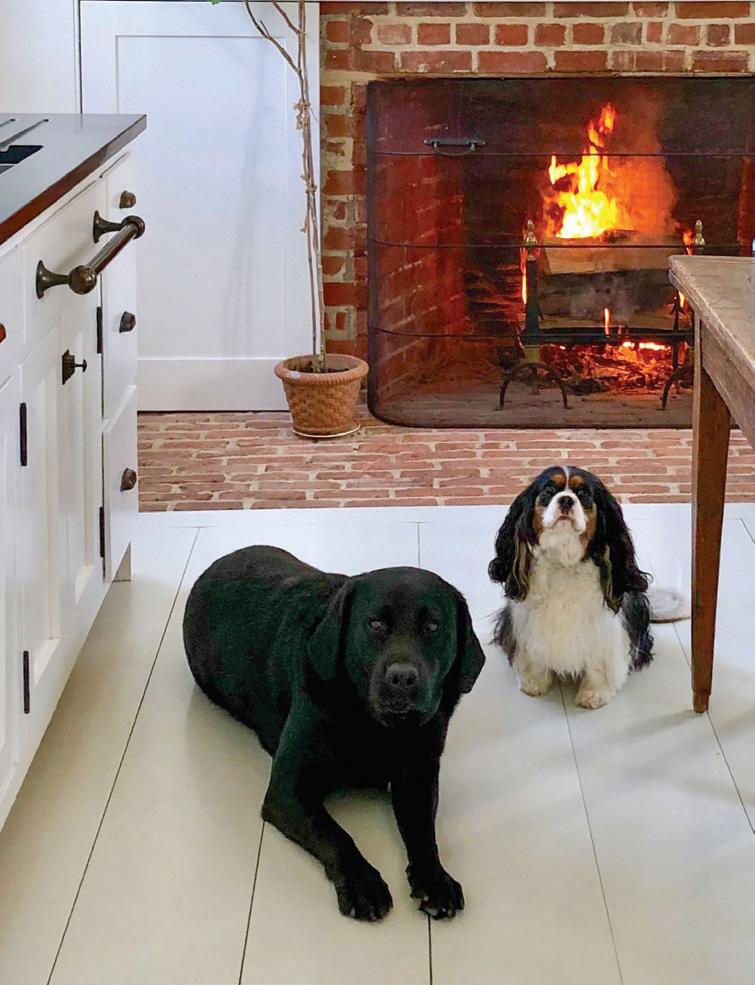

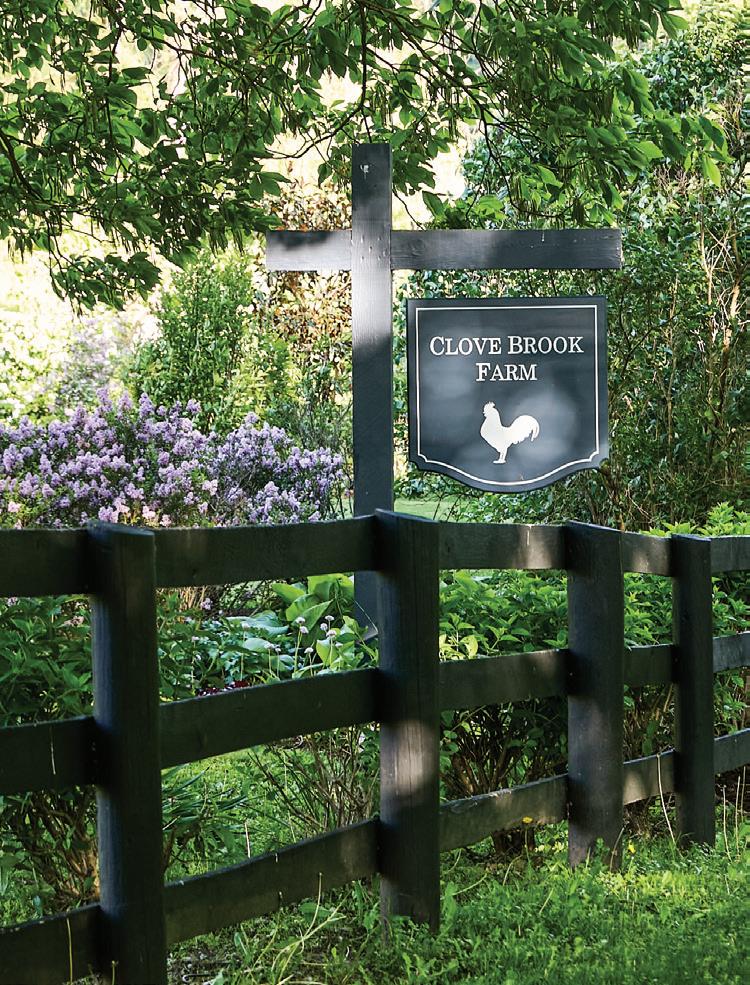

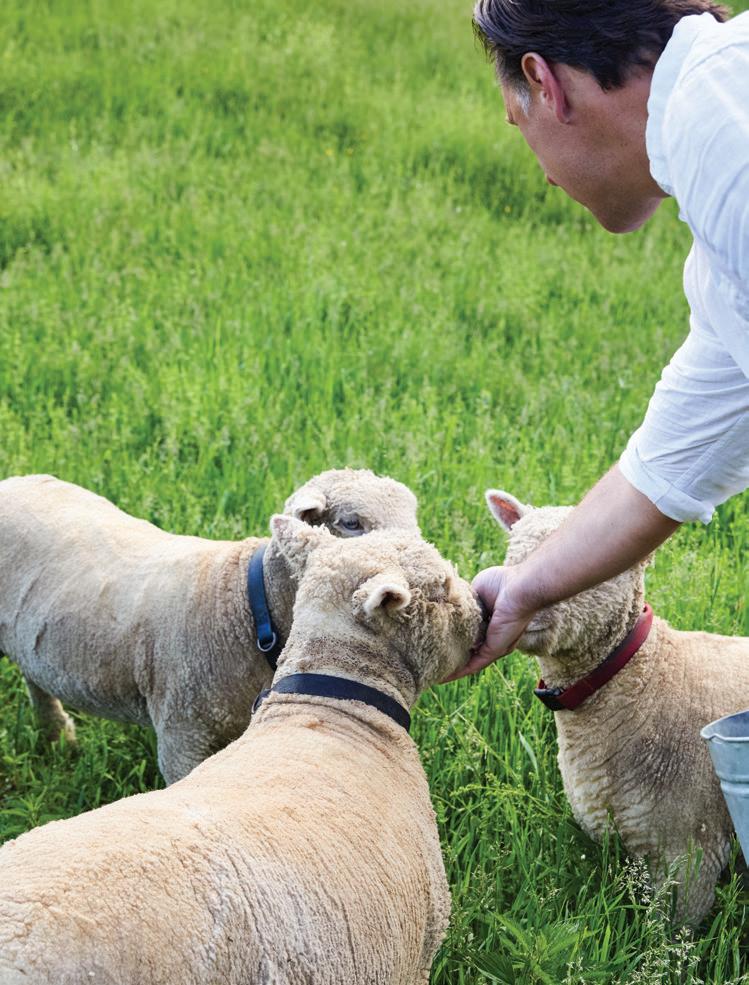
PREVIOUS PAGES: Mallard and Khaki Campbell ducks at Clove Brook Farm await their grain from Anthony. THESE PAGES, OPPOSITE: Anthony and Christopher cut blooms from their gardens to make arrangements for Orangerie. CLOCKWISE FROM TOP LEFT: Lyon and Fanny await breakfast in Clove Brook’s kitchen. • When Christopher bought the house, he swung into restoration mode, returning to 19th-century windows and adding a portico. • One of the first duties of the day is giving the Southdown Babydoll sheep breakfast. • Anthony and Christopher grow long-stemmed ‘Mount Everest’ alliums to use in statement-making arrangements. • The main allée runs through the dovecote garden. • Along the road, there’s only a hint of Clove Brook Farm’s full glory. • On the side porch, a plantstand displays a collection of auricula primroses.

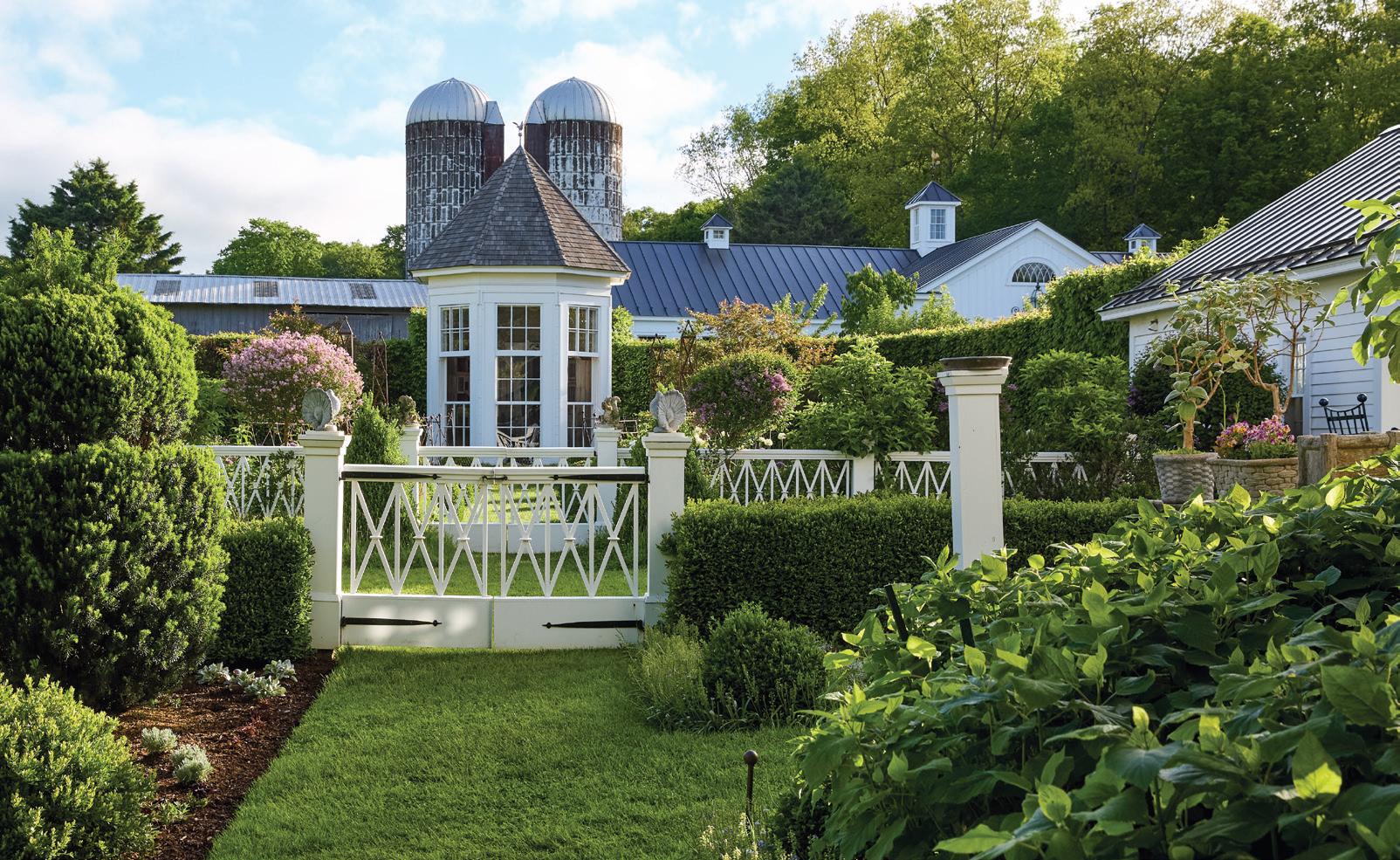
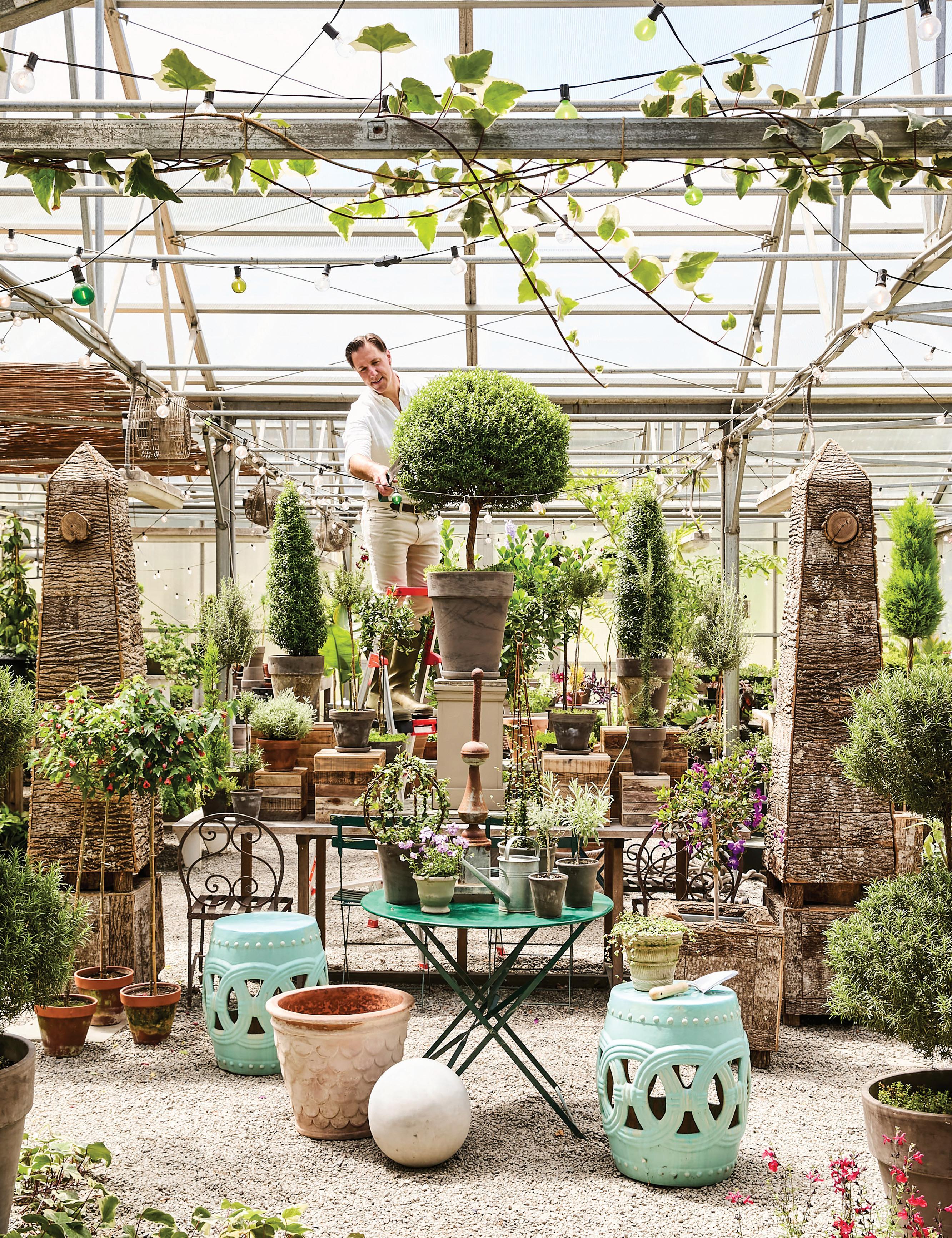
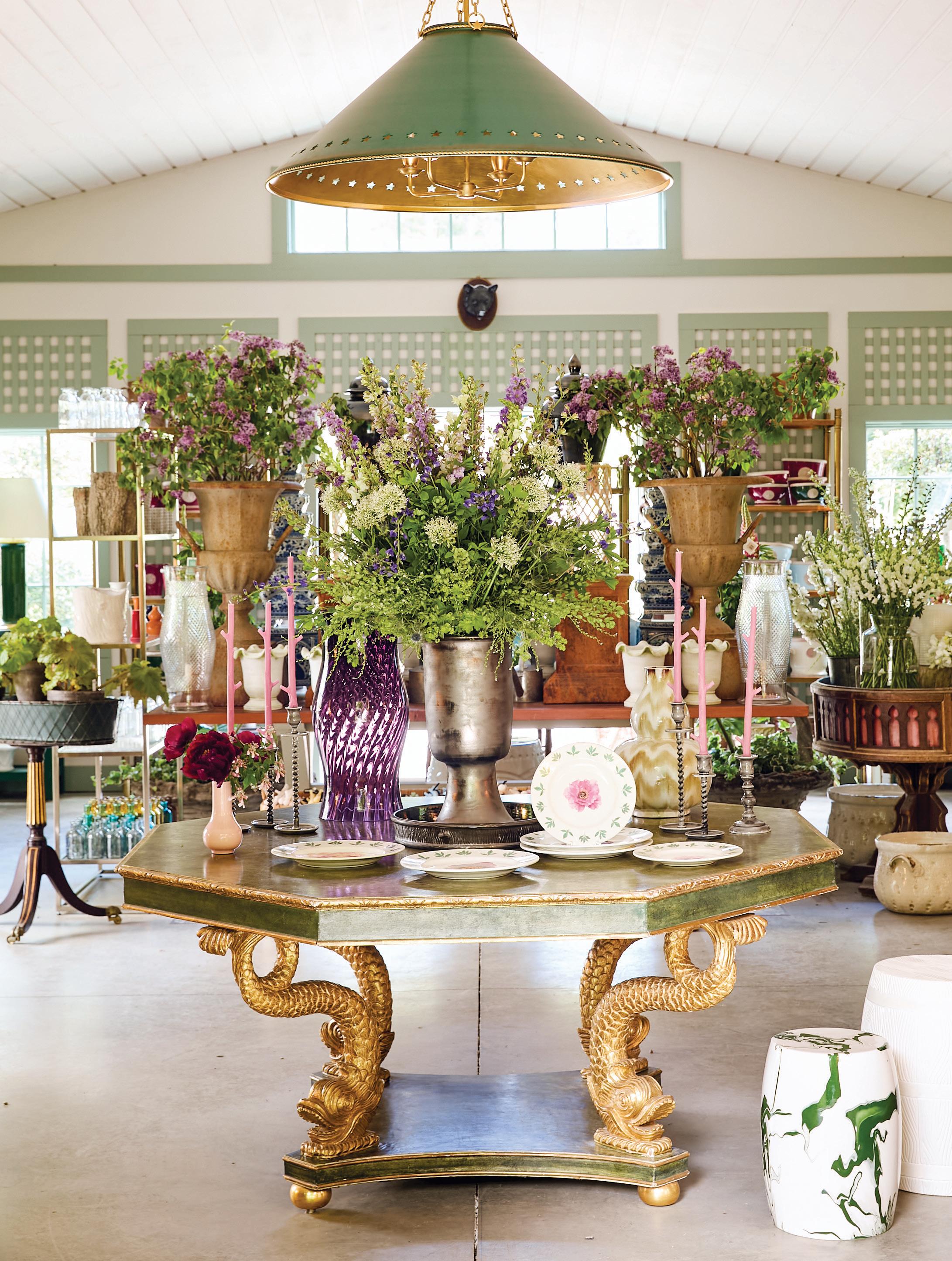

beyond the inventory. Before he opened the shop, Anthony immersed himself in decorative details to transform the space, like the trellising on the interior walls. The claw-foot tables, cupboards, and other furniture that display the goods are all critical to creating the vision and ambiance. Like a garden, the shop has focal points, statuary, and architecture, but it’s also a jewel box of plants and ideas.
Not surprisingly, people come from near and far to explore
Orangerie. Neighbors stop by to share a new recipe or talk trends while others make the pilgrimage to get help with tasks such as repotting their senecio into an incredible urn. It’s a welcoming environment—one that also spreads beyond the shop’s walls. After a long day, Anthony frequently pops into the village to pick up dinner ingredients or a gardening tool, and everyone in town gives him the glad hand. It’s that small-town warmth that makes him feel right at home.
PREVIOUS PAGES, LEFT TO RIGHT: Anthony is obsessive about keeping the trophy myrtle topiary meticulously trimmed. The bark-covered obelisks are by North Carolina artist Raleigh Adams. • Only a massive arrangement in a Christopher Spitzmiller matte bronze urn could offset Orangerie’s formidable central dolphin-legged Empire table. THESE PAGES, ABOVE: At the shop, Delft tulipieres cradle ‘Coral Charm’ and ‘Garden Lace’ from Christopher’s collection of named peonies. • OPPOSITE: When Anthony needs some quiet time buffeted by greenery, he slips into the pocket garden accented by European hornbeams behind the shop.
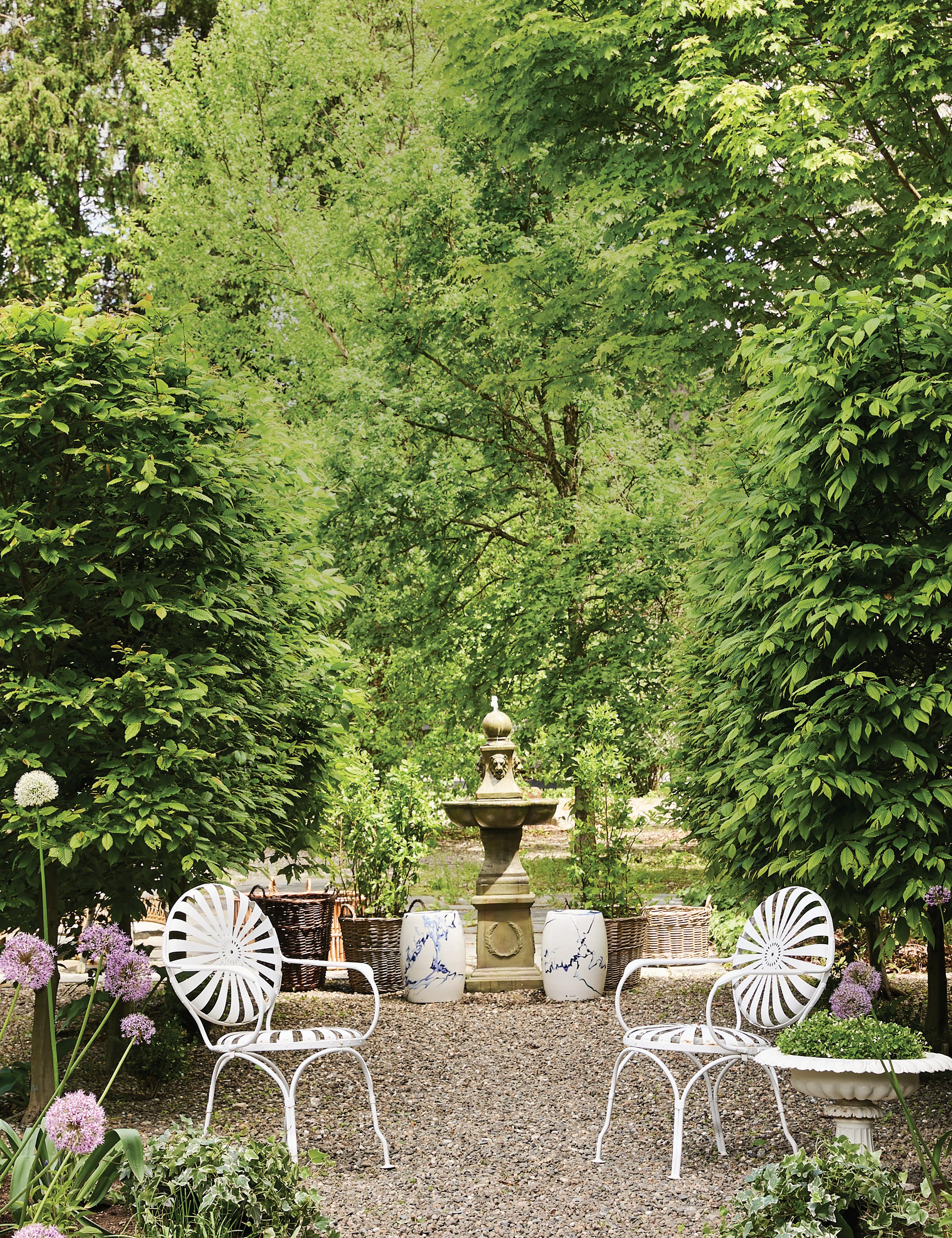
“Orangerie is really born out of the way we put beautiful things together at Clove Brook Farm. Our goal is to inspire everyone to live with nature, even in small ways. ”
—ANTHONY BELLOMO

Millbrook Musts
Anthony shares a few of his favorite stops around Millbrook.
CREEL AND GOW
Orangerie gained the perfect next-door neighbor when this shop filled with findings from afar moved in. From framed botanicals to polished stones with tribal jewelry, the eclectic inventory is sourced around the world. Bon voyage is footsteps away.
BABETTE’S KITCHEN
Anthony and Chris make a beeline for the BLT with avocado, a coconut veggie curry hand pie, or leek and parmesan bistro pastry, depending on the daily menu and their moods—and they top it off with a generous serving of strawberry rhubarb crumb cake.
REARDON BRIGGS HARDWARE
Behind every great garden is a comprehensive hardware store. Not only does this homeware and farm store have the goods, the friendly staff enjoys discussing gardening triumphs and challenges with customers.
MILLBROOK DINER
Whether it’s Eggs Benedict for breakfast or a hot Reuben for lunch, sometimes you just want to bite into comfort food. This quintessential diner serves it up with a heaping helping of nostalgia on the side.
BOTTLE SHOP ANTIQUES
A treasure trove of vintage everything in a labyrinth of jam-packed rooms that overflow into the outdoors. It’s about so much more than bottles—the only challenge is in the search.
HUNT & HARVEST
This local caterer has an in-town presence right off the main street, carrying freshly prepared gourmet meals, baked goods, boutique olive oils, condiments, seasonings, and cookbooks. Anthony can always find any last-minute essentials for impromptu entertaining.
MILLBROOK BEEF & DAIRY
Anthony and Chris pop by this neighborhood farmstand stocked with meat, dairy, locally-sourced vegetables, and strawberries grown in the adjacent field.






MILLBROOK BEEF & DAIRY BABETTE’S KITCHEN
BOTTLE SHOP ANTIQUES
CREEL AND GOW
MILLBROOK DINER
REARDON BRIGGS HARDWARE
HUNT & HARVEST

Spark your love for design and be at the center of it all.
Immerse yourself in three days of curated panels, exclusive product debuts, and insightful conversations—showcasing the very best in design innovation. 9.23–9.25
Interconnect Candle Holder | Habachy Designs + Atelier Hudley Coffee Table by Elan Atelier | Paul +


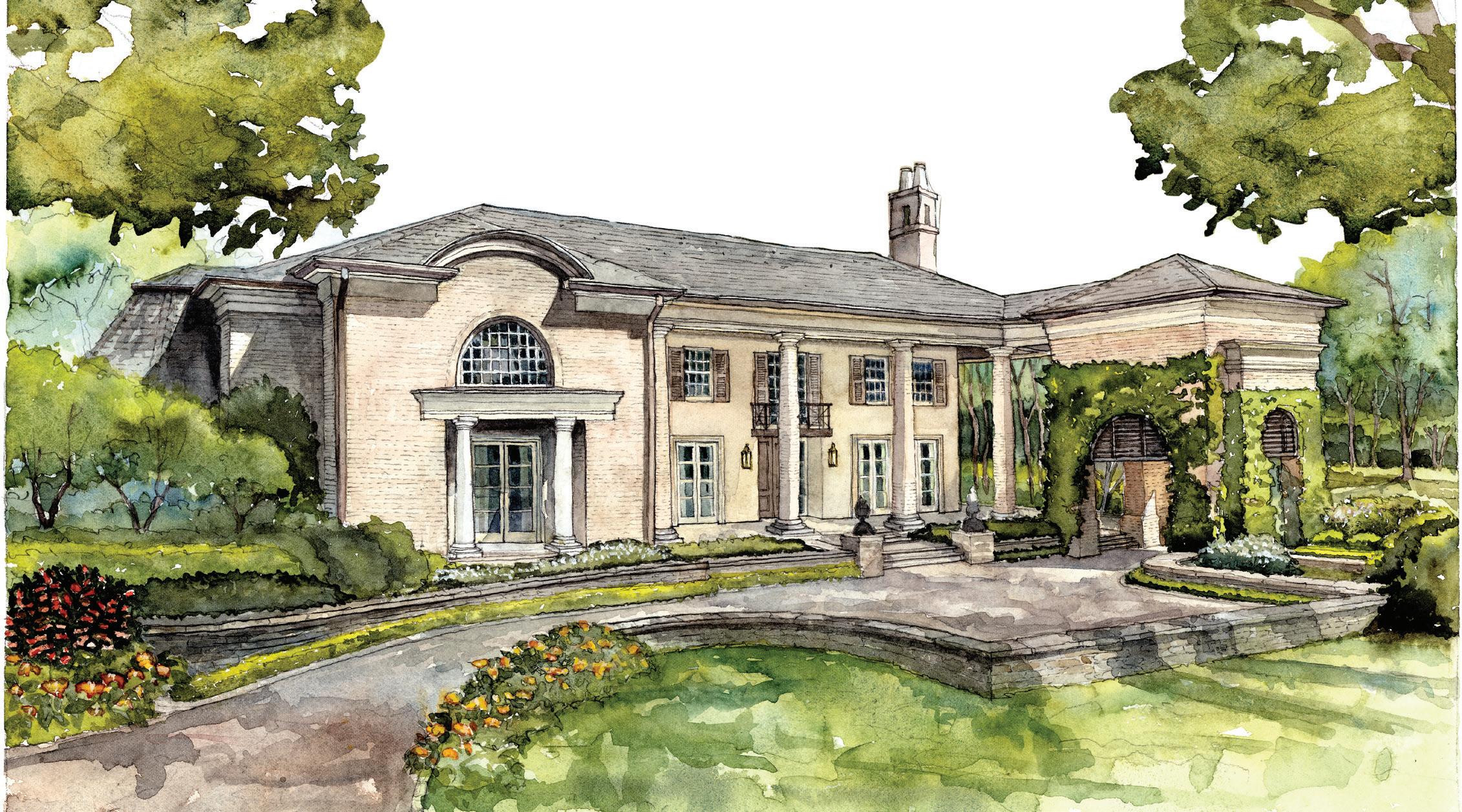





OCTOBER 2 - 5, 2025


presenting sponsors 1919 INVESTMENT COUNSEL & FIDELITY INVESTMENTS
design sponsor SCHUMACHER benefiting FRIENDS OF BIRMINGHAM BOTANICAL GARDENS
BBGARDENS.ORG/ANTIQUES @antiquesgardensbham
11:00 am - 5:00 pm


EXPERT TREE CARE FOR 118 YEARS — AND GROWING.
Acer saccharum, better known as Sugar Maple, is just one of the thousands of species we specialize in. For 118 years, our family-owned company has brought a rare mix of groundbreaking science, award-winning safety practices, and global resources to every tree and shrub care task at hand. And at the heart of our success are our people — experts who know and champion every tree, no matter the species. Discover how our passion is inspiring one beautiful property after another.







Representing Today’s Foremost Portrait Artists
Portraits, Inc. offers a number of benefits and services at no cost to you. We manage all aspects of our portrait commissions, from helping you discover the artist who best matches your vision and budget to guaranteeing your total satisfaction with the completed portrait.
Call now to request a presentation of artists that reflects your personal style.







Any items not listed are unknown.
FROM THE FIELD
PAGES 24-36: Books: My Life in Colors by Martin Brudnizki, Rizzoli, rizzoliusa. com; Comforts of Home by Andrew Howard, Abrams, abramsbooks.com; Design Reimagined by Corey Damen Jenkins, Rizzoli, rizzoliusa.com; Still Decorating by Tom Scheerer, Vendome, vendomepress.com; A Welcome Home by Alexandra Kaehler, Monacelli, phaidon.com/monacelli/; The Essentials by Caitlin Flemming & Julie Goebel, Abrams, abramsbooks.com; Elegance and Comfort of Home by Dana Wolter, Gibbs Smith, gibbs-smith.com; Home Again by James Farmer, Gibbs Smith, gibbs-smith.com; The Glamorous House by Jan Showers, Abrams, abramsbooks. com; Homing Instinct by Nicola Harding, Rizzoli, rizzoliusa.com; The Expressive Home by Ray Booth, Rizzoli, rizzoliusa. com; The Refined Home by Sheldon Harte, Vendome, vendomepress.com; Beautifully British Interiors by Sims Hilditch, Rizzoli, rizzoliusa.com
JOHN’S ALMANAC
PAGES 38-42: Blackberry Farm, blackberryfarm.com
PRESSED FOR TIME
PAGES 44-52: Page 44: Liz Morris Decorative Interiors, @lizmorrisdecorativeinteriors; Page 46: 1926 Rocky Mountains herbarium from Right | Proper, rightproperhome.com; Page 48: design by Jennifer Hunter, jenniferhunterdesign.com; Page 50: (top left) 1926 Rocky Mountains herbarium from Right | Proper, rightproperhome.com; (bottom left) design by Shannon Bowers, shannonbowersdesigns.com; (right) design by Brooke McGuyer, brookemcguyer. com; herbaria from Joyce Horn Antiques, joycehornantiques.com
CREATING A SPECTACLE
PAGES 54-58: Designer: Rebecca Gardner, Houses & Parties, housesandparties.com; Book: A Screaming Blast by Rebecca Gardner, Rizzoli, rizzoliusa.com
ONE ENCHANTED EVENING
PAGES 62-66: Floral designer: Sybil B. Sylvester, @wildflowersybil; Fabrics: Garden Walk Collection by Lee Jofa, kravet.com; Lighting: Pooky, pooky.com; Food: Chris Hastings, Hot & Hot Fish Club, hotandhotfishclub.com
DESIGN COME TRUE
PAGES 72-81: Interior designer: Danielle Balanis; daniellebalanis.com; Floral
SOURCES
Who Did It & Where To Get It
designer: Mark Thompson, Shoppe, @shoppebham; Living Room: Screen: Chairish, chairish.com; Coffee tables: Etsy, etsy.com; Bench: Roman Brantley with Lisa Fine fabric, @romanb_art_antique, lisafinetextiles.com; Sofa: Lee Industries with Schumacher velvet, leeindustries. com, schumacher.com; Floral pillow fabric: Ottoline, ottoline.co.uk; Suzani throw: B. Viz Design, bvizdesign.com; Black Lamp: Still Johnson, stilljohnson. com; Rattan lamp base: M.K. Quinlan with Paige Albright Orientals paisley shade, mkquinlan.com, paigealbrightorientals.com; Rug: Mark Sikes for Dash & Albert from Paige Albright Orientals, annieselke.com, paigealbrightorientals.com; Red leather side table: Hiltz Lauber, hiltzlauber.com; Overhead star light fixture: Visual Comfort, visualcomfort.com; Sofa side tables: Urban Suburban Antiques, urbansuburbanantiques.net; Sunroom: Ceiling wallpaper: Schumacher, schumacher.com; Skirt Fabric: Pierre Frey, pierrefrey.com; Étagères & Lucite stool: Chairish, chairish.com; Stool fabric: Schumacher, schumacher.com; Chairs: Roman Brantley, @romanb_art_antique; Paint color: Benjamin Moore ‘French Canvas’, benjaminmoore.com; Dining room: Blue tie-dye rug: Paige Albright Orientals, paigealbrightorientals.com; Neutral indoor/ outdoor rug: Hiltz-Lauber, hiltzlauber.com; Roman shade linen fabric: Pindler with Fabricut trim, pindler.com, fabricut.com; Chandelier shade fabric: King Cotton, kingcottonfabrics.com; Mirror: Chairish, chairish.com; Lampshades: Ballard Designs, ballarddesigns.com; Skirt fabric: Pierre Frey, pierrefrey.com; Tabletop cabbage and lettuce dinnerware: Clemontín, @ clemontinshoppe; Glassware: Waterford, waterford.com; Green obelisks: Clemontín, @clemontinshoppe Kitchen: Cabinet paint color: Sherwin-Williams ‘Moody Blue,’ sherwinwilliams.com; Barstools: One King’s Lane, onekingslane.com; Light fixture: Visual Comfort with custom shades in Jim Thompson fabric, visualcomfort. com, jimthompsonfabrics.com; Lamps and lampshades: Village Firefly, @village_firefly; Café curtain fabric: Décors Barbares, decorsbarbares.com; Bedroom: Wall color: Farrow & Ball ‘Incarnadine’, farrow-ball. com; Curtain fabric: Rose Cumming, Wells Abbott, wellsabbott.com; Throw on bed: Still Johnson, stilljohnson.com
FINDING HOME
PAGES 92-103: Interior design: Thomas Burak, thomasburak.com, and Michael Devine Ltd, michaeldevineltd.com;
Living room: Paint: ‘Caviar’ from Ressource, ressourcepaints.com; Library: Paint: ‘Amande’ from Ressource, ressourcepaints. com; Sunroom: Tablecloth fabric: ‘Combray’ by Michael Devine, michaeldevineltd.com; Chair fabric: ‘Waltham’ by Michael Devine Ltd., michaeldevineltd.com; Dining room: Curtain fabric: ‘Ashley’ by Michael Devine Ltd., michaeldevineltd.com; Paint color: ‘L’Extase’ from Ressource, ressourcepaints.com
A SAFFRON SOIRÉE
PAGES 104-109: Designer: Jane Scott Hodges, Leontine Linens, leontinelinens. com; Floral designer: Pamela Dennis, pameladennisnola.com; Food: Saffron, saffronnola.com; Glassblown pieces: Ridge Walker, ridgewalkerglass.com; Macaron cake: Heidi Eppling; @heidihousenola
OLD-WORLD SOUL
PAGES 110-119: Outoor Terrace: Belgian bluestone dining table: custom by Chateau Domingue; Dining chairs: Rose Tarlow Twig Iron Garden Chairs in High Performance Perennials fabric, rosetarlow.com, perennialsfabrics.com; Walls: Hand-painted de Gournay panels on India tea paper, degournay.com; Fabric on dining chairs: Rose Tarlow, rosetarlow.com; Sconces: Shabby Slips Home, shabbyslipshome.com; Kitchen: Fireback from Chateau Domingue, chateaudomingue.com; Breakfast room: 19th-century Swedish Gustavian Cabinet: from M. Naeve, mnaeve.com; Guest bedroom: Antique purple pillow on bed: B. Viz Design, bvizdesign.com; Walls: Grasscloth by Phillip Jeffries, phillipjeffries. com; Carpet: Zaina col Birch from Stark Carpet, starkcarpet.com
TENDING NATURE
PAGES 120-128: Landscape architect/ floral design: Anthony Bellomo, @anthony.bellomo; Ceramics: Christopher Spitzmiller, christopherspitzmiller. com; Shop: Orangerie Garden + Home, orangeriegarden.com; Farm: Clove Brook Farm, clovebrookfarm: Barkcovered obelisks: by Raleigh Adams, raleighadams.com
VOLUME 19, ISSUE 5. FLOWER Magazine, ISSN 1941-4714, is a bimonthly publication of Peony Publishing, LLC, located at 3020 Pump House Road, Birmingham, AL 35243. Periodicals postage is paid at Birmingham, AL, and additional mailing offices. Postmaster: Send address changes to FLOWER Magazine, P.O. Box 8538, Big Sandy, TX 75755. For subscription inquiries and customer service, please call 877.400.3074. All unsolicited materials will not be returned. Printed in the U.S.A.






“Autumn, to me, is the most beautiful season because it doesn’t just mark change, it embodies it.”
“Spring brings growth. Summer invites celebration. Winter draws us inward. But fall is about transformation. It is a time when colors desaturate and deepen as they fade, textures become more pronounced, and the air takes on a sharper edge. Vines that once bore fruit begin to harden, conserving their strength for what lies ahead. There is a quiet clarity in this season, a moment to reflect, to reset, and to prepare. Autumn reminds us that change is not only inevitable, but also essential. It is the beginning of something new, disguised as an ending.”
—SHEAN STRONG OF SHEAN STRONG DESIGN IN ATLANTA

Paint that painting experts trust .
Ceiling & Wall: Indi Go-Go CSP-565, Regal® Select Interior, Eggshell Trim: Indi Go-Go CSP-565, Regal® Select Interior, Satin
